
Present Perfect
8K views · Jan 4, 2023 englishteststore.net
We use the present perfect, when we want to talk about a period of time, that started in the past and continues until now.

Present Continuous
14K views · Jan 4, 2023 englishteststore.net
Present Continuous. We use the present continuous to talk about an activity, thats happening just now, at the moment of speaking.

Zero Article
31K views · Jan 4, 2023 englishteststore.net
When do we use articles or zero article? Let's see the following lesson.

Definite Article
3K views · Jan 4, 2023 englishteststore.net
Today we are going to learn about the definite article "the".

Indefinite Articles
25K views · Jan 4, 2023 englishteststore.net
An English grammar lesson about Indefinite Articles

English Articles - A, An, The
41K views · Dec 30, 2022 englishteststore.net
English Articles. Today we're looking at articles. - are the words a, an and the. .
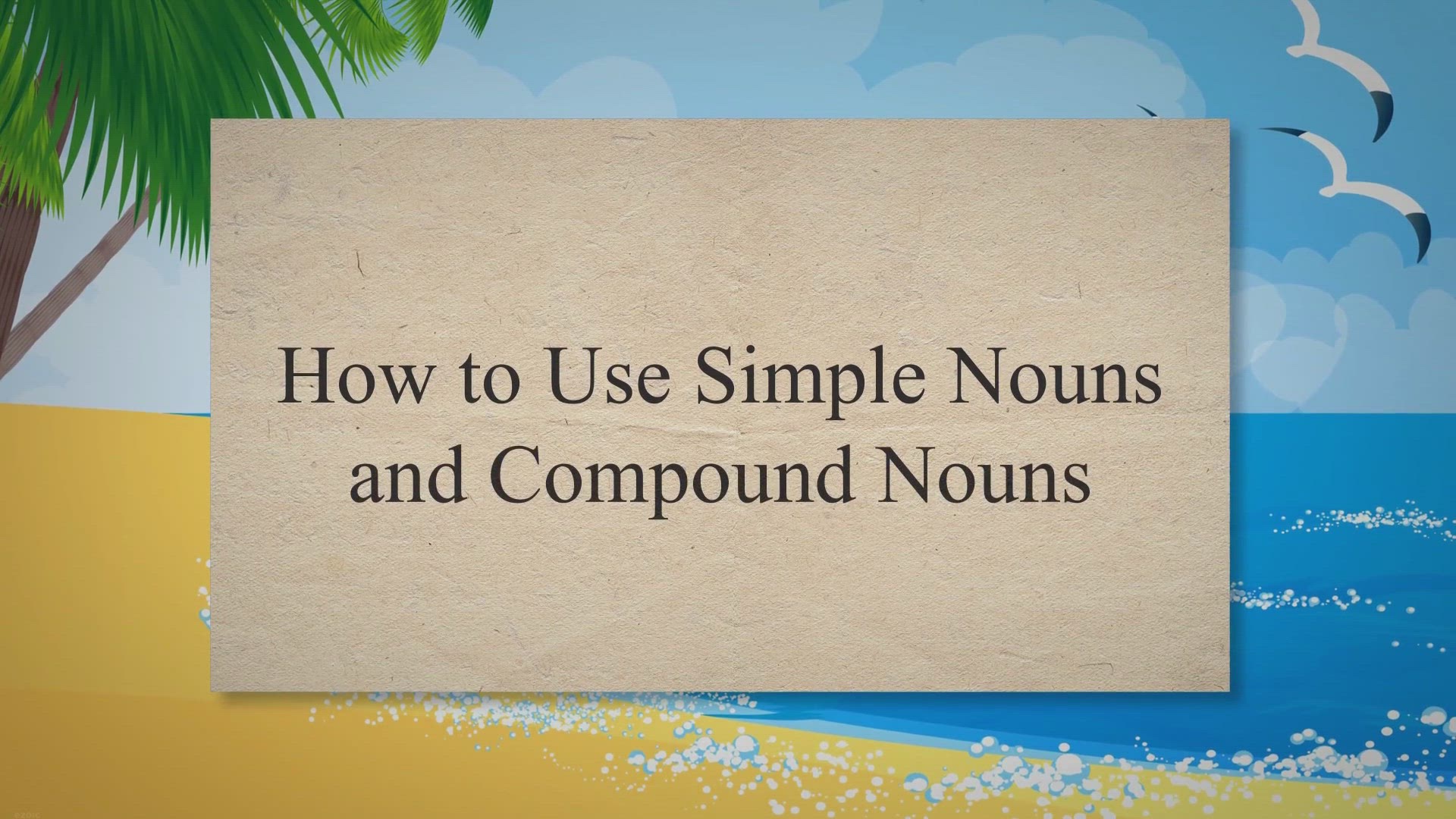
Simple Nouns and Compound Nouns in English
12K views · Jan 29, 2023 englishteststore.net
Simple nouns and compound nouns: How to use, form, and common error when using them
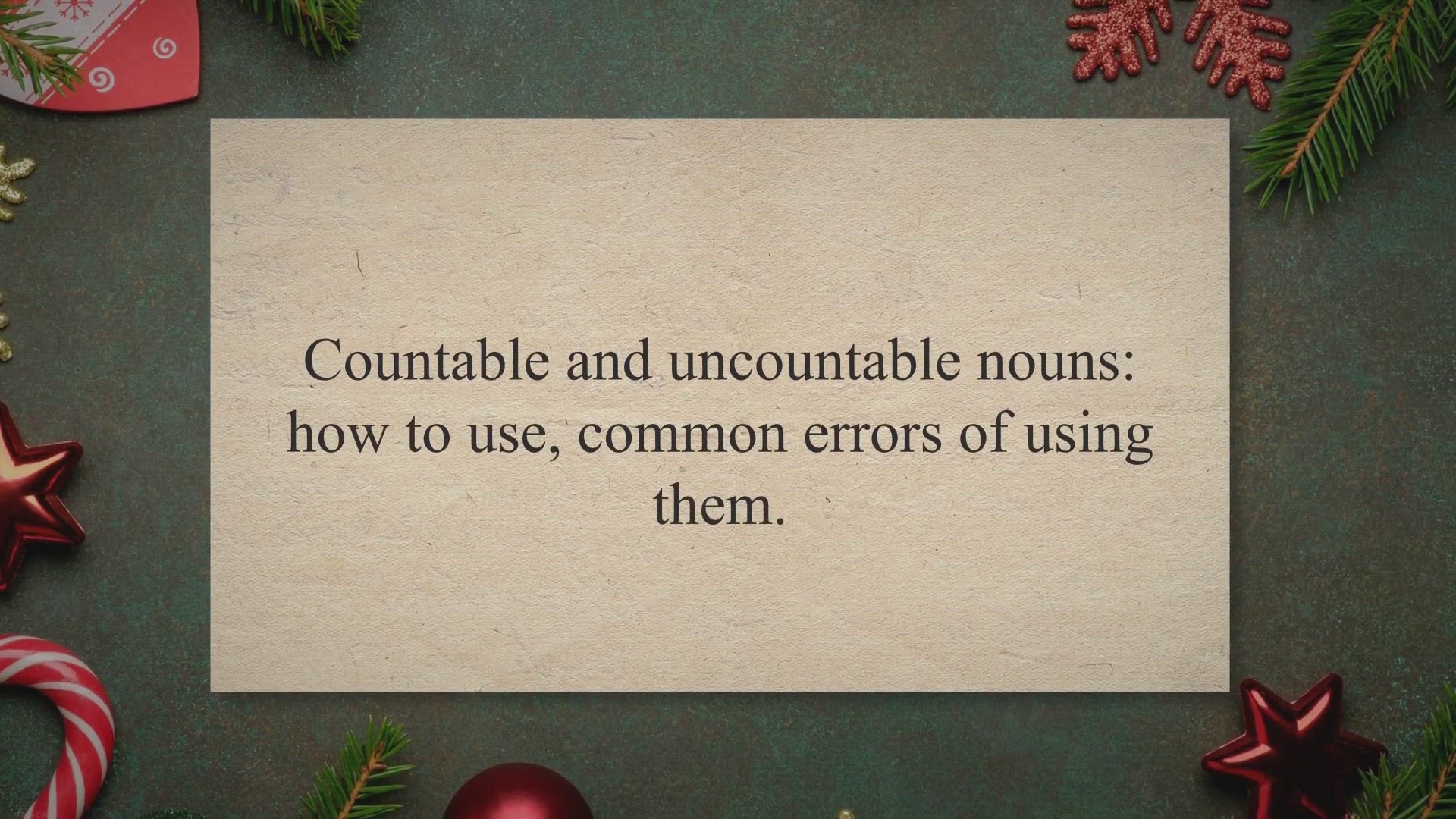
Countable and uncountable nouns: how to use, common errors o...
3K views · Jan 29, 2023 englishteststore.net
How to use countable and uncountable nouns. Some common errors of using them.
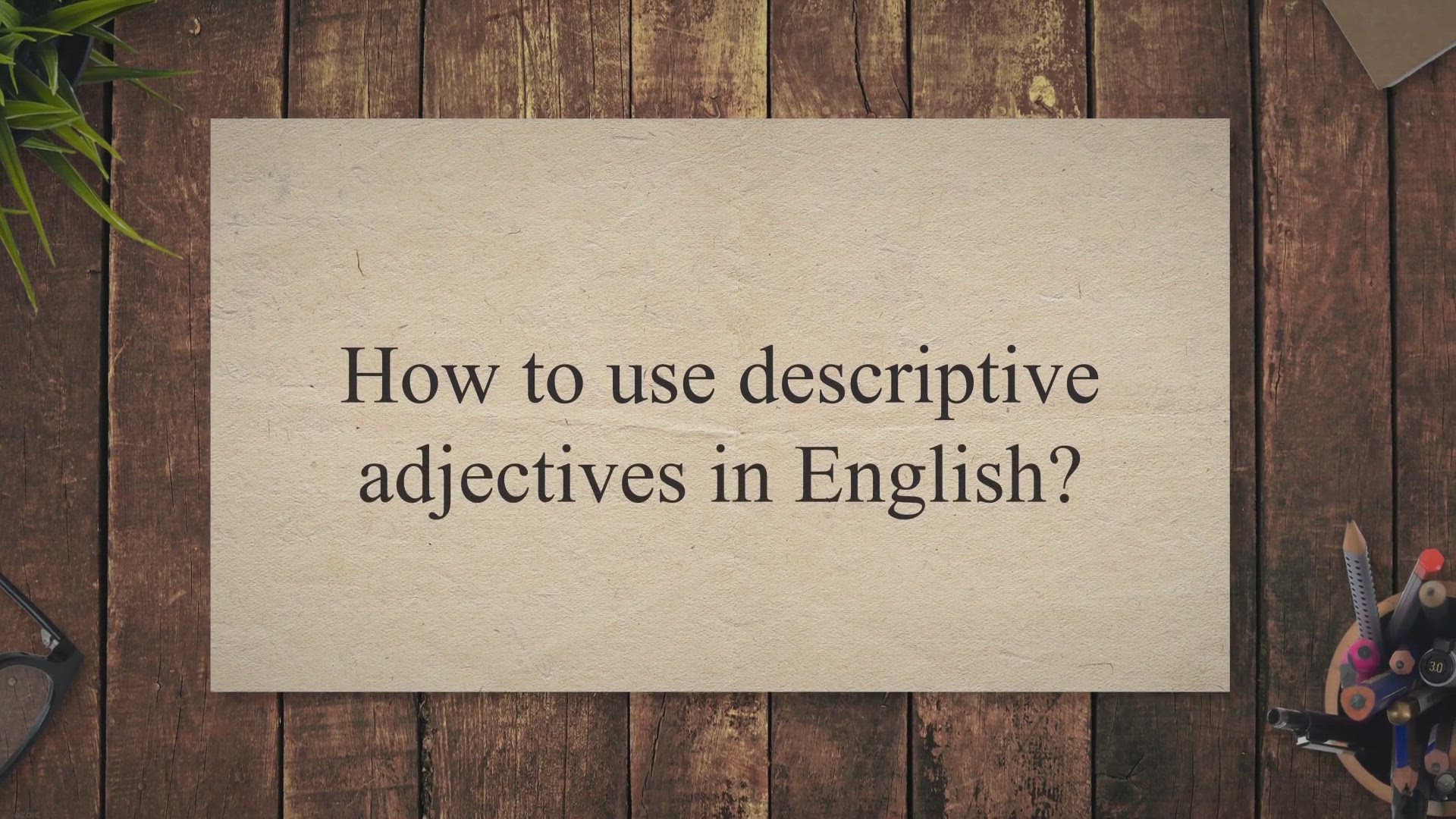
How to use descriptive adjectives in English?
24K views · Jan 29, 2023 englishteststore.net
How to use descriptive adjectives in English?
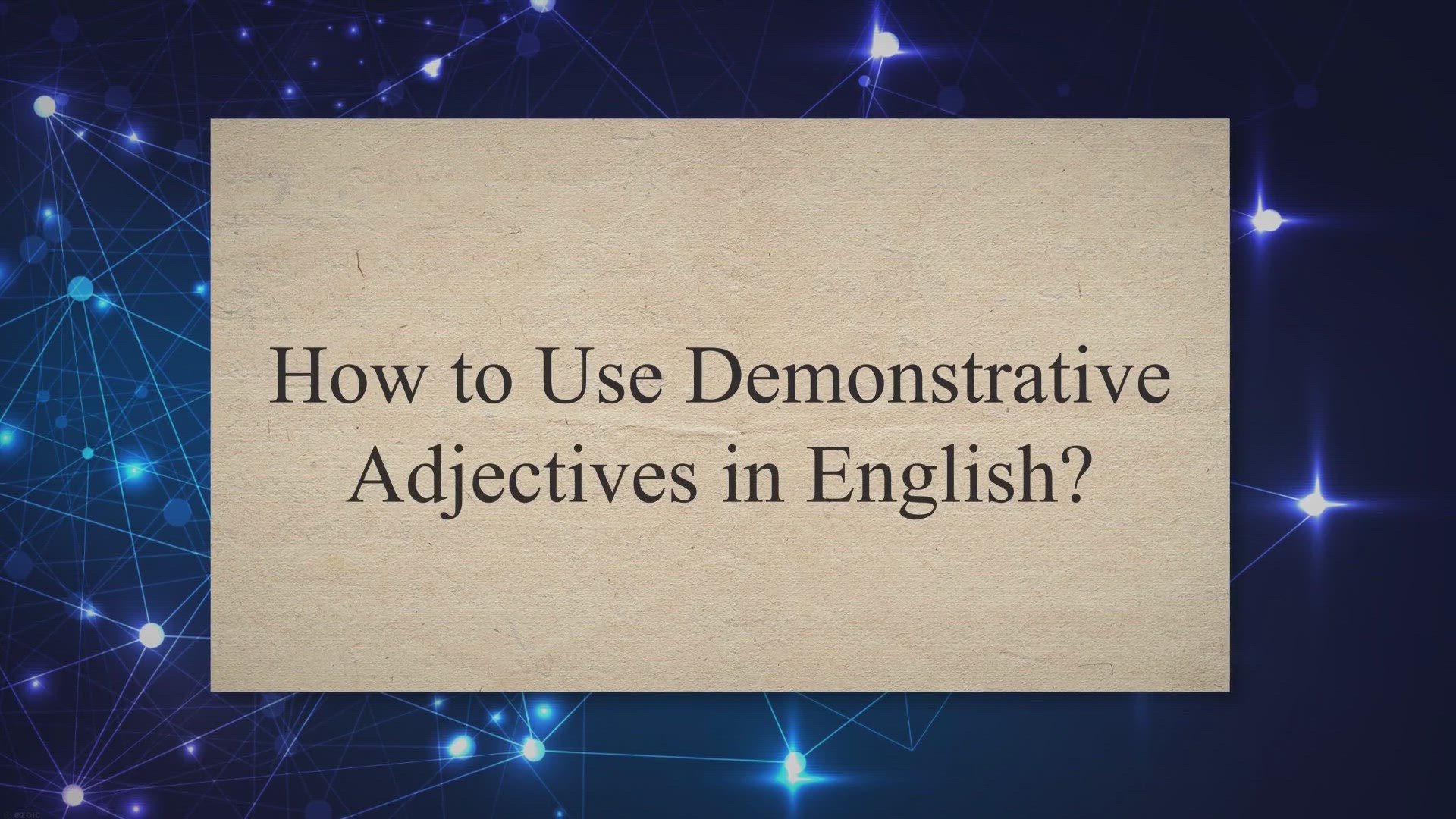
How to Use Demonstrative Adjectives in English?
15K views · Jan 29, 2023 englishteststore.net
How to Use Demonstrative Adjectives in English?
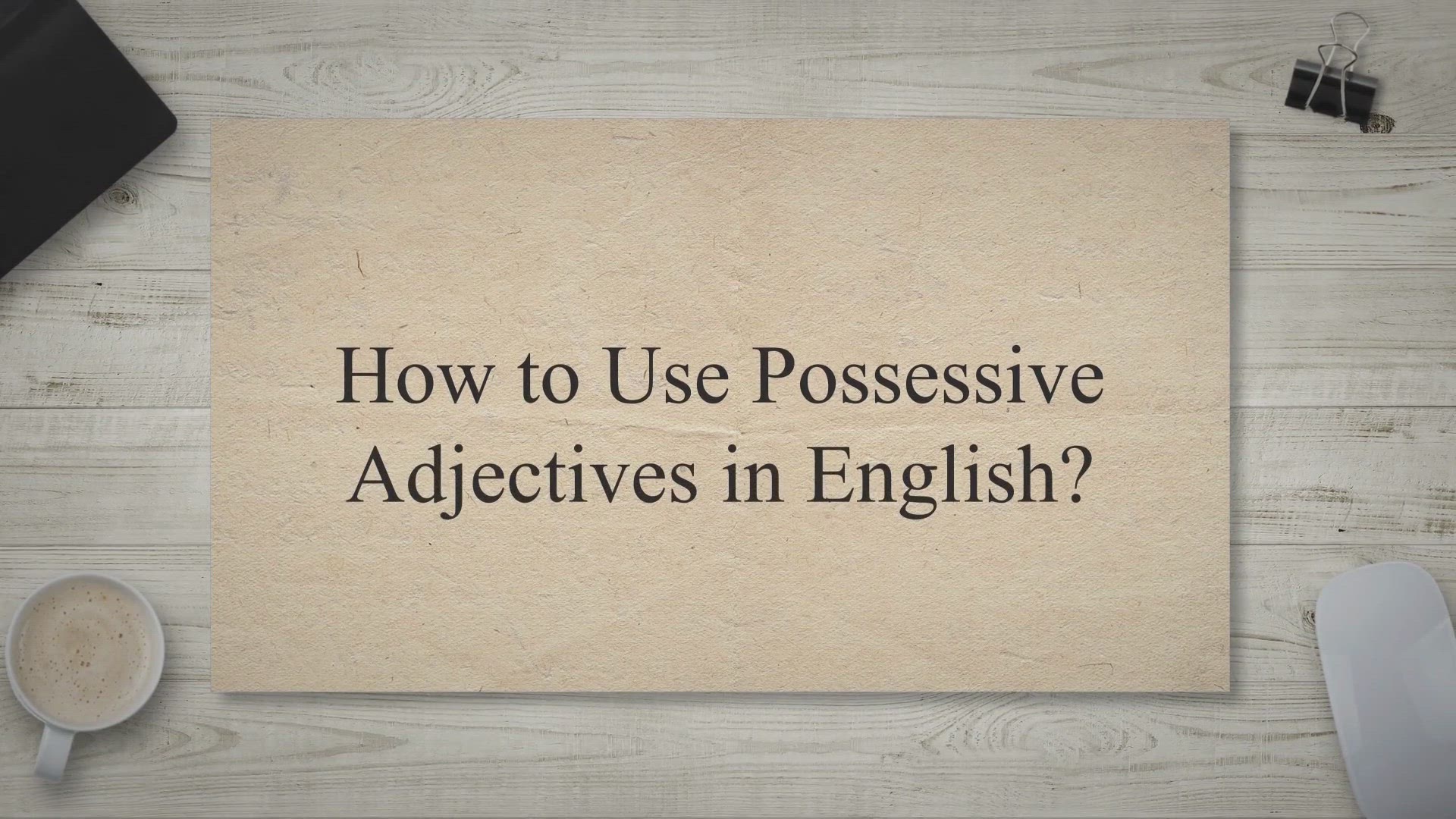
How to Use Possessive Adjectives in English?
54K views · Jan 29, 2023 englishteststore.net
How to Use Possessive Adjectives in English?

How to Use Quantitative Adjectives in English?
14K views · Jan 29, 2023 englishteststore.net
How to Use Quantitative Adjectives in English?
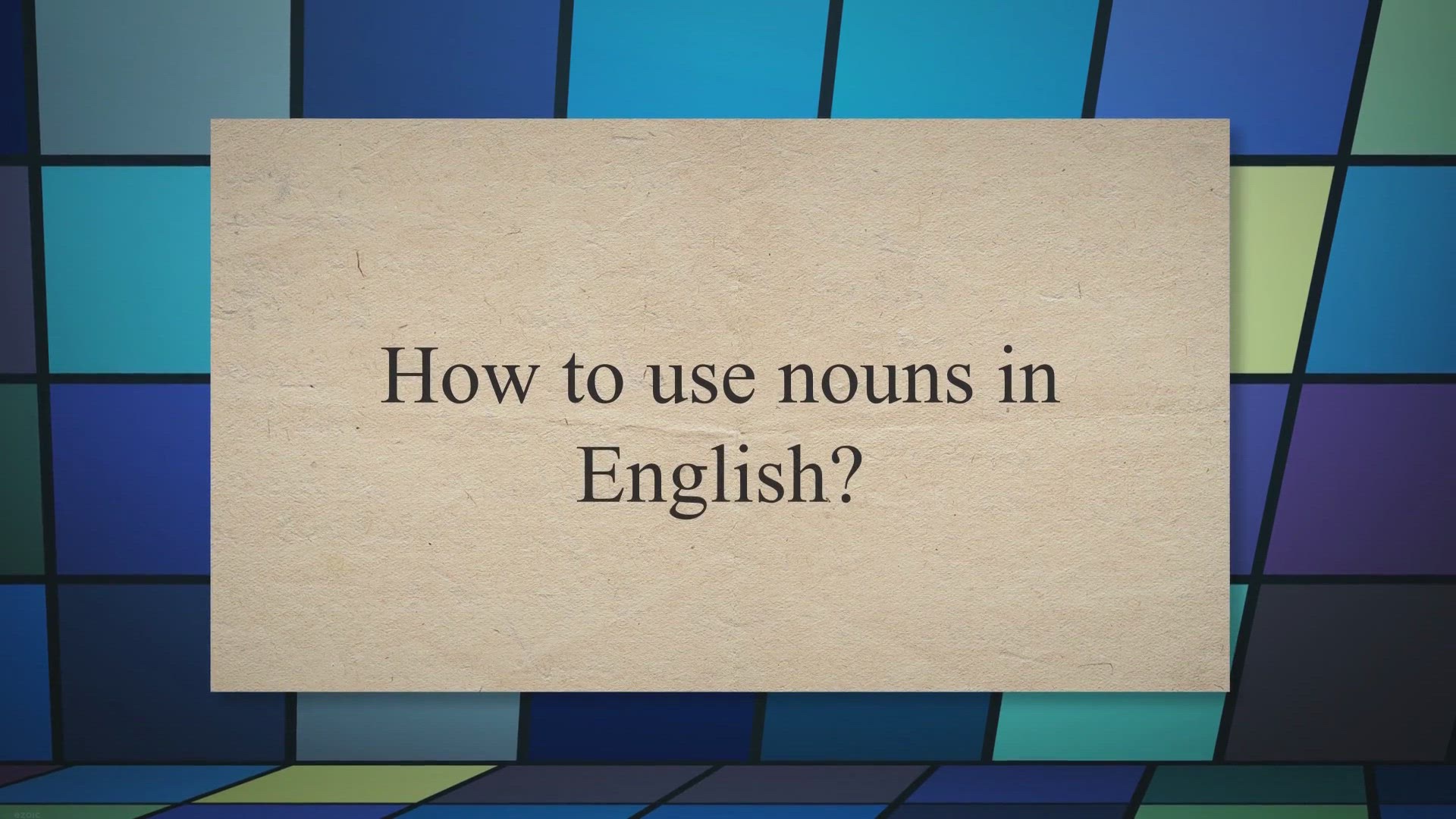
How to use nouns in English?
40K views · Jan 29, 2023 englishteststore.net
How to use nouns in English?
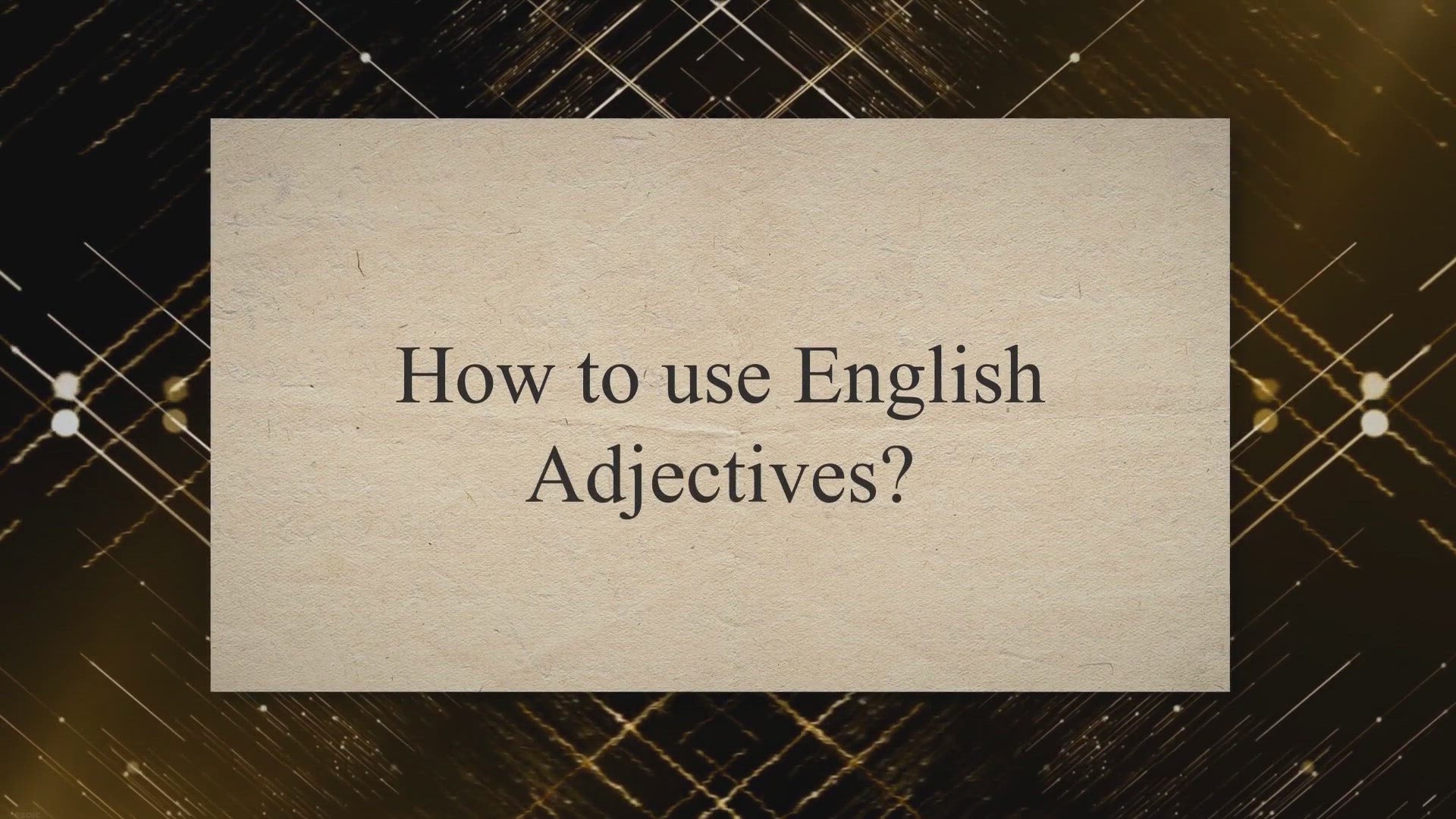
How to use English Adjectives?
48K views · Jan 29, 2023 englishteststore.net
How to use English Adjectives? . What are adjectives?

Simple Nouns and Compound Nouns in English
12K views · Jan 29, 2023 englishteststore.net
Simple nouns and compound nouns: How to use, form, and common error when using them

Countable and uncountable nouns: how to use, common errors o...
3K views · Jan 29, 2023 englishteststore.net
How to use countable and uncountable nouns. Some common errors of using them.

How to use descriptive adjectives in English?
24K views · Jan 29, 2023 englishteststore.net
How to use descriptive adjectives in English?

How to Use Quantitative Adjectives in English?
14K views · Jan 29, 2023 englishteststore.net
How to Use Quantitative Adjectives in English?

How to Use Demonstrative Adjectives in English?
15K views · Jan 29, 2023 englishteststore.net
How to Use Demonstrative Adjectives in English?

How to Use Possessive Adjectives in English?
54K views · Jan 29, 2023 englishteststore.net
How to Use Possessive Adjectives in English?

How to use nouns in English?
40K views · Jan 29, 2023 englishteststore.net
How to use nouns in English?
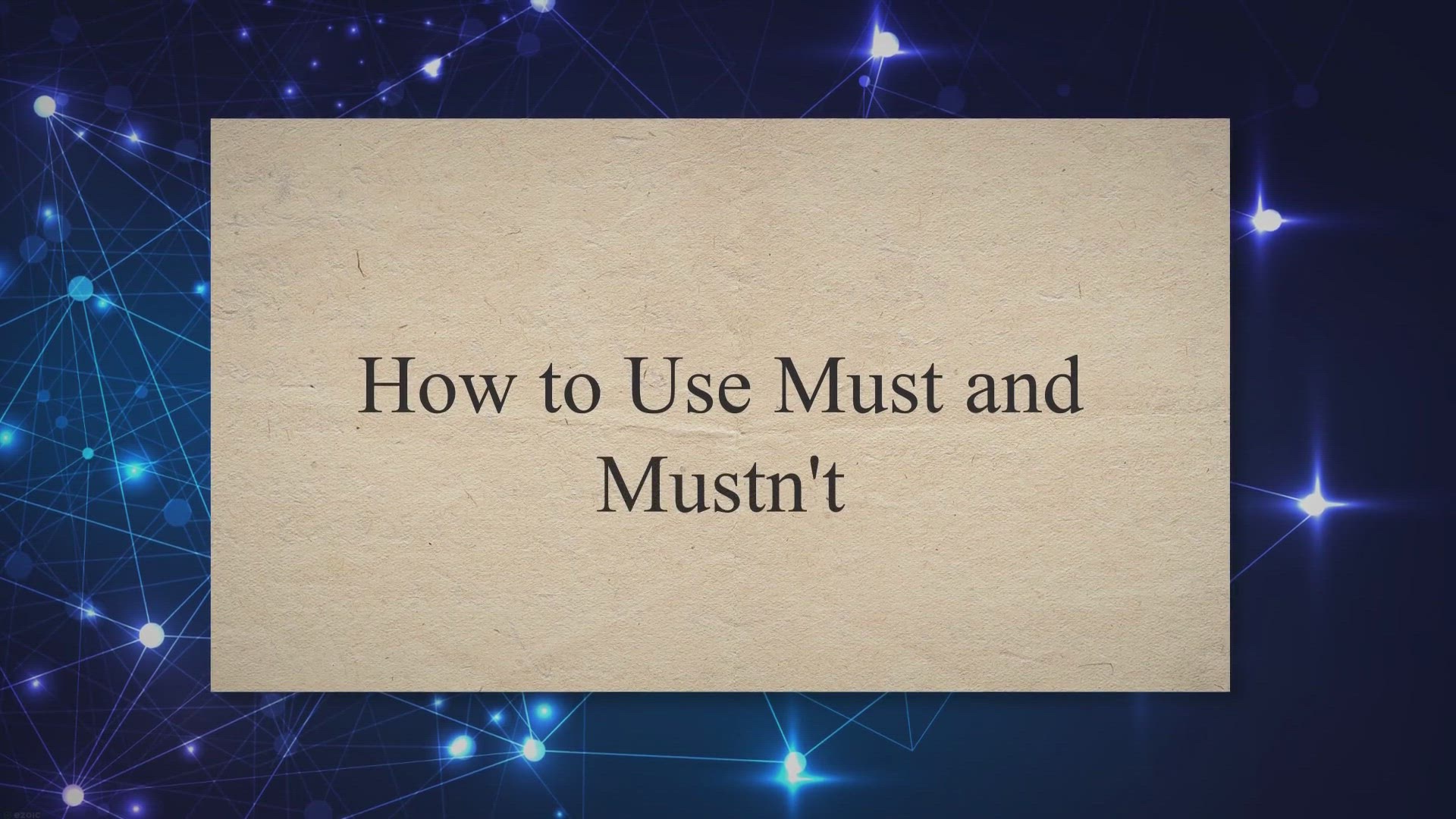
How to Use Must and Mustn't
27K views · Jan 28, 2023 englishteststore.net
An English lesson about how to Use Must and Mustn't
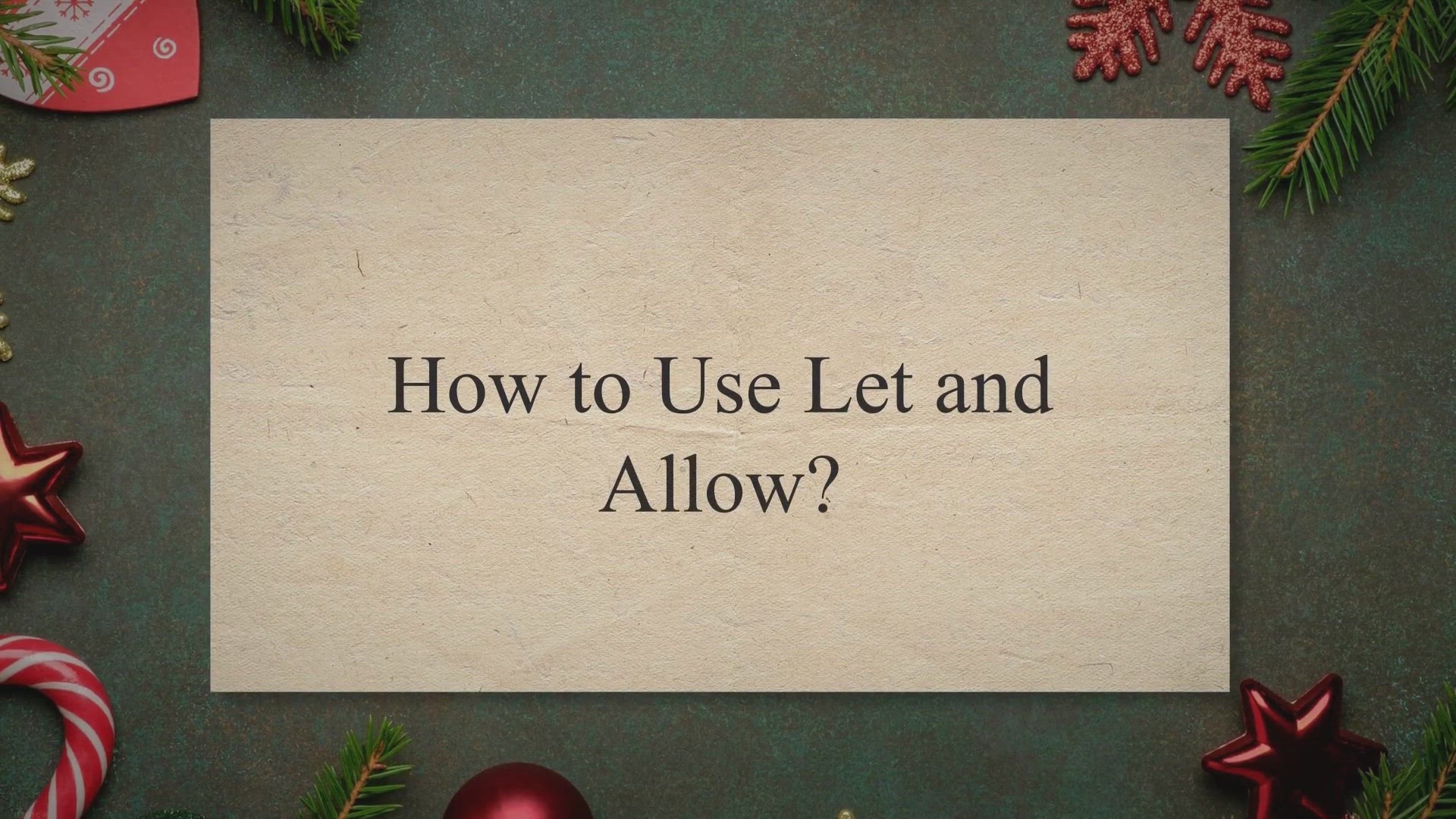
How to Use Let and Allow?
4K views · Jan 28, 2023 englishteststore.net
An English lesson about How to Use Let and Allow.

What is the difference between Either and Neither?
21K views · Jan 27, 2023 englishteststore.net
What is the difference between either and neither?

Grammar lesson: Indirect questions
55K views · Jan 26, 2023 englishteststore.net
An English grammar lesson: Indirect questions. How to use Indirect questions in English.

How to use "have to" and "don't have to"...
21K views · Jan 26, 2023 englishteststore.net
An English grammar lesson about how to use "have to" and "don't have to" in English

Grammar Lesson: Have something done
19K views · Jan 26, 2023 englishteststore.net
How to use structure "Have something done"? This lesson will help.

How to use ed & -ing adjectives?
15K views · Jan 12, 2023 englishteststore.net
How to use ed & -ing adjectives?

Disagreements with auxiliary verbs
17K views · Jan 12, 2023 englishteststore.net
Disagreements with auxiliary verbs lesson

How to use between and among?
4K views · Jan 12, 2023 englishteststore.net
Between and among are both prepositions, how to use between and among?

What's the difference between because and because of?
16K views · Jan 12, 2023 englishteststore.net
What's the difference between because, and because of? Let's learn together.

Agreements with auxiliary verbs
6K views · Jan 7, 2023 englishteststore.net
Agreements with auxiliary verbs lesson with examples. How to use them? Let's see

For and Since
3K views · Jan 6, 2023 englishteststore.net
How to use For and Since, let's listen to the lesson.

Uncountable Nouns
6K views · Jan 6, 2023 englishteststore.net
Uncountable Nouns. Most nouns are either countable, or uncountable, and its important not to get them mixed up. With countable nouns, you can use numbers and plurals, so Anna could say.

Past Continuous Passive
8K views · Jan 5, 2023 englishteststore.net
Past Continuous Passive. How do we make a passive continuous sentence? Lets look at the active form first.

Simple Passives
4K views · Jan 4, 2023 englishteststore.net
Simple Passives. Whats the difference between active and passive simple tense sentences. Well, an active sentence has a subject, verb and object - in that order.

Going to
10K views · Jan 4, 2023 englishteststore.net
An English lesson of how to use "going to" tense

Will & going to
12K views · Jan 4, 2023 englishteststore.net
Will and going to. Today we’re looking at and contrasting two ways to talk about future plans, using ‘going to’ and ‘will’. In an earlier programme, we saw that ‘going to’ can be used, to talk about your intentions, or decisions for the future.

Future plans
66K views · Jan 4, 2023 englishteststore.net
How to use Future plans tense in English

Present perfect continuous
15K views · Jan 4, 2023 englishteststore.net
Present perfect continuous. The present perfect continuous is what we use, when we want to talk about an activity, thats recently stopped, and that has some kind of connection with the present time, now. For example, Diarmuid sees Helen covered in paint now so asks the question:.

Present perfect & past simple
384K views · Jan 4, 2023 englishteststore.net
A lesson about English Present perfect and past simple tense

Present Perfect
8K views · Jan 4, 2023 englishteststore.net
We use the present perfect, when we want to talk about a period of time, that started in the past and continues until now.

Present Continuous
14K views · Jan 4, 2023 englishteststore.net
Present Continuous. We use the present continuous to talk about an activity, thats happening just now, at the moment of speaking.

Zero Article
31K views · Jan 4, 2023 englishteststore.net
When do we use articles or zero article? Let's see the following lesson.

Definite Article
3K views · Jan 4, 2023 englishteststore.net
Today we are going to learn about the definite article "the".

Indefinite Articles
25K views · Jan 4, 2023 englishteststore.net
An English grammar lesson about Indefinite Articles

English Articles - A, An, The
41K views · Dec 30, 2022 englishteststore.net
English Articles. Today we're looking at articles. - are the words a, an and the. .
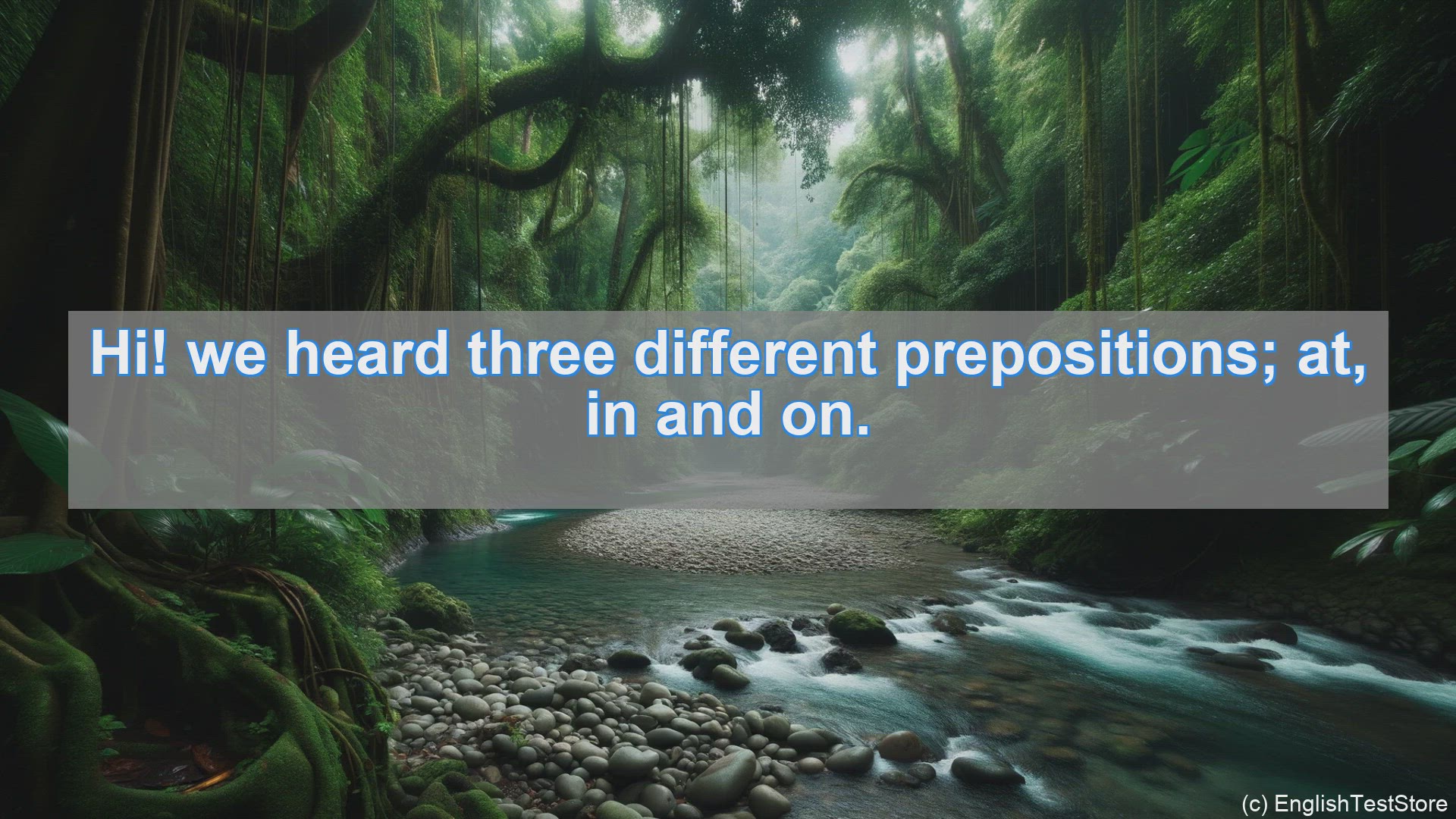
English grammar rules: Time prepositions
2K views · Oct 22, 2023 englishteststore.net
English grammar rules: Time prepositions Hi! we heard three different prepositions; at, in and on. We use these prepositions when we're talking about time but we use each one with different time expressions. Example: In the morning, at 3 o'clock. In 2004. At midnight, on Christmas Day. In December. We use 'at' for times of the day. At half past 7, at midnight, at sunset at breakfast time. At 3 o'clock At midnight We use 'on' for days and dates. On the 5th of June, on Tuesdays, on Saturday morning. On Christmas day. We use 'in' for longer periods of time like months, years, seasons. In April, in 1987, in the winter of '76. In 2004 In December Finally, there are some time expressions that don't use any prepositions at all. Words like 'next', 'last', 'today', 'tomorrow' or 'yesterday'. Next Christmas we're going on a cruise.

English grammar rules: Unless
1K views · Oct 22, 2023 englishteststore.net
English grammar rules: Unless Peter: Unless we're there at 8 o'clock we won't get anything to eat! Unless is followed by a subject and verb, like this: Peter: Unless we are there at 8 o'clock… Unless means only if or except if. The second part of the sentence gives the possible result. Peter and Jane will get something to eat only if they arrive before 8. Listen again: Peter: Unless we're there at 8 o'clock we won't get anything to eat! Here's another example: Peter: We'll go by bus unless Jane wants to take a taxi. They will go by bus except if Jane wants to take a taxi. Note that unless is used with a present tense,neven when it has a future meaning. Here's another example: Jane: I'm not going to dance unless you ask me. Jane is only going to dance if Peter asks her.nBe careful with positives and negatives. Listen: Peter I'll go by car unless it's a long way Jane I won't go by car unless it's a long way In the first one, Peter will go by car, except if it's a long way, in which case he'll fly, or take the train or something. In the second one, Jane will go by car only if it's a long way. If it's a short distance, she'll fly or take the train. Listen again: Peter I'll go by car unless it's a long way Jane I won't go by car unless it's a long way To recap, 'unless' with a subject and verb means 'only if' or 'except if' in positive and negative sentences. The other part of the sentence gives the possible result.
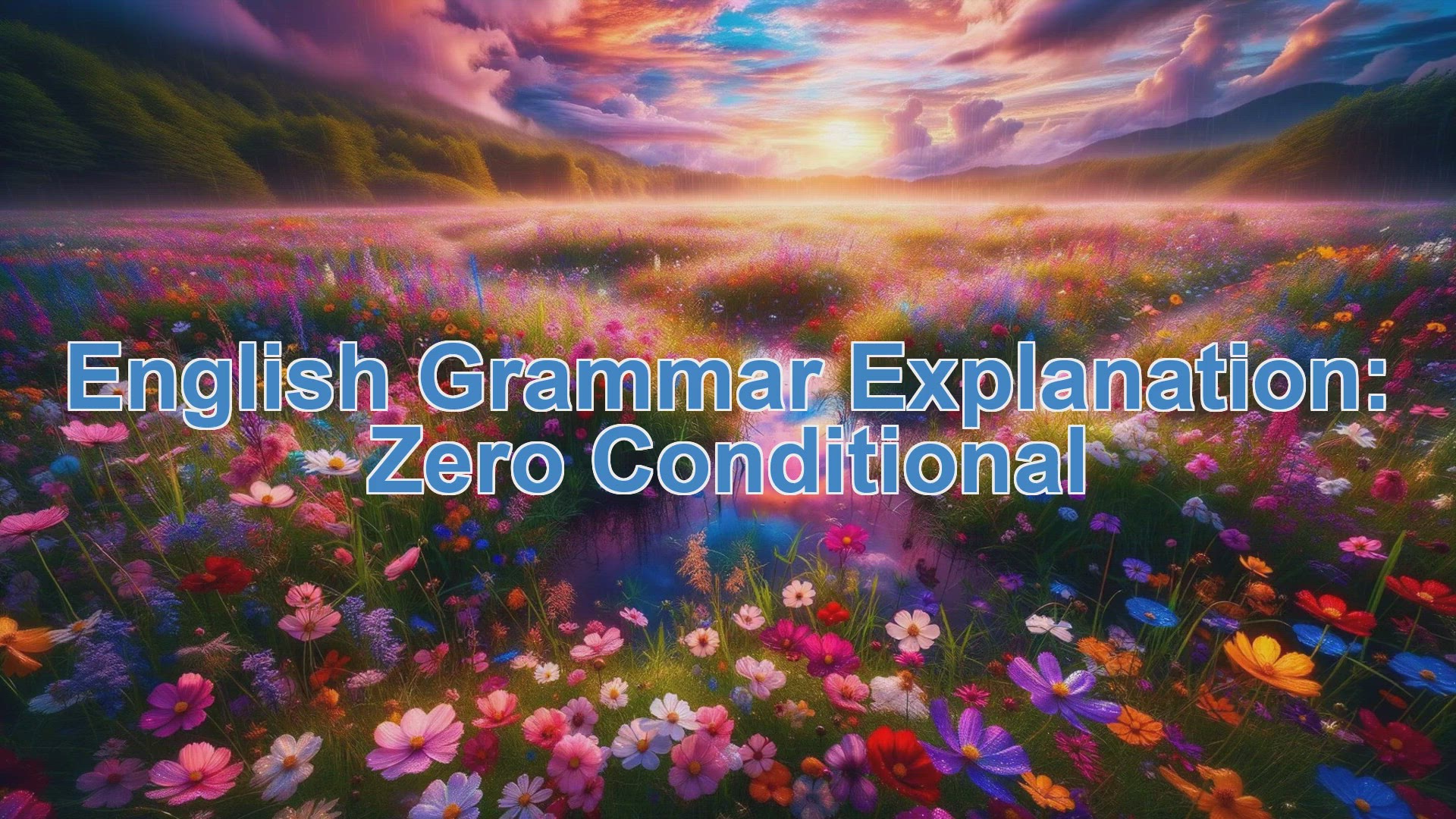
English Grammar Explanation: Zero conditional
3K views · Oct 22, 2023 englishteststore.net
English Grammar Explanation: Zero conditional When we want to talk about a possible or imaginary situation (a condition) and the consequences of it (the result), we can use a structure called 'the zero conditional'. In this structure we're talking about every time a particular condition happens, the result is always the same. In our example, every time someone sends Kate an email, she writes back immediately. So the condition (that's the 'if' part) is that someone emails her and the result (what happens) is that she always writes a reply at once. Listen again: Neil: If someone emails her, she replies straight away. Every time she doesn't answer the phone, her phone machine takes a message for her. Here the condition is that she isn't in her office, and the result is that her machine always takes a message. Listen again: Neil : If she doesn't answer, the machine takes a message. We make the zero conditional with 'If' followed by a present simple verb, Neil: If someone emails her, followed by another verb in the present simple. Neil: she replies straight away. In the zero conditional examples we heard today, we've used 'if' but you can also use 'when' and it has exactly the same meaning. Neil: When someone emails her, she replies straight away. So, to recap then: when we want to talk about a possible situation (where something might or might not happen) and the consequences of it (what will always happen as a result), we use 'the zero conditional'. And we make it with 'If' or 'When' followed by the present simple, followed by another present simple verb.

Grammar Explanation: To, for, so that
2K views · Oct 22, 2023 englishteststore.net
Grammar Explanation: To, for, so that In English, when we want to talk about purpose, or the reason why we do things, we can use to, we can use for and we can use so that. Firstly we can use for with an –ing verb. Here's Jane: Jane: I'm bringing some pots and pans for cooking… She uses for with an -ing verb to say why she's bringing the pots and pans. Listen again: Jane: I'm bringing some pots and pans for cooking Secondly, we can use an infinitive with 'to' Jane: we've got some water to make tea… In this sentence, she uses an infinitive – to make – to say why they are taking the water. Listen again: Jane: we've got some water to make tea A third way to talk about reason or purpose is with so that. Here's Jane: Jane: I'm taking some extra blankets so that we don't get cold. Did you get it? So that is followed by a subject - we - and verb – don't get – to tell us why she's taking the extra blankets. Ok, let's recap. To talk about reason or purpose, we can use for with an -ing verb for objects, or for actions, we can either use to with an infinitive or so that with a subject and verb.

Grammar Explanation: Used to and didn't use to
3K views · Oct 22, 2023 englishteststore.net
Grammar Explanation: Used to and didn't use to When we want to talk about the past and things that we did regularly, things that were habits, we say "used to" followed by the base form of the verb, which is the infinitive without ‘to'. That's ‘used' used to. Listen to Peter: Peter: I used to smoke 20 a day. By saying "used to" Peter is telling us about the past, about his habit (his smoking) and that he doesn't smoke any more. We use "used to" to talk about discontinued past habits; that's things that we did before but which we don't do now. Listen again: Peter: I used to smoke 20 a day. Jane, on the other hand, told us about something she didn't do when she was younger. Jane: I didn't use to walk anywhere. The negative form is ‘not' + ‘use', that's use, followed by the base form. Listen again: Jane: I didn't use to walk anywhere. So, to recap then: when you want to talk about things you did regularly in the past but which you don't do now, you say "used to" followed by the base form. She used to smoke. They used to eat meat. In the negative, it's "didn't use to" followed by the base form. She didn't use to walk anywhere.

Grammar Explanation Verb, object, to + infinitive
3K views · Oct 22, 2023 englishteststore.net
Grammar Explanation: Verb, object, to + infinitive English reporting verbs like tell, warn, remind and encourage, are often followed by an object and then an infinitive with 'to', like this: Jane: Well, I told him to be nice to everybody I told him to be. Subject and verb – I told, object – him, infinitive with 'to' – to be. Here's another one: Jane: I also reminded him to say thank you to the hostess… Subject and verb - I reminded, object - him, infinitive with 'to' - to say. Now the negative infinitive is made with not, like this: Jane: …and I've warned him not to eat too much cake. I've warned him not to eat. Negative infinitive. Here are some of the verbs which take this pattern: advise, ask, beg, encourage, force, invite, order, permit, persuade, remind, tell, want and warn. It might help to remember that all the verbs on this list are action verbs, and they all need 2 people to make sense. For example, I don't invite myself to do something – I invite someone else. So to recap. Some reporting verbs are followed by an object and then by an infinitive with 'to' – I told you to do it. The negative infinitive is formed with not – I told you not to do it.

English Adverbs: How to form and use in English?
16K views · Oct 24, 2023 englishteststore.net
English Adverbs: Amplifying Meaning and Action Definition of Adverbs Adverbs are versatile words that modify verbs, adjectives, other adverbs, or even whole sentences. They provide additional information about how, when, where, how much, or under what conditions something happens or is the case. How to Form Adverbs While many adverbs have unique forms, a common way to form adverbs is from adjectives: From Adjectives: The most typical form is by adding -ly to an adjective. Example: quick → quickly Example: beautiful → beautifully Exceptions: Not all adverbs are formed with -ly, and not all words ending in -ly are adverbs. Example: well (from the adjective good) Example: fast (same as the adjective) Types of Adverbs Adverbs of Manner: Answer the question "how?" and usually end in -ly. Example: He spoke softly. Example: She sings beautifully. Adverbs of Frequency: Indicate how often something happens. Example: always, often, sometimes, rarely, never Adverbs of Time: Tell us when something happens. Example: now, today, yesterday, soon, later Adverbs of Place: Indicate where something happens. Example: here, there, everywhere, nowhere, somewhere Adverbs of Degree: Modify adjectives or other adverbs, usually by intensifying or reducing their meaning. Example: very, too, quite, almost, absolutely Adverbs of Certainty: Indicate the likelihood of something happening. Example: definitely, probably, possibly, surely Using Adverbs in Sentences The placement of adverbs can vary depending on what the adverb is modifying and the focus of the sentence: Modifying a Verb: Typically, they come after the verb. Example: She runs quickly. Example: He speaks softly. Modifying an Adjective or Another Adverb: They come before the word they're modifying. Example: It's very cold. Example: He runs quite slowly. Adverbs of Frequency: These usually come before the main verb but after the verb 'to be'. Example: She often visits her grandmother. Example: He is always late. Beginning of a Sentence: Some adverbs can be used at the start of a sentence to provide emphasis or to affect the tone. Example: Sometimes, I feel like giving up. Example: Surprisingly, he passed the exam. In conclusion, adverbs play a pivotal role in English, offering nuances to our sentences and enhancing the information given by verbs, adjectives, and other adverbs. Recognizing their forms and understanding their placements can greatly refine one's articulation and comprehension skills.

English Articles: The Definite and Indefinite Guides
7K views · Oct 24, 2023 englishteststore.net
English Articles: The Definite and Indefinite Guides Definition of Articles Articles in English are small, yet essential words that go before nouns and help define them in terms of definiteness or indefiniteness. They act as identifiers, signaling whether we're discussing specific items or items in general. How to Form Articles English articles are unique in their forms and are not derived from other words. They are: a, an, and the Types of Articles Indefinite Articles: "a" and "an" Use "a" before words that begin with a consonant sound. Example: a cat, a dog, a university (because 'university' starts with a 'yu' sound which is consonant-like) Use "an" before words that begin with a vowel sound. Example: an apple, an honest person, an hour (because 'hour' starts with a silent 'h' followed by a vowel sound) Definite Article: "the" Refers to specific nouns which are known to both the speaker and the listener. Example: the sun, the book on the table, the Amazon River How to Use Articles in Sentences With Singular and Plural Nouns: a/an: used only with singular nouns. Example: I saw a movie yesterday. the: used with both singular and plural nouns. Example: She likes the color blue. / She returned the books. With Non-specific and Specific Referents: I want a cookie. (Any cookie) I want the cookie you bought yesterday. (A specific cookie) Cases When We Don't Use Articles With plural and uncountable nouns when speaking about them in general. Children love toys. (Not "The children love the toys" unless referring to specific children or toys) Milk is good for health. (Not "The milk is good for health" unless talking about specific milk) With names of languages. She speaks English. With names of meals. Breakfast is at 8 a.m. With people's names (in most cases). Sarah is coming to the party. With titles combined with names. President Biden is attending the summit. With names of countries (if singular). Germany is in Europe. (But "The United States is in North America") The Difference Among Articles "a/an": Used to indicate one thing that is not specific; the listener may not know exactly which one. "the": Used to indicate something specific; the listener understands which particular item is referred to. In summary, articles are foundational in English grammar, offering clarity about the nouns they precede. While they might seem simple, mastering their use can significantly enhance clarity and precision in communication.

English Plural Nouns: A Comprehensive Guide
28K views · Oct 24, 2023 englishteststore.net
English Plural Nouns: A Comprehensive Guide Definition of Plural Nouns A plural noun refers to more than one person, place, thing, idea, or event. In the English language, nouns are typically made plural to indicate a quantity greater than one. For instance, the word "book" in singular form refers to one book, while its plural form "books" refers to more than one book. How to Form Plural Nouns Most Common Rule: Add -s to the singular noun. Example: cat → cats Example: table → tables For nouns ending in -s, -ss, -sh, -ch, -x, or -z, add -es. Example: bus → buses Example: brush → brushes For nouns ending in -y and preceded by a consonant, change the -y to -ies. Example: baby → babies Example: city → cities For nouns ending in -y and preceded by a vowel, simply add -s. Example: toy → toys Example: valley → valleys For some nouns ending in -f or -fe, change the -f to -v and add -es. Example: calf → calves Example: life → lives Types of Plural Nouns Regular Plural Nouns: These nouns follow the general rules mentioned above. Example: car → cars Example: fox → foxes Irregular Plural Nouns: These nouns do not follow standard pluralization rules. Example: man → men Example: child → children Plurals that are the same as the Singular: Some nouns have the same form whether they're singular or plural. Example: sheep → sheep Example: deer → deer Nouns that only exist in Plural Form: There are nouns that are always in plural form, irrespective of the quantity they represent. Example: pants Example: scissors Foreign-origin Plural Nouns: English has borrowed words from other languages, and sometimes it retains the foreign plural form. Example: datum → data (from Latin) Example: cactus → cacti (from Latin) Regular vs. Irregular Plural Nouns Regular Plural Nouns follow the general pluralization rules outlined above. They are predictable and are the most common type of plural nouns in English. Example: dog → dogs Example: box → boxes Irregular Plural Nouns don't adhere to the regular pluralization rules. They might undergo a vowel change, have a unique ending, or might not change at all. Example: goose → geese Example: foot → feet In summary, plural nouns in English have various rules and exceptions. Familiarity with regular pluralization rules will help in most cases, but it's also essential to recognize and memorize the irregular plurals for accurate communication.
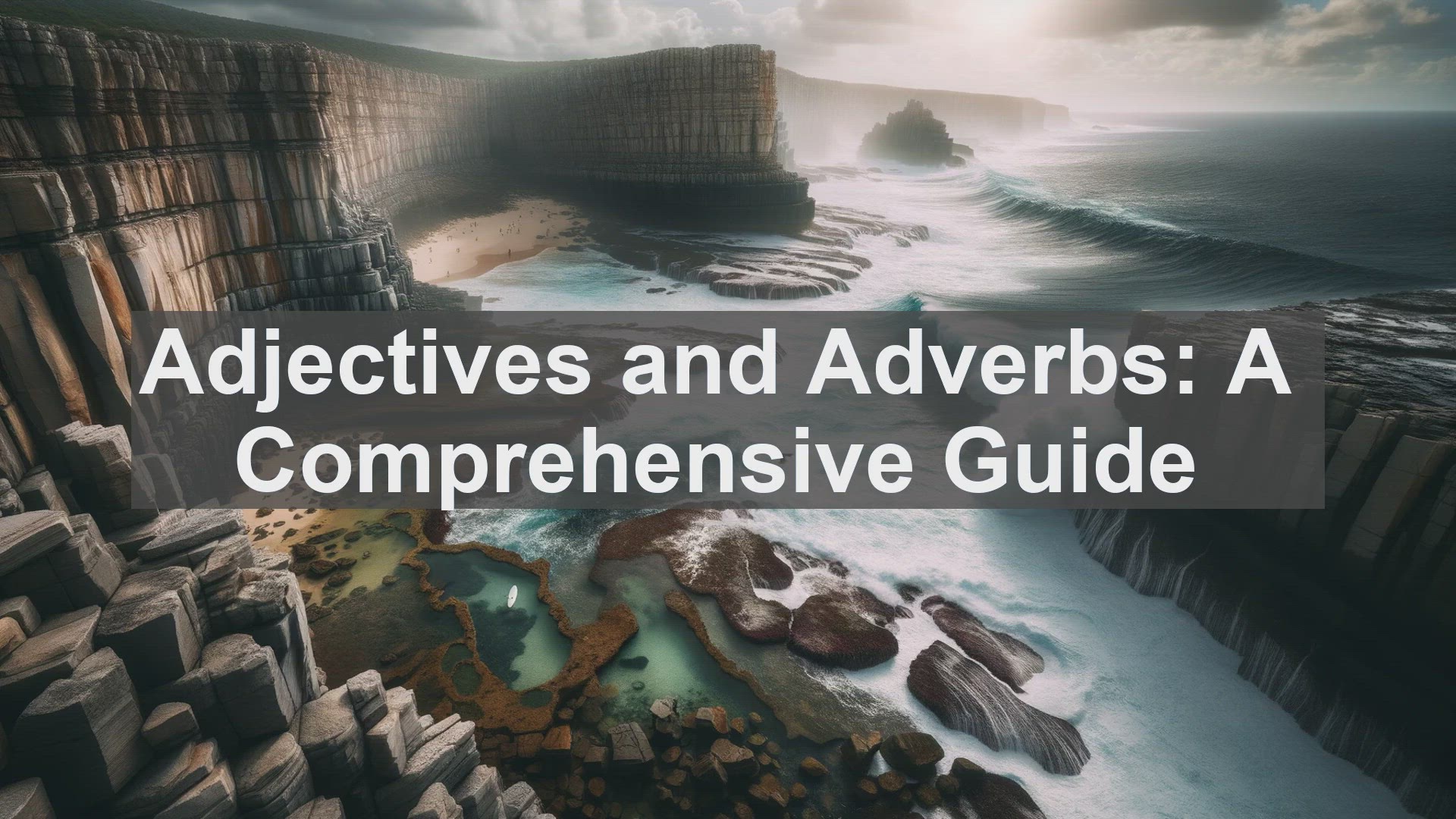
Adjectives and Adverbs: A Comprehensive Guide
2K views · Oct 27, 2023 englishteststore.net
Practice Adjectives and Adverbs https://englishteststore.net/index.php?option=com_content&view=article&id=90&Itemid=455 Adjectives and Adverbs: A Comprehensive Guide Navigating the waters of English grammar requires a solid understanding of various parts of speech, among which adjectives and adverbs stand out. Let’s delve into these two grammatical elements in detail. 1. Definition of Adjectives and Adverbs: Adjectives: Words that describe or modify nouns and pronouns. They give information about size, color, type, number, or other characteristics. Adverbs: Words that modify verbs, adjectives, and other adverbs. They typically provide information about how, when, where, how often, or to what degree an action is performed. 2. How to Form Adjectives and Adverbs: Adjectives: Often intrinsic and don't usually form from other parts of speech. Examples: tall, red, happy, soft. Adverbs: Many adverbs are formed by adding "-ly" to an adjective. Examples: - quick (adjective) → quickly (adverb) - graceful (adjective) → gracefully (adverb) 3. Types of Adjectives and Adverbs: Adjectives: - Descriptive Adjectives: Describe qualities (e.g., blue, soft, loud). - Quantitative Adjectives: Indicate quantity (e.g., some, many, few). - Demonstrative Adjectives: Point out nouns (e.g., this, that, these). Adverbs: - Frequency Adverbs: Indicate how often something happens (e.g., always, sometimes, never). - Place Adverbs: Indicate position or direction (e.g., here, there, everywhere). - Manner Adverbs: Describe how an action is performed (e.g., slowly, carefully). 4. Using Adjectives and Adverbs in Sentences: Adjectives: - The green apple is ripe. - She is happy. Adverbs: - She sings beautifully. - I rarely eat sweets. 5. Cases Where Adjectives and Adverbs Shouldn't Be Used: Sometimes, the presence of an adjective or adverb can be redundant or unnecessary. Examples: - Incorrect: The summit was very unique. Correct: The summit was unique. - Incorrect: She smiled happily in a happy manner. Correct: She smiled happily. 6. Difference Among Adjectives and Adverbs: While both modify, the key difference is in what they modify. - Adjectives modify nouns and pronouns. Example: A loud noise. - Adverbs modify verbs, adjectives, and other adverbs. Example: He speaks loudly. 7. Regular and Irregular Adjectives and Adverbs: Regular Adverbs: Formed by adding "-ly" to the adjective. Examples: - clear (adjective) → clearly (adverb) - precise (adjective) → precisely (adverb) Irregular Adverbs: Do not follow the regular pattern. Examples: - good (adjective) → well (adverb) - fast (adjective) → fast (adverb)
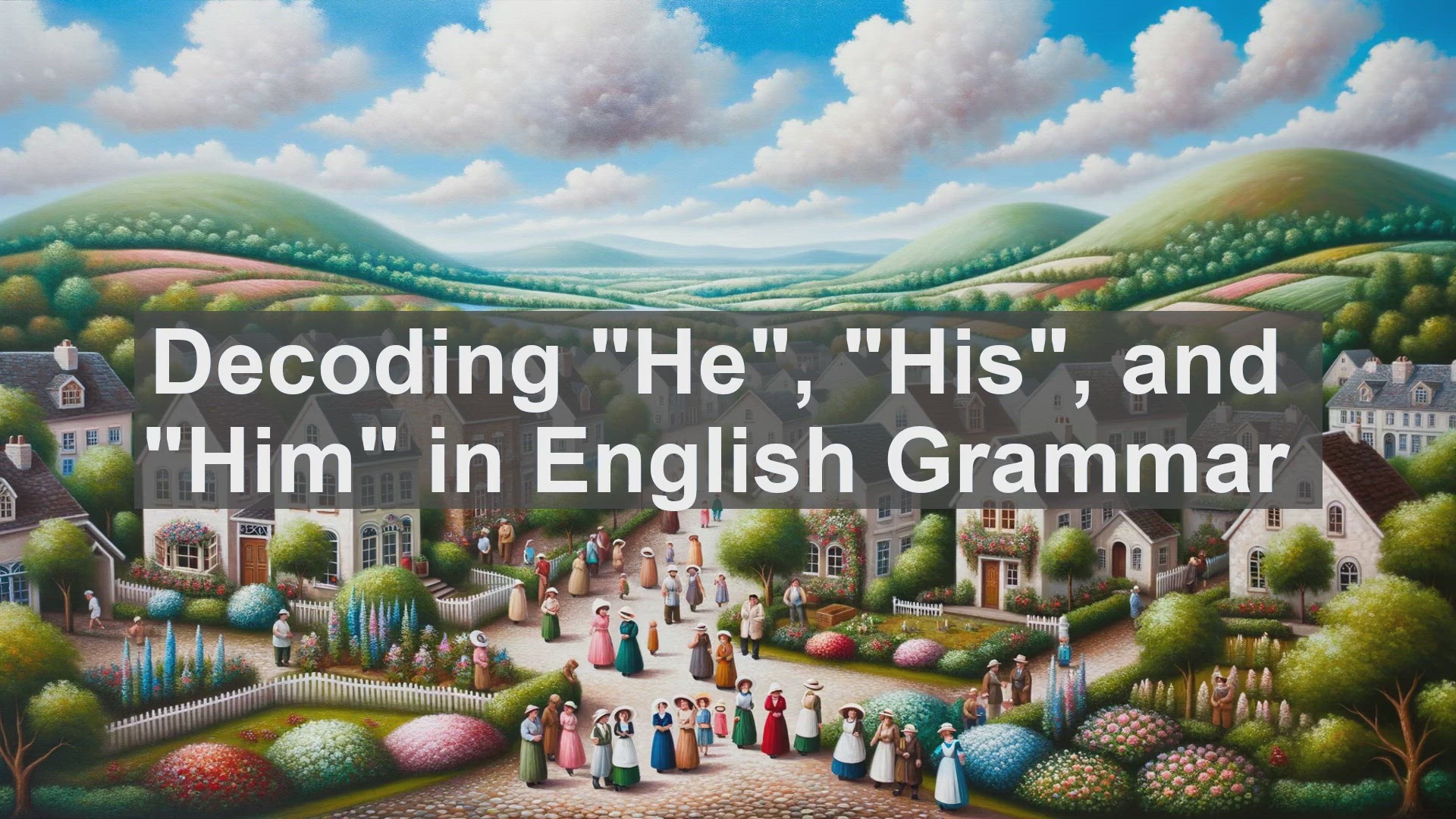
Decoding He His and Him in English Grammar
1K views · Oct 29, 2023 englishteststore.net
Practice quiz Decoding "He", "His", and "Him" in English Grammar When discussing third-person singular male references in English, "he", "his", and "him" play a pivotal role. They form the core of how we address or discuss a male individual. This article provides a concise exploration of these three pronouns. 1. What are "He", "His", and "Him"? - He: A subject pronoun used to refer to a male person or male animals. Example: He is a doctor. - His: A possessive adjective or pronoun that indicates ownership or relation. As an adjective: That is his car. As a pronoun: The book is his. - Him: An object pronoun referring to a male individual. Example: She gave the ticket to him. 2. What Tense Uses "He", "His", and "Him"? The pronouns "he", "his", and "him" aren't tied down to any specific tense. They can be found across past, present, and future tenses. Examples: - He played soccer yesterday. (Past) - His book is on the table. (Present) - She will meet him tomorrow. (Future) 3. How to Use "He", "His", and "Him" in Sentences: - He: Always functions as a subject. Example: He writes novels. - His: Used to signify possession. As an adjective: His shirt is blue. As a pronoun: This pen is his. - Him: Serves as an object (either direct or indirect). Example: I gave him the key. 4. The Difference Among "He", "His", and "Him": - He: Subject pronoun. Example: He runs fast. - His: Possessive adjective or pronoun. As an adjective: His shoes are new. As a pronoun: The decision was his. - Him: Object pronoun. Example: She called him. 5. Cases Where "He", "His", and "Him" Shouldn't Be Used: - Using "him" as a subject: Incorrect: Him went to the store. Correct: He went to the store. - Using "he" as an object: Incorrect: She gave the book to he. Correct: She gave the book to him. - Using "his" in place of "he" or "him": Incorrect: His is my friend. Correct: He is my friend. In conclusion, "he", "his", and "him" are integral pronouns in the English language when referencing male individuals or animals. Mastery over their correct application ensures clarity and fluency in communication, enhancing one's proficiency in the language.

Deciphering I My Mine and Me in English Grammar
6K views · Oct 29, 2023 englishteststore.net
Practice quiz https://englishteststore.net/index.php?option=com_content&view=article&id=16647:i-my-mine-me-english-test-and-exercise&catid=616&Itemid=382 Deciphering "I", "My", "Mine", and "Me" in English Grammar "I", "my", "mine", and "me" are all personal pronouns related to the speaker. They serve as the foundation of self-reference in English, allowing the speaker to talk about themselves. To navigate the intricacies of English communication, it is essential to understand their distinct roles and applications. 1. What are "I", "My", "Mine", and "Me"? - I: The subject pronoun referring to the person speaking. Example: I am reading a book. - My: A possessive adjective indicating ownership or relation of the speaker. Example: That is my pen. - Mine: A possessive pronoun that denotes something belonging to or associated with the speaker. Example: This book is mine. - Me: An object pronoun used to indicate the person receiving an action or being referred to. Example: She gave the gift to me. 2. What Tense Uses "I", "My", "Mine", and "Me"? The use of these pronouns is not confined to a specific tense. They can be utilized in past, present, and future contexts. Examples: - I visited Paris last year. (Past) - My brother is studying now. (Present) - She will tell me the news tomorrow. (Future) 3. How to Use "I", "My", "Mine", and "Me" in Sentences: - I: Always used as a subject. Example: I like chocolate. - My: Used before a noun to show possession. Example: My dog is friendly. - Mine: Stands alone without a following noun. Example: That car is mine. - Me: Serves as an object, either direct or indirect. Example: They invited me to the party. 4. The Difference Among "I", "My", "Mine", and "Me": - I: Subject pronoun. Example: I will go to the store. - My: Possessive adjective, requires a noun after it. Example: My friend is coming over. - Mine: Possessive pronoun, stands on its own. Example: This is mine. - Me: Object pronoun. Example: Can you help me? 5. Cases Where "I", "My", "Mine", and "Me" Shouldn't Be Used: - Using "I" as an object: Incorrect: He met I at the mall. Correct: He met me at the mall. - Using "me" as a subject: Incorrect: Me and her are going to the movies. Correct: She and I are going to the movies. - Using "my" without a noun: Incorrect: That is my. Correct: That is mine. - Using "mine" with a noun: Incorrect: That is mine book. Correct: That is my book. In summary, "I", "my", "mine", and "me" are pivotal pronouns that facilitate self-reference in English. As with many linguistic elements, mastering their correct use is a blend of continuous practice and keen observation. It aids in ensuring that one's speech and writing remain clear, accurate, and grammatically sound.

His Her and Its in English Grammar
990 views · Oct 29, 2023 englishteststore.net
Practice quiz https://englishteststore.net/index.php?option=com_content&view=article&id=16638:his-her-its-english-test&catid=616&Itemid=382 Delving into "His", "Her", and "Its" in English Grammar In the English language, "his", "her", and "its" are possessive adjectives that convey ownership or a relation to a subsequent noun. Their correct application is pivotal for ensuring clarity and precision in both spoken and written communication. 1. What are "His", "Her", and "Its"? "His", "her", and "its" are possessive adjectives used to indicate ownership or a relationship to a noun that follows them. Examples: - That is his backpack. - She forgot her umbrella. - The cat licked its paw. 2. What Tense Uses "His", "Her", and "Its"? These possessive adjectives are not confined to any specific tense. Their primary role is to demonstrate possession or association, irrespective of time. Examples: - He lost his wallet last week. (Past) - Her office is on the second floor. (Present) - The company will launch its new product next month. (Future) 3. How to Use "His", "Her", and "Its" in Sentences: - His: Used to signify something belongs to or is related to a male individual. Example: His jacket is brown. - Her: Used to show something belongs to or is associated with a female individual. Example: Her book is on the shelf. - Its: Used to indicate possession or relation to a non-human entity or an animal. Example: The tree shed its leaves in autumn. 4. The Difference Among "His", "Her", and "Its": - His: Relates to a male person. Example: His bicycle has a flat tire. - Her: Pertains to a female person. Example: Her painting won an award. - Its: Associated with non-human entities or animals. Example: The robot performed its task efficiently. 5. Cases Where "His", "Her", and "Its" Shouldn't Be Used: - When the possession is already implied: Incorrect: The dog wagged its tail of its. Correct: The dog wagged its tail. - Replacing them with possessive pronouns: Incorrect: This is her dress of her. Correct: This is her dress. or This dress is hers. - Using "its" as a contraction for "it is" or "it has": Incorrect: Its raining outside. Correct: It's raining outside. In summation, "his", "her", and "its" play a vital role in portraying ownership and relationships in English. Their proper usage ensures clarity, thus avoiding potential confusion in communication. For those aiming to enhance their proficiency in the language, a deep understanding of these possessive adjectives is indispensable.

Were and Was: The Past Tense of Be
76K views · Oct 30, 2023 englishteststore.net
Practice quiz https://englishteststore.net/index.php?option=com_content&view=article&id=16623:were-was-english-test&catid=616&Itemid=382 Delving into "Were" and "Was": The Past Tense of "Be" "Were" and "was" are essential components of English grammar, frequently encountered in both written and spoken contexts. As past tense forms of the verb "be", they carry a significant weight in conveying time and state. Let's dive deeper into understanding these verbs. 1. What are "Were" and "Was"? "Were" and "was" are the past tense versions of the verb "be". They're used to describe a state, condition, or identity in the past. Examples: - He was tired yesterday. - They were at the park last weekend. 2. What Tense Uses "Were" and "Was"? Both "were" and "was" are used in the Past Simple Tense to describe situations, states, or conditions that occurred and finished in the past. Examples: - She was a renowned artist in the 90s. - We were students back in 2005. 3. How to Use "Were" and "Was" in Sentences: - Was: Used with first and third person singular pronouns/nouns - "I", "he", "she", "it", or singular nouns like "dog" or "Mary". Example: Mary was late to the party. - Were: Used with second person singular and all plural pronouns/nouns - "you", "we", "they", or plural nouns like "dogs". Example: The dogs were barking loudly. 4. The Difference Among "Were" and "Was": The distinction between these verbs is determined by the subject pronoun or noun they accompany: - Was: Specifically for singular subjects - "I", "he", "she", "it", and singular nouns. Example: The weather was great yesterday. - Were: For plural subjects - "you", "we", "they", and plural nouns. Example: You were at the concert last night. 5. Cases Where "Were" and "Was" Shouldn't Be Used: Even though "were" and "was" are commonplace, there are situations where their usage is inappropriate or redundant: - In the present or future tenses: Incorrect: I was happy tomorrow. Correct: I will be happy tomorrow. - With modal verbs: Incorrect: She was can dance. Correct: She can dance. - Using "was" with plural subjects or "were" with singular subjects: Incorrect: They was hungry. Correct: They were hungry. Incorrect: She were tired. Correct: She was tired. In conclusion, "were" and "was" play a pivotal role in English, allowing us to discuss states and conditions in the past. These verbs, though seemingly straightforward, demand a proper understanding for effective communication. Familiarizing oneself with their correct usage ensures clarity and linguistic accuracy.
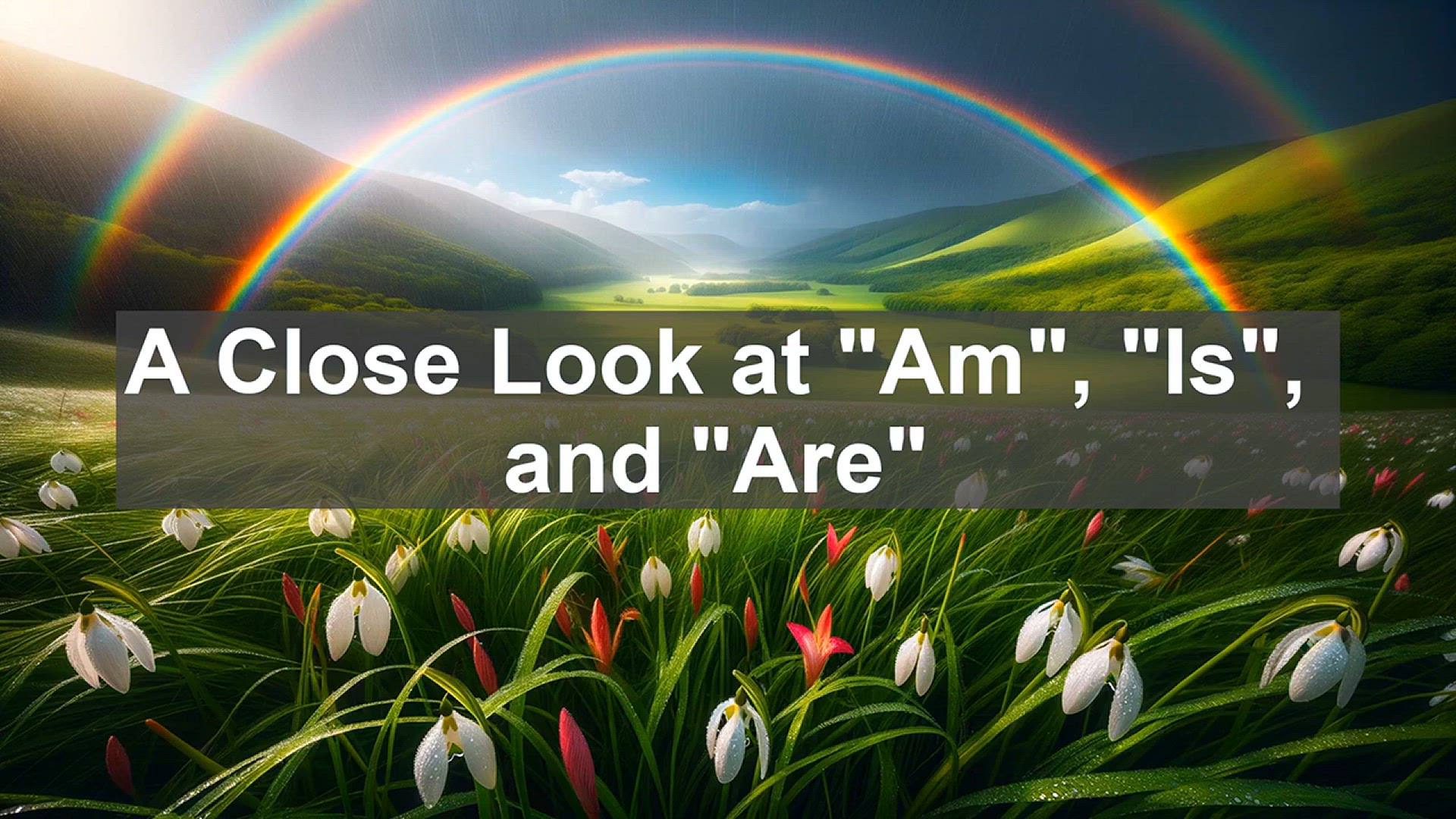
To be verb: Am, Is, and Are - A Close Look
5K views · Oct 30, 2023 englishteststore.net
Practice Am, Is, and Are quiz https://englishteststore.net/index.php?option=com_content&view=article&id=10422&Itemid=465 A Close Look at "Am", "Is", and "Are" The verbs "am", "is", and "are" are core components of the English language, playing a significant role in the construction of sentences. To master the art of English grammar, it’s crucial to have a clear understanding of these verbs. 1. What are "am", "is", and "are"? "Am", "is", and "are" are forms of the verb "be". They're used to indicate a state or condition. Examples: - I am a teacher. - She is my sister. - They are students. 2. What Tense Uses "am", "is", and "are"? These verbs are used in the Present Simple Tense to denote a state, identity, or condition. Examples: - He is a doctor. - We are on vacation. - I am at home. 3. How to Use "am", "is", and "are" in Sentences: - Am: Used with the first person singular, "I". Example: I am excited about the trip. - Is: Used with third person singular nouns and pronouns like "he", "she", and "it". Example: It is raining. - Are: Used with first and second person plural and third person plural pronouns like "we", "you", and "they". It is also used with plural nouns. Example: You are early. 4. The Difference Among "am", "is", and "are": The primary distinction among these verbs is based on the subject pronoun or noun they are used with: - Am: Exclusively for "I". Example: I am ready. - Is: For singular third-person pronouns/nouns ("he", "she", "it" or singular nouns like "dog", "Anna"). Example: Anna is studying. - Are: For plural pronouns/nouns ("we", "they", "you", or plural nouns like "dogs"). Example: Dogs are loyal. 5. Cases Where "am", "is", and "are" Shouldn't Be Used: While these verbs are commonly used, there are cases where they are unnecessary or incorrect: - In imperative sentences: Incorrect: You are listen to me! Correct: Listen to me! - When using modal verbs: Incorrect: I am can swim. Correct: I can swim. - In the present continuous with the verb "thinking": Incorrect: I am thinking it's a good idea. Correct: I think it's a good idea. In summary, "am", "is", and "are" are foundational verbs in the English language. Their primary function is to describe a state or condition in the present tense. While they might seem basic, understanding their correct usage is key to constructing accurate sentences and communicating effectively.

Navigating My and Your in English Grammar
637 views · Nov 10, 2023 englishteststore.net
Practice quiz online https://englishteststore.net/index.php?option=com_content&view=article&id=16637:my-your-english-test&catid=616&Itemid=382 Navigating "My" and "Your" in English Grammar In English, "my" and "your" are possessive adjectives, crucial for expressing ownership or a relationship to something or someone. Understanding their function and appropriate usage can greatly enhance clarity in communication. 1. What are "My" and "Your"? "My" and "Your" are possessive adjectives used to indicate ownership or a relationship to a noun that follows them. Examples: - My phone is on the table. - Is this your book? 2. What Tense Uses "My" and "Your"? Possessive adjectives such as "my" and "your" are not tied to a specific tense. They can be used in past, present, and future contexts, as their function is to show possession rather than indicate time. Examples: - I misplaced my keys yesterday. (Past) - Your appointment is today. (Present) - My flight will be tomorrow. (Future) 3. How to Use "My" and "Your" in Sentences: - My: Used to signify something belongs to or is related to the speaker. Example: My brother works in finance. - Your: Used to indicate something belongs to or is related to the person or people being spoken to. Example: What is your favorite color? 4. The Difference Among "My" and "Your": - My: Expresses ownership or relationship of the speaker. Example: My car is blue. - Your: Indicates ownership or relationship of the person or people being addressed. Example: Is this your umbrella? 5. Cases Where "My" and "Your" Shouldn't Be Used: - When not referring to possession or a relation: Incorrect: I have my eaten the cake. Correct: I have eaten the cake. - When the noun is already implied or understood: Incorrect: I am washing my. Correct: I am washing mine. (Here, "mine" is a possessive pronoun replacing the noun, example, "my car".) - Using them in place of possessive pronouns: Incorrect: This book is my. Correct: This book is mine.
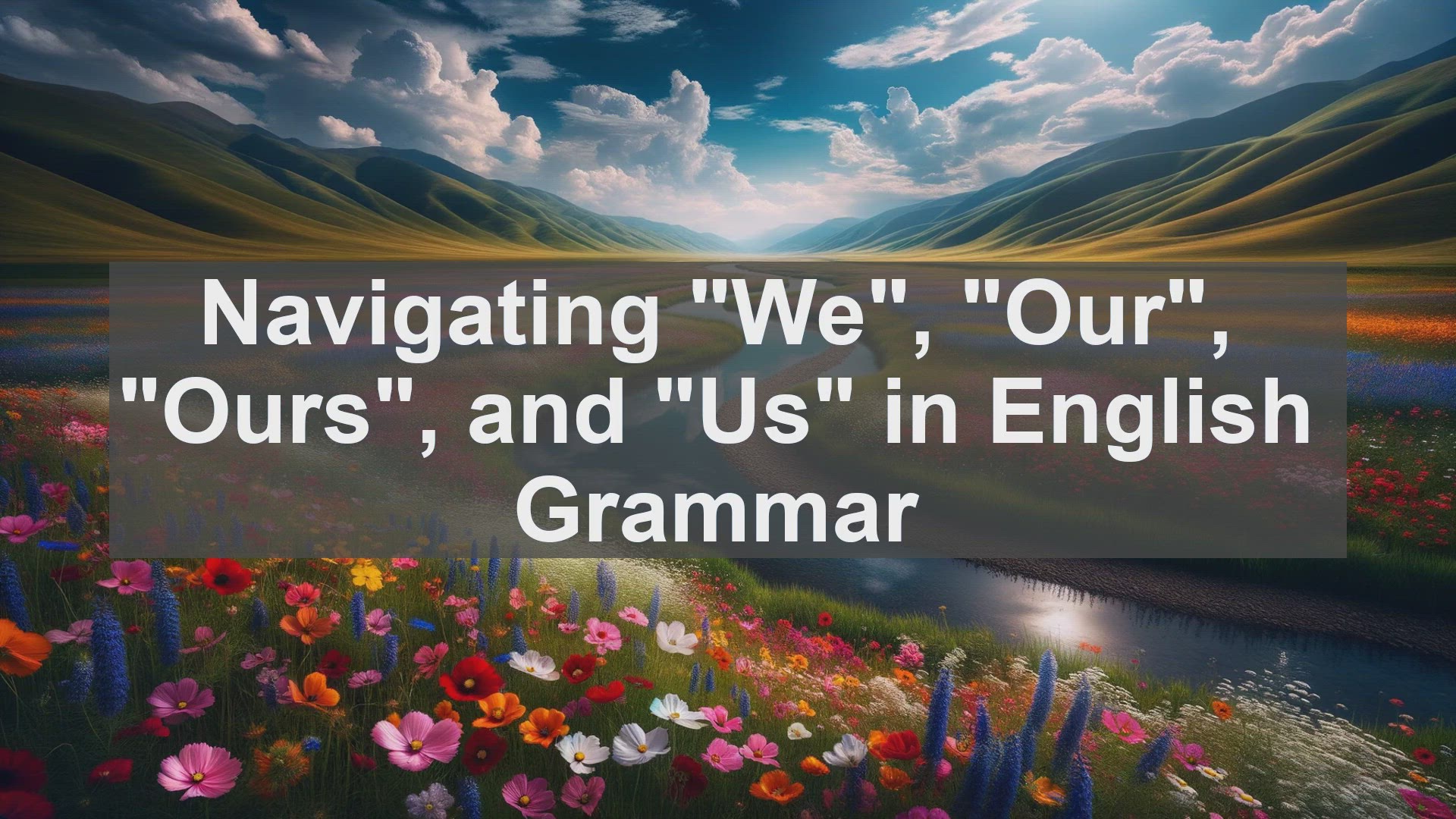
We, Our, Ours, and Us in English Grammar
1K views · Nov 10, 2023 englishteststore.net
Practice quiz online https://englishteststore.net/index.php?option=com_content&view=article&id=16650:we-our-ours-us-english-test-and-exercise&catid=616&Itemid=382 Navigating "We", "Our", "Ours", and "Us" in English Grammar In the English language, when we want to refer to ourselves as part of a group, we resort to the pronouns "we", "our", "ours", and "us". These words help convey the idea of inclusivity and collective identity. This article delves deep into these pronouns and their proper application. 1. What are "We", "Our", "Ours", and "Us"? - We: A subject pronoun that refers to the speaker and one or more other people. Example: We are planning a trip. - Our: A possessive adjective indicating something belongs to or is related to the group that includes the speaker. Example: This is our house. - Ours: A possessive pronoun showing ownership or relation, referring to something owned by or related to the group that includes the speaker. Example: The responsibility is ours. - Us: An object pronoun referring to the speaker and one or more other people. Example: They invited us to the party. 2. What Tense Uses "We", "Our", "Ours", and "Us"? These pronouns are not restricted to any specific tense. They can be employed in sentences that are in past, present, or future tenses. Examples: - We visited the museum last week. (Past) - Our goal is to finish the project by tomorrow. (Present) - They will join us for dinner. (Future) 3. How to Use "We", "Our", "Ours", and "Us" in Sentences: - We: Always functions as a subject. Example: We enjoy playing football. - Our: Denotes possession or relation. Example: Our favorite color is blue. - Ours: Stands alone to indicate possession or relation. Example: The last slice of pizza is ours. - Us: Serves as an object (either direct or indirect). Example: He gave us a gift. 4. The Difference Among "We", "Our", "Ours", and "Us": - We: Subject pronoun. Example: We love to read. - Our: Possessive adjective. Example: Our vacation was amazing. - Ours: Possessive pronoun. Example: The final decision is ours. - Us: Object pronoun. Example: They met us at the airport. 5. Cases Where "We", "Our", "Ours", and "Us" Shouldn't Be Used: - Using "us" as a subject: Incorrect: Us are going to the park. Correct: We are going to the park. - Using "we" as an object: Incorrect: He gave the books to we. Correct: He gave the books to us. - Using "ours" with a noun: Incorrect: That is ours car. Correct: That is our car.
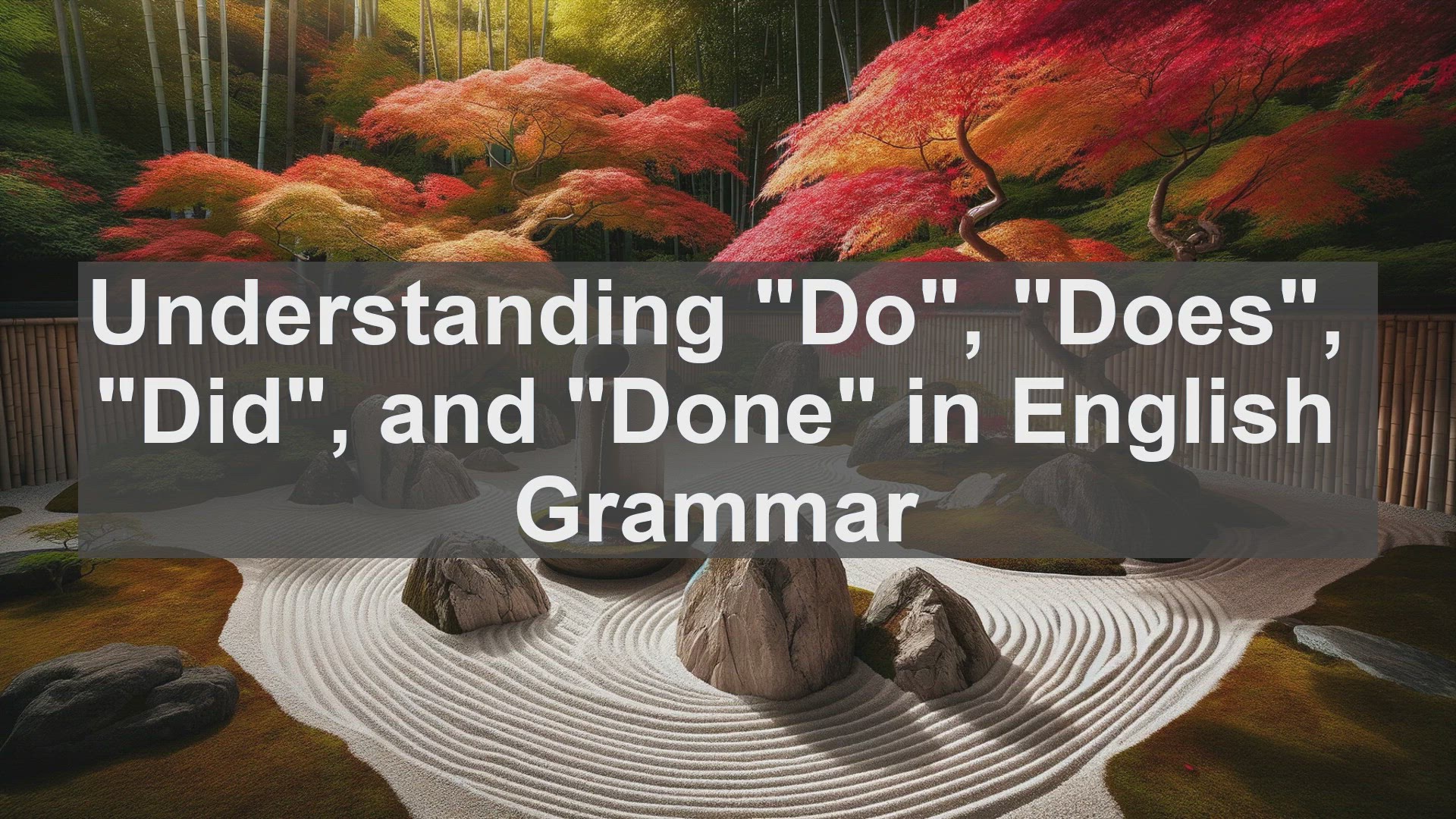
Do, Does, Did, and Done in English Grammar
33K views · Nov 10, 2023 englishteststore.net
Practice Quiz https://englishteststore.net/index.php?option=com_content&view=article&id=16622:do-does-did-done-english-test&catid=616&Itemid=382 Understanding "Do", "Does", "Did", and "Done" in English Grammar In English, the verb "do" serves multiple roles – from helping form questions and negatives to acting as a main verb. To truly harness its power, one needs to understand its various forms, including "do", "does", "did", and "done". 1. What are "Do", "Does", "Did", and "Done"? These words are different forms of the verb "do", used to carry out actions or as auxiliary verbs to form questions, negatives, and emphases. Examples: - I do my homework every day. - She does her chores. - They did the task last week. - The work has been done. 2. What Tense Uses "Do", "Does", "Did", and "Done"? - Do/Does: Used in the Present Simple Tense. Examples: - I do love reading. - She does go to the gym regularly. - Did: Used in the Past Simple Tense. Example: - Did you see that movie? - Done: The past participle of "do", often used with the verb "have" in perfect tenses. Example: - I have done my assignment. 3. How to Use "Do", "Does", "Did", and "Done" in Sentences: - Do: Used with the pronouns I, we, you, they, and plural nouns. Example: We do respect our elders. - Does: Used with third person singular pronouns/nouns: he, she, it, or a singular noun. Example: She does like pizza. - Did: Used for all pronouns and nouns to indicate a past action. Example: They did visit the museum. - Done: Commonly used with "has", "have", or "had" to form the perfect tenses. Example: She has done her part. 4. The Difference Among "Do", "Does", "Did", and "Done": - Do: Refers to a general action in the present for most subjects. Example: I do understand the rules. - Does: Refers to a present action specifically for third person singular. Example: He does play football. - Did: Refers to an action in the past regardless of the subject. Example: They did attend the meeting. - Done: Refers to an action that has been completed, typically used in perfect tenses. Example: I have done my homework. 5. Cases Where "Do", "Does", "Did", and "Done" Shouldn't Be Used: - When using modal verbs: Incorrect: I do can swim. Correct: I can swim. - When using other auxiliary verbs: Incorrect: She is does reading. Correct: She is reading. - Using "done" without a helping verb: Incorrect: I done it yesterday. Correct: I did it yesterday.

Understanding Have, Has, and Had in English Grammar
16K views · Nov 10, 2023 englishteststore.net
Practice Quiz https://englishteststore.net/index.php?option=com_content&view=article&id=16626:have-has-had-english-test&catid=616&Itemid=382 Understanding "Have", "Has", and "Had": A Deep Dive "Have", "has", and "had" are integral components of English grammar, serving as both auxiliary and main verbs. Understanding their appropriate usage is key to mastering the language. Let's explore these verbs in detail. 1. What are "have", "has", and "had"? Have and has are the present forms of the verb, while had is the past form. As main verbs, they denote possession, obligation, relationships, or certain bodily sensations. Examples: - I have two brothers. - She has a car. - They had a house in the countryside. 2. What Tense Uses "have", "has", and "had"? Have/Has: - Present Simple Tense: Used to denote habits, facts, and general truths. Example: She has a pet parrot. Had: - Past Simple Tense: Used to describe actions or states that were completed in the past. Example: We had dinner at 8 pm yesterday. Have/Has + Past Participle: - Present Perfect Tense: Used to describe actions or states that happened at an unspecified time in the past and may be connected to the present. Example: He has visited Paris several times. Had + Past Participle: - Past Perfect Tense: Used to describe actions or states that happened before another past action or state. Example: She had left the room before I arrived. 3. How to Use "have", "has", and "had" in Sentences - As Main Verbs (indicating possession, relationships, or certain sensations): Examples: - They have three children. - She has a headache. - We had a great time at the beach. - As Auxiliary Verbs (forming perfect tenses or expressing necessity/obligation): Examples: - I have finished my work. - She has been to London. - They had eaten before we arrived. - I have to leave now. 4. Cases Where "have", "has", and "had" Shouldn't Be Used While "have", "has", and "had" are versatile, there are contexts where they're not appropriate: - When talking about actions that are in progress (continuous tenses): Incorrect: She has having a bath. Correct: She is having a bath. - In simple future tense: Incorrect: Tomorrow, I have a meeting at 10 am. Correct: Tomorrow, I will have a meeting at 10 am. - When a different verb is more suitable: Incorrect: I have a belief in magic. Correct: I believe in magic. In summary, "have", "has", and "had" are pivotal in English grammar. They can express possession, relationships, and more. When used as auxiliary verbs, they help form perfect tenses. However, it's important to recognize the contexts where they shouldn't be used, ensuring clarity and grammatical accuracy.

Understanding They, Their,Theirs, and Them in English Gramma...
755 views · Nov 11, 2023 englishteststore.net
Practice Quiz https://englishteststore.net/index.php?option=com_content&view=article&id=16651:they-their-theirs-them-english-test-and-exercise&catid=616&Itemid=382 Understanding "They", "Their", "Theirs", and "Them" in English Grammar In English, when referring to more than one person in a general or specific context, the pronouns "they", "their", "theirs", and "them" are of primary importance. These terms offer both inclusivity and specificity in various scenarios. This article breaks down the nuances of these four pronouns. 1. What are "They", "Their", "Theirs", and "Them"? - They: A subject pronoun referring to two or more people or things. Example: They are my friends. - Their: A possessive adjective indicating that something belongs to or is related to the people or things previously mentioned. Example: That's their dog. - Theirs: A possessive pronoun suggesting ownership or a relation to two or more people. Example: The bigger cake is theirs. - Them: An object pronoun referring to two or more people or things. Example: I saw them at the park. 2. What Tense Uses "They", "Their", "Theirs", and "Them"? These pronouns are not restricted by tense. They can be featured in sentences in the past, present, or future. Examples: - They visited Rome last year. (Past) - Their house is on Elm Street. (Present) - I will give the books to them tomorrow. (Future) 3. How to Use "They", "Their", "Theirs", and "Them" in Sentences: - They: Always functions as a subject. Example: They like hiking. - Their: Denotes possession or association. Example: Their solution was ingenious. - Theirs: Stands alone to signify possession. Example: The choice is theirs. - Them: Operates as an object (either direct or indirect). Example: You can trust them. 4. The Difference Among "They", "Their", "Theirs", and "Them": - They: Subject pronoun. Example: They are on a vacation. - Their: Possessive adjective. Example: I like their approach to the problem. - Theirs: Possessive pronoun. Example: This idea was theirs from the beginning. - Them: Object pronoun. Example: The coach selected them for the match. 5. Cases Where "They", "Their", "Theirs", and "Them" Shouldn't Be Used: - Using "them" as a subject: Incorrect: Them are responsible. Correct: They are responsible. - Using "they" as an object: Incorrect: I gave the tickets to they. Correct: I gave the tickets to them. - Using "theirs" with a noun: Incorrect: That is theirs mistake. Correct: That is their mistake. To wrap up, the pronouns "they", "their", "theirs", and "them" hold a pivotal position in the English language, serving as tools to reference multiple entities, whether people or things. Grasping the distinctions and applications of these pronouns can greatly enhance one's fluency and precision in English communication.

You, Your, and Yours in English Grammar
736 views · Nov 11, 2023 englishteststore.net
Practice Quiz https://englishteststore.net/index.php?option=com_content&view=article&id=16652:you-your-yours-exercise-and-test&catid=616&Itemid=382 Understanding "You", "Your", and "Yours" in English Grammar In the realm of English grammar, the words "you", "your", and "yours" are personal pronouns that pertain to the person or people being addressed. Mastery of their use is crucial for effective communication. Let's delve into these pronouns to understand them better. 1. What are "You", "Your", and "Yours"? - You: A pronoun that refers to the person or people being spoken to. Example: You are a good friend. - Your: A possessive adjective that shows ownership or relation with respect to the listener. Example: Is that your notebook? - Yours: A possessive pronoun denoting something belonging to or associated with the listener. Example: This pen is yours. 2. What Tense Uses "You", "Your", and "Yours"? These pronouns are not restricted to any specific tense. They can appear in contexts ranging from past to present to future. Examples: - You visited Rome last summer. (Past) - Is this your umbrella? (Present) - Will this be yours? (Future) 3. How to Use "You", "Your", and "Yours" in Sentences: - You: Utilized as both a subject and an object. Example: You are my best friend. (Subject) Example: I told you the secret. (Object) - Your: Appears before a noun to indicate possession. Example: Your dress is lovely. - Yours: Stands alone, without a noun following it. Example: This house is yours. 4. The Difference Among "You", "Your", and "Yours": - You: Used to address or refer to the person or people being spoken to. Example: You have a call waiting. - Your: Precedes a noun to show that it belongs to or relates to the person(s) you are speaking to. Example: I like your shoes. - Yours: Indicates possession and stands on its own without a subsequent noun. Example: Is this book yours? 5. Cases Where "You", "Your", and "Yours" Shouldn't Be Used: - Using "your" without a subsequent noun: Incorrect: This book is your. Correct: This book is yours. - Using "yours" with a noun: Incorrect: Is this yours pen? Correct: Is this your pen? - Using "you" in impersonal or general statements: Incorrect: You say that life is hard. Correct: People say that life is hard.

Unraveling She Her and Hers in English Grammar
1K views · Nov 11, 2023 englishteststore.net
Practice Quiz https://englishteststore.net/index.php?option=com_content&view=article&id=16649:she-her-hers-english-test-and-exercise&catid=616&Itemid=382 Unraveling "She", "Her", and "Hers" in English Grammar In English, when we refer to a female individual, the pronouns "she", "her", and "hers" come into play. These words are crucial for precise and correct reference. This article elucidates the roles and differences of these three pronouns. 1. What are "She", "Her", and "Hers"? - She: A subject pronoun that refers to a female person or certain animals perceived as female. Example: She is a teacher. - Her: Can function as both a possessive adjective and an object pronoun. As an adjective: I borrowed her book. As an object pronoun: I met her at the park. - Hers: A possessive pronoun indicating something belongs to or is associated with a female. Example: The choice is hers. 2. What Tense Uses "She", "Her", and "Hers"? These pronouns are versatile and can be used in sentences of any tense, be it past, present, or future. Examples: - She danced gracefully last night. (Past) - This is her pen. (Present) - The decision will be hers. (Future) 3. How to Use "She", "Her", and "Hers" in Sentences: - She: Always used as a subject. Example: She sings beautifully. - Her: Denotes possession or serves as an object. As an adjective: Her voice is melodious. As an object: He called her. - Hers: Stands alone to indicate possession. Example: The last piece is hers. 4. The Difference Among "She", "Her", and "Hers": - She: Subject pronoun. Example: She has a cat. - Her: Possessive adjective or object pronoun. As an adjective: Her dress is red. As an object: I told her the truth. - Hers: Possessive pronoun. Example: This bag is hers. 5. Cases Where "She", "Her", and "Hers" Shouldn't Be Used: - Using "her" as a subject: Incorrect: Her is a dancer. Correct: She is a dancer. - Using "she" as an object: Incorrect: I saw she at the party. Correct: I saw her at the party. - Using "hers" with a noun: Incorrect: This is hers bag. Correct: This is her bag. In summation, the pronouns "she", "her", and "hers" are fundamental in the English language for denoting female individuals. Proper comprehension and deployment of these terms ensure seamless communication, aiding one in becoming proficient in the language.

Top 10 Advanced English Grammar Concepts
8K views · Nov 13, 2023 englishteststore.net
Top 10 Advanced English Grammar Concepts 1. The Subjunctive Mood: Expressing Hypotheticals and Wishes The subjunctive mood is used to express situations that are hypothetical, contrary to fact, or express a wish. For example, 'If I were you' or 'I wish I were there'. Understanding the subjunctive mood adds depth to your language skills. 2. The Gerund: A Verb Form That Functions as a Noun The gerund is a verb form that ends in '-ing' and functions as a noun. It can be the subject or object of a sentence. For instance, 'Swimming is my favorite hobby' or 'I enjoy reading'. Recognizing gerunds helps in sentence construction. 3. The Participial Phrase: Adding Descriptive Details A participial phrase consists of a participle (verb form) and its modifiers. It adds descriptive details to a sentence. For example, 'The dog, barking loudly, alerted us'. Mastering participial phrases enhances your writing style. 4. The Conditional Sentence: Expressing Conditions and Their Outcomes Conditional sentences have two parts: the 'if' clause (expressing the condition) and the main clause (the result). They are used to talk about possibilities, hypothetical situations, or cause-and-effect relationships. Understanding conditionals improves your communication skills. 5. The Appositive: Providing Additional Information An appositive is a noun or noun phrase that renames or provides additional information about another noun in the sentence. For instance, 'My friend, a talented musician, played the piano'. Appositives add depth to your descriptions. 6. The Absolute Phrase: Emphasizing a Sentence Element An absolute phrase combines a noun and a participle with any accompanying modifiers. It adds emphasis to a sentence element. For example, 'The storm having passed, we ventured outside'. Absolute phrases create a strong impact in writing. 7. The Ellipsis: Omitting Words for Conciseness Ellipsis involves omitting words or phrases that are understood in the context. It helps in creating concise sentences. For instance, 'She can play the guitar; he, the piano'. Mastering ellipsis improves your writing efficiency. 8. The Inversion: Changing Word Order for Emphasis Inversion involves reversing the usual word order in a sentence. It is often used for emphasis or in formal writing. For example, 'Never have I seen such a beautiful sunset'. Understanding inversion adds sophistication to your language use. 9. The Idiomatic Expression: Figurative Language at Its Best Idiomatic expressions are phrases that have a figurative meaning different from the literal interpretation. For example, 'It's raining cats and dogs' or 'Break a leg'. Familiarity with idioms enriches your language and cultural understanding. 10. The Dangling Modifier: Avoiding Ambiguity in Sentences A dangling modifier is a phrase that doesn't have a clear connection to the word it modifies, leading to confusion or ambiguity. For instance, 'Running to catch the train, the umbrella was left behind'. Recognizing and correcting dangling modifiers ensures clarity in your writing.
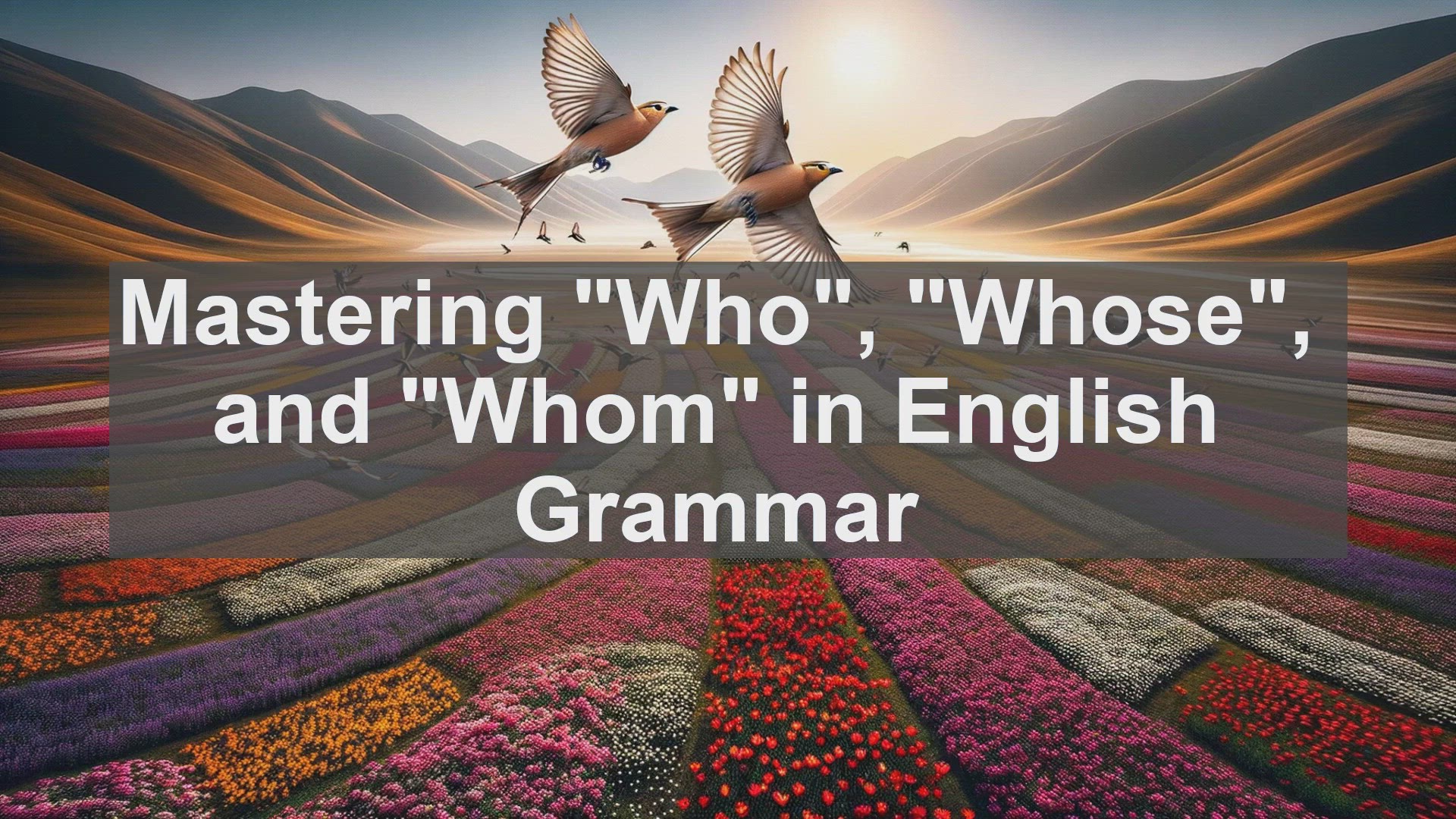
Mastering Who, Whose, and Whom in English Grammar
4K views · Nov 14, 2023 englishteststore.net
Practice Quiz https://englishteststore.net/index.php?option=com_content&view=article&id=16629:who-whose-whom-english-test&catid=616&Itemid=382 Mastering "Who", "Whose", and "Whom" in English Grammar In English, the interrogative pronouns "who", "whose", and "whom" are fundamental in asking questions about people. Their proper use is crucial for clarity and grammatical accuracy. This article explores these pronouns in detail. 1. What are "Who", "Whose", and "Whom"? - Who: Used to ask about the identity of a person or people, typically as the subject of a sentence. Example: Who called you last night? - Whose: Used to inquire about ownership or a relationship to a person. Example: Whose book is this? - Whom: Used to ask about the object of a verb or preposition. Example: To whom did you give the keys? 2. How to Use "Who", "Whose", and "Whom" in Sentences: - Who: Often acts as the subject of a sentence. Example: Who is going to lead the meeting? - Whose: Poses questions about possession. Example: Whose jacket is hanging in the hallway? - Whom: Typically used as the object of a verb or preposition. Example: Whom did you ask for help? 3. Avoiding Errors When Using "Who", "Whose", "Whom": - Remember, "who" is for subjects, "whom" for objects. If you can replace it with “he” or “she”, use "who". If “him” or “her” fits, use "whom". - Use "whose" only when referring to possession. - Modern English tends to use "who" in place of "whom" in informal contexts. 4. The Difference Among "Who", "Whose", and "Whom": - Who vs. Whom: - Who is used as a subject: Who made this cake? - Whom is used as an object: Whom did you see? - Whose vs. Who/Whom: - Whose is for possession: Whose phone is ringing? - Who/Whom refer to people: Who/Whom do you recommend? 5. Cases When Not to Use "Who", "Whose", "Whom": - Avoid using "whom" as a subject: Incorrect: Whom is at the door? Correct: Who is at the door? - Don't use "who" or "whom" for non-human subjects: Incorrect: Who (referring to a dog) won the dog show? Correct: Which dog won the dog show? - Don't use "whose" when not indicating possession: Incorrect: Whose did you call? (asking about the action) Correct: Who did you call? In conclusion, "who", "whose", and "whom" are key interrogative pronouns in English, each serving a unique purpose in querying about people. Their correct use adds precision and sophistication to speech and writing. Understanding the nuances of these pronouns is essential for effective communication in English.

Top 10 Business English Vocabulary Words for Professionals
3K views · Nov 14, 2023 englishteststore.net
Top 10 Business English Vocabulary Words for Professionals Introduction Hello everyone! In today's video, we'll be diving into the world of business English. Whether you're a student or a professional, having a strong vocabulary is crucial. It not only helps you communicate effectively but also leaves a lasting impression. So, without further ado, let's get started! 1. Networking In the business world, networking is key. It refers to the process of building and maintaining relationships with others in your industry. Whether it's attending conferences or connecting on professional platforms, networking opens doors to new opportunities. 2. Innovation Innovation is all about thinking outside the box. It's about coming up with fresh ideas and solutions. In today's fast-paced world, businesses that embrace innovation are the ones that thrive. 3. Strategy Every successful business has a well-defined strategy. It's the roadmap that guides decision-making and sets goals. A good strategy takes into account market trends, competition, and the company's strengths and weaknesses. 4. Collaboration Gone are the days of working in silos. Collaboration is the name of the game. It's about working together, pooling resources, and leveraging each other's strengths. The result? Increased productivity and better outcomes. 5. Globalization In today's interconnected world, businesses are no longer confined to their local markets. Globalization refers to the process of expanding operations internationally. It brings with it a whole new set of challenges and opportunities. 6. Marketing Marketing is the art of promoting and selling products or services. It involves understanding customer needs, creating compelling campaigns, and effectively communicating the value proposition. A good marketing strategy can make all the difference. 7. Leadership A strong leader is the backbone of any successful team. Leadership is not just about giving orders; it's about inspiring, motivating, and guiding others towards a common goal. Great leaders lead by example. 8. Negotiation Negotiation is a skill that every business professional should master. It's about finding common ground, reaching agreements, and ensuring both parties are satisfied. A successful negotiation is a win-win situation. 9. Analytics Data is the new gold. Analytics is the process of analyzing and interpreting data to gain insights. It's about making data-driven decisions and identifying areas for improvement. In today's digital age, analytics is more important than ever. 10. Adaptability The business landscape is constantly evolving. Those who can adapt quickly are the ones who succeed. Adaptability is about being open to change, embracing new technologies, and continuously learning and growing. Conclusion And there you have it, our top 10 business English vocabulary words. By incorporating these words into your everyday conversations and writing, you'll be well on your way to becoming a confident and effective communicator in the business world. Thank you for watching, and until next time, happy learning!

Top 10 Common English Grammar Errors in Academic Papers
7K views · Nov 14, 2023 englishteststore.net
Top 10 Common English Grammar Errors in Academic Papers Introduction Hello everyone! Welcome to today's video. As students, we often come across various grammar errors in our academic papers. These errors can negatively impact our grades and overall impression. So, in this video, we'll be discussing the top 10 common English grammar errors found in academic papers. Let's dive in! 1. Subject-Verb Agreement One of the most common errors is the mismatch between the subject and the verb. For example, saying 'The data is' instead of 'The data are.' Remember, singular subjects need singular verbs, and plural subjects need plural verbs. 2. Misplaced Modifiers Modifiers, such as adjectives or adverbs, should be placed near the words they modify. A common mistake is placing the modifier too far from the word, leading to confusion. For instance, 'The professor only taught one chapter' instead of 'The professor taught only one chapter.' 3. Run-on Sentences Run-on sentences occur when two or more independent clauses are joined without proper punctuation. These sentences can be confusing to read. To fix this, use appropriate punctuation or consider breaking the sentence into smaller ones. 4. Lack of Parallelism Parallelism refers to using the same grammatical structure for similar ideas. For example, 'She likes hiking, swimming, and to run' should be 'She likes hiking, swimming, and running.' Maintaining parallelism improves the flow and clarity of your writing. 5. Incorrect Pronoun Usage Using pronouns incorrectly can lead to confusion. For instance, 'Everyone should bring their own book' should be 'Everyone should bring his or her own book.' If the gender is unknown, use 'his or her' or rephrase the sentence to avoid pronoun issues. 6. Improper Use of Apostrophes Apostrophes are commonly misused. Remember, they indicate possession or contraction. For example, 'The students' notebooks' indicates possession, while 'It's a beautiful day' is a contraction of 'It is.' Be cautious not to confuse the two. 7. Lack of Consistency in Verb Tenses Maintaining consistency in verb tenses is crucial. Shifting between past, present, and future tenses without a clear reason can confuse the reader. Choose the appropriate tense and stick to it throughout your paper. 8. Incorrect Capitalization Capitalization errors can make your writing appear unprofessional. Remember to capitalize proper nouns, the first word of a sentence, and titles. For example, 'I visited the White house' should be 'I visited the White House.' 9. Lack of Comma Usage Commas are essential for clarity and proper sentence structure. A common mistake is the absence of a comma in compound sentences. For instance, 'I went to the store and bought milk bread and eggs' should be 'I went to the store and bought milk, bread, and eggs.' 10. Wordiness Lastly, wordiness can make your writing convoluted. Be concise and to the point. Avoid unnecessary repetition or using complex words when simpler ones suffice. Remember, clarity is key. Conclusion And there you have it, the top 10 common English grammar errors found in academic papers. By being aware of these errors and actively working to avoid them, you can significantly improve your writing. Remember, practice makes perfect. Thanks for watching, and see you in the next video!

Top 10 Common English Grammar Errors in Online Forums
323 views · Nov 14, 2023 englishteststore.net
Top 10 Common English Grammar Errors in Online Forums Introduction Hello everyone! As an English teacher, I've noticed some recurring grammar mistakes in online forums. In this video, I'll be sharing the top 10 errors and how to avoid them. Let's get started! 1. Confusing 'Your' and 'You're' One of the most common errors is mixing up 'your' and 'you're.' 'Your' shows possession, while 'you're' is a contraction of 'you are.' Remember, if you can replace the word with 'you are,' use 'you're.' 2. Misusing 'Their,' 'They're,' and 'There' These three words sound the same but have different meanings. 'Their' indicates possession, 'they're' is short for 'they are,' and 'there' refers to a place. Double-check which one fits the context. 3. Overusing Apostrophes Apostrophes are used for contractions and to show possession. However, they're not needed for plural nouns. For example, 'cats' is correct, while 'cat's' implies possession. 4. Incorrect Subject-Verb Agreement The subject and verb in a sentence should agree in number. If the subject is singular, the verb should be too. For plural subjects, use a plural verb. 5. Run-on Sentences A run-on sentence occurs when two or more independent clauses are joined without proper punctuation. To fix this, use a period, semicolon, or coordinating conjunction. 6. Lack of Punctuation Punctuation is crucial for clarity. Commas, periods, and question marks help convey meaning and structure. Make sure to use them appropriately. 7. Inconsistent Tenses Switching between past, present, and future tenses can confuse readers. Stick to one tense unless there's a clear reason to change. 8. Using 'A' instead of 'An' (and Vice Versa) The choice between 'a' and 'an' depends on the following sound. Use 'a' before consonant sounds and 'an' before vowel sounds. For example, 'a book' and 'an hour.' 9. Lack of Subject in Sentences Every sentence needs a subject, which is the main noun or pronoun. Without a subject, the sentence is incomplete and lacks clarity. 10. Spelling Mistakes While not strictly a grammar error, spelling mistakes can make your writing difficult to understand. Always proofread your work or use spell-check tools. Conclusion Improving your grammar skills takes time and practice. By being aware of these common errors, you're already on the right track. Keep writing, and don't be afraid to ask for feedback. Thanks for watching!
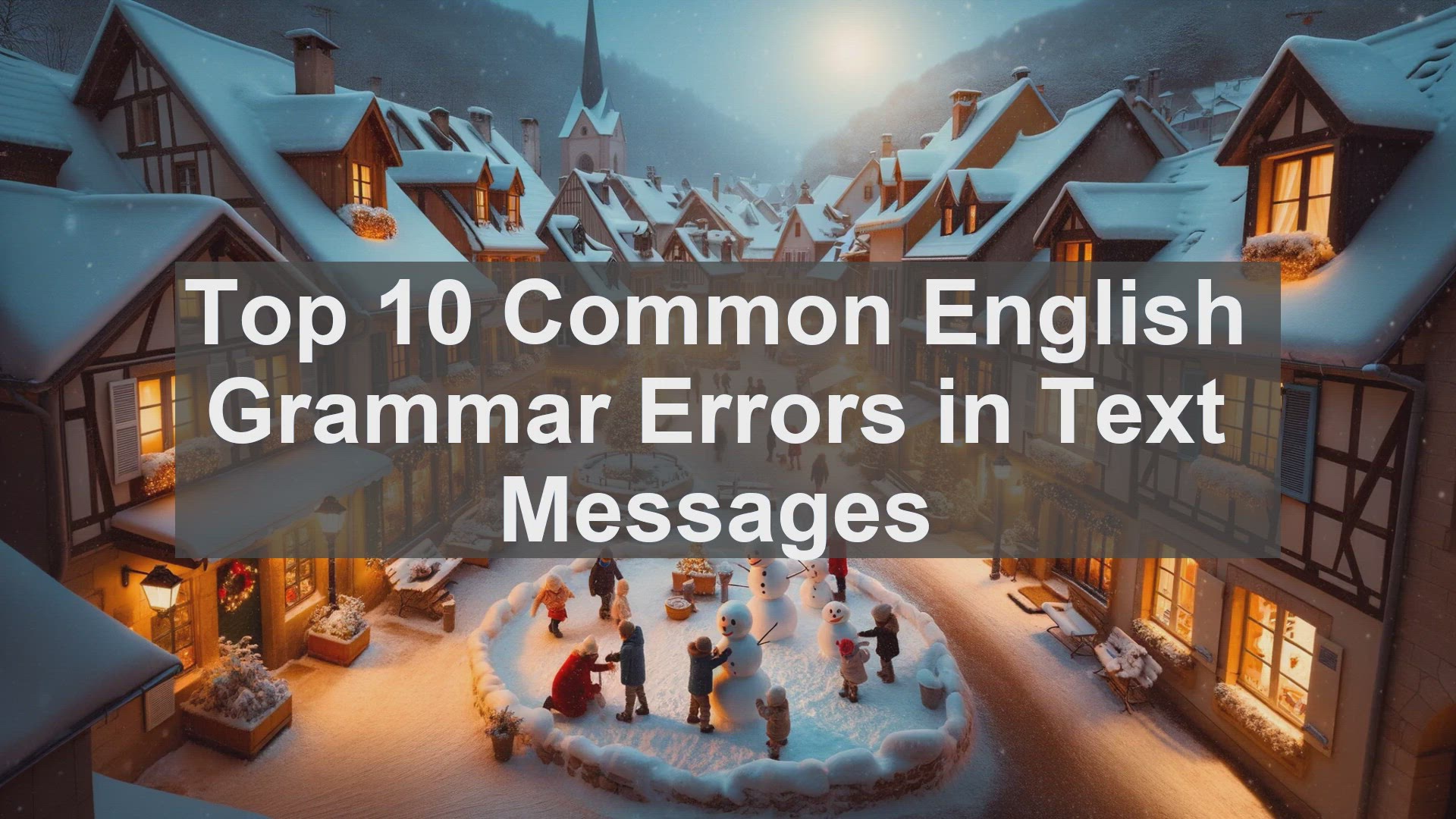
Top 10 Common English Grammar Errors in Text Messages
36K views · Nov 14, 2023 englishteststore.net
Top 10 Common English Grammar Errors in Text Messages Introduction: The Importance of Grammar in Texting Hello everyone! When we think of grammar, we often associate it with formal writing. However, it's equally crucial in our everyday text messages. Proper grammar ensures clarity and prevents misunderstandings. So, let's dive into the top 10 common grammar errors and how to fix them. 1. Your vs. You're This is a classic mistake. 'Your' indicates possession, like 'your book.' On the other hand, 'you're' is a contraction of 'you are.' So, if you mean 'you are,' use 'you're.' For example, 'You're going to the party, right?' 2. There, Their, and They're These three words sound similar but have different meanings. 'There' refers to a place, like 'I'll meet you there.' 'Their' indicates possession, as in 'Their car is blue.' And 'they're' is a contraction of 'they are.' For instance, 'They're coming over later.' 3. Its vs. It's This one can be confusing. 'Its' indicates possession, like 'The dog wagged its tail.' On the other hand, 'it's' is a contraction of 'it is.' So, if you mean 'it is,' use 'it's.' For example, 'It's raining outside.' 4. Two, Too, and To These three words often get mixed up. 'Two' is the number, like 'I have two apples.' 'Too' means 'also' or 'excessively,' as in 'I want to come too.' And 'to' is a preposition, indicating direction or purpose. For instance, 'I'm going to the store.' 5. Affect vs. Effect These words are often used interchangeably, but they have distinct meanings. 'Affect' is a verb, meaning 'to influence.' On the other hand, 'effect' is usually a noun, indicating 'result.' For example, 'The rain affected my mood' and 'The effect of the rain was a flooded street.' 6. Then vs. Than These two words are pronounced similarly, but their usage is different. 'Then' is often used to indicate time, like 'I'll see you then.' On the other hand, 'than' is used for comparison. For instance, 'She is taller than him.' 7. Loose vs. Lose These words are commonly confused. 'Loose' is an adjective, meaning 'not tight.' For example, 'The knot is loose.' On the other hand, 'lose' is a verb, indicating 'to misplace' or 'to fail to win.' For instance, 'Don't lose your keys.' 8. Its vs. It's This one can be confusing. 'Its' indicates possession, like 'The dog wagged its tail.' On the other hand, 'it's' is a contraction of 'it is.' So, if you mean 'it is,' use 'it's.' For example, 'It's raining outside.' 9. Your vs. You're This is a classic mistake. 'Your' indicates possession, like 'your book.' On the other hand, 'you're' is a contraction of 'you are.' So, if you mean 'you are,' use 'you're.' For example, 'You're going to the party, right?' 10. There, Their, and They're These three words sound similar but have different meanings. 'There' refers to a place, like 'I'll meet you there.' 'Their' indicates possession, as in 'Their car is blue.' And 'they're' is a contraction of 'they are.' For instance, 'They're coming over later.' Conclusion: Mastering Grammar for Effective Communication Grammar plays a vital role in our written communication, even in text messages. By being aware of these common errors and practicing correct usage, you can enhance your message's clarity and professionalism. So, let's continue our grammar journey and strive for better communication skills. Thanks for watching!
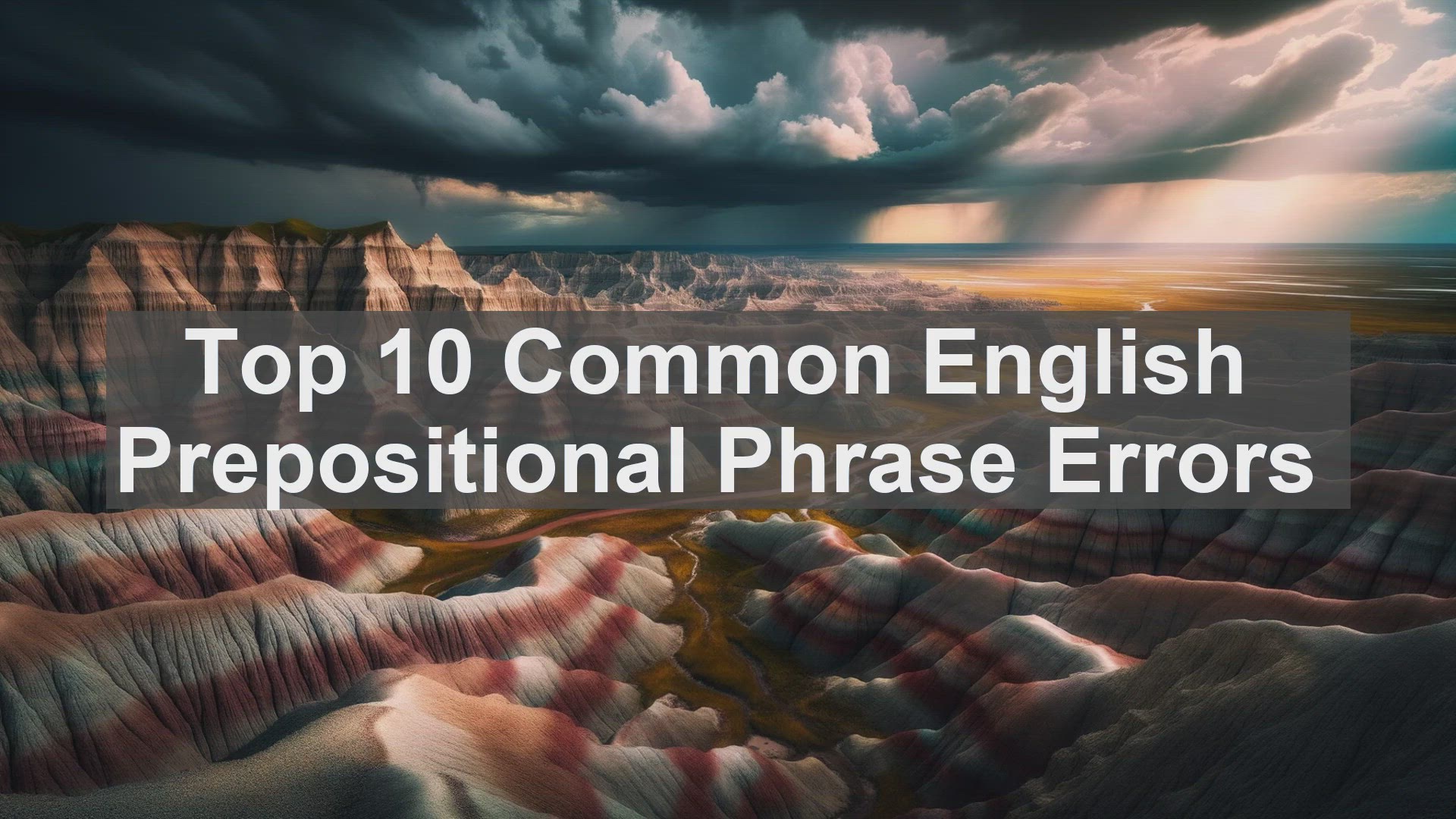
Top 10 Common English Prepositional Phrase Errors
11K views · Nov 14, 2023 englishteststore.net
Top 10 Common English Prepositional Phrase Errors Introduction Hello students! Prepositional phrases are an essential part of English grammar. However, they can be tricky to use correctly. In this video, we will explore the top 10 common errors students make with prepositional phrases and provide you with tips to avoid them. Error 1: Incorrect Preposition Usage One common mistake is using the wrong preposition in a sentence. For example, saying 'I'm going at the cinema' instead of 'I'm going to the cinema.' To avoid this, familiarize yourself with the correct prepositions for different contexts. Error 2: Misplacement of Prepositional Phrases Sometimes, students place prepositional phrases in the wrong position within a sentence. This can lead to confusion. For instance, 'The book on the table I read.' The correct version would be 'I read the book on the table.' Always ensure that prepositional phrases are appropriately positioned. Error 3: Omitting Prepositions Another error is omitting prepositions altogether. For example, saying 'I'm going school' instead of 'I'm going to school.' Prepositions are crucial for conveying accurate meaning, so make sure not to skip them. Error 4: Overusing Prepositions On the flip side, some students tend to overuse prepositions. This can make sentences sound awkward and convoluted. For instance, saying 'I'm waiting for at the bus stop.' The correct version would be 'I'm waiting at the bus stop.' Be mindful of using prepositions only when necessary. Error 5: Confusing 'In' and 'On' The difference between 'in' and 'on' can be confusing. 'In' is used for enclosed spaces, while 'on' is used for surfaces. For example, 'I'm in the car' versus 'The book is on the table.' Understanding this distinction is vital to using prepositional phrases correctly. Error 6: Incorrect Preposition Placement with Time Expressions When using prepositions with time expressions, students often make errors. For instance, saying 'I'll meet you on tomorrow' instead of 'I'll meet you tomorrow.' The correct placement is 'tomorrow' followed by the preposition. Pay attention to this when discussing time. Error 7: Lack of Consistency in Preposition Usage Consistency is key in using prepositions. For example, saying 'I'm interested in playing football, swimming, and to dance.' The correct version would be 'I'm interested in playing football, swimming, and dancing.' Ensure that you use the same preposition throughout a list or series. Error 8: Confusing 'At', 'In', and 'On' for Locations Choosing the right preposition for locations can be challenging. 'At' is used for specific points, 'in' for enclosed spaces, and 'on' for surfaces. For example, 'I'm at the mall,' 'I'm in the park,' and 'I'm on the beach.' Understanding these distinctions is crucial. Error 9: Incorrect Preposition Usage with Verbs Certain verbs require specific prepositions. For example, 'rely on,' 'belong to,' 'listen to.' Using the wrong preposition can change the meaning of the sentence. So, it's essential to learn the correct prepositions that accompany different verbs. Error 10: Neglecting Prepositions in Phrasal Verbs Phrasal verbs are common in English, and they often include prepositions. Neglecting the preposition can lead to incorrect usage. For example, saying 'I'm looking the information' instead of 'I'm looking for the information.' Pay attention to the prepositions in phrasal verbs. Conclusion Prepositional phrases are a fundamental aspect of English. By being aware of these common errors and practicing their correct usage, you can improve your overall language skills. Remember, practice makes perfect! Thank you for watching, and see you in the next video.
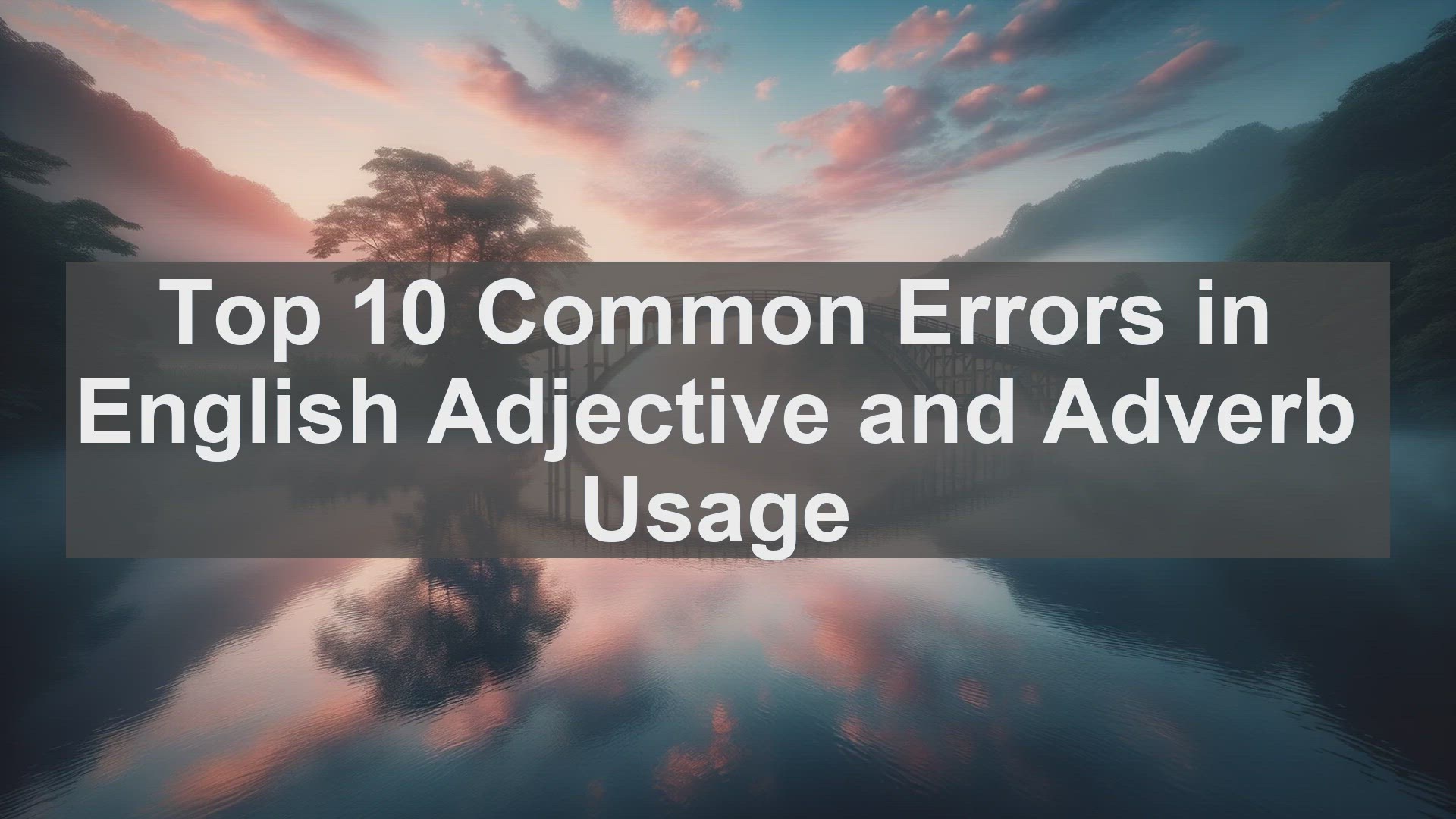
Top 10 Common Errors in English Adjective and Adverb Usage
665 views · Nov 14, 2023 englishteststore.net
Top 10 Common Errors in English Adjective and Adverb Usage Introduction Hello everyone! Welcome to today's lesson on English adjective and adverb usage. As a teacher, I've noticed that students often struggle with certain aspects of these parts of speech. In this video, we'll address the top 10 common errors and provide clear explanations and examples to help you grasp the correct usage. So, let's dive in! 1. Confusing Adjectives and Adverbs One of the most prevalent errors is using adjectives instead of adverbs or vice versa. Remember, adjectives modify nouns, while adverbs modify verbs, adjectives, or other adverbs. For example, saying 'She sings beautiful' is incorrect. It should be 'She sings beautifully' since 'beautifully' is the adverb form. 2. Missing Adverbs of Frequency When discussing routines or habits, it's essential to include adverbs of frequency, such as 'always,' 'often,' or 'rarely.' For instance, saying 'I go to the gym' lacks clarity. Adding an adverb, like 'I often go to the gym,' provides a more accurate picture of the frequency. 3. Incorrect Comparative and Superlative Forms When comparing two things, we use the comparative form, usually by adding '-er' to the adjective. For example, 'She is taller than me.' When comparing more than two things, we use the superlative form, often by adding '-est' to the adjective. For instance, 'She is the tallest in the class.' Mixing up these forms can lead to confusion. 4. Overusing Intensifiers Intensifiers, like 'very' or 'extremely,' can add emphasis to our language. However, using them excessively can make our writing or speech sound repetitive or exaggerated. Instead, consider using more precise adjectives or adverbs to convey your message effectively. 5. Misplacing Adverbs Adverbs should be placed close to the word they modify. Placing them in the wrong position can alter the intended meaning. For example, 'He only speaks English' implies that he does nothing else with English, while 'He speaks English only' means he doesn't speak any other language. 6. Using Double Negatives In English, two negatives cancel each other out, resulting in an affirmative statement. So, saying 'I don't know nothing' actually means 'I know something.' To express a negative idea, use a single negative form, like 'I don't know anything.' 7. Confusing 'Good' and 'Well' While 'good' is an adjective, 'well' is an adverb. So, saying 'I'm good' implies a general state of being, while 'I'm well' refers to a state of health or overall condition. Similarly, 'She sings good' is incorrect. It should be 'She sings well.' 8. Using Adjectives with Non-Gradable Adverbs Some adverbs, like 'completely' or 'absolutely,' don't have degrees of comparison. Therefore, using them with adjectives in the comparative or superlative form is incorrect. For example, saying 'This is more completely wrong' should be 'This is completely wrong.' 9. Confusing 'Hardly' and 'Almost' While 'hardly' means 'almost not,' it doesn't have the same meaning as 'almost.' 'Hardly' implies a negative or minimal quantity, while 'almost' suggests a high degree of closeness. For instance, 'I hardly ate anything' means I ate very little, while 'I almost ate everything' means I ate almost everything. 10. Using Adjectives as Adverbs Sometimes, adjectives and adverbs have different forms. For example, 'quick' is an adjective, while 'quickly' is the corresponding adverb. Using the wrong form can lead to grammatical errors. So, instead of saying 'She ran quick,' it should be 'She ran quickly.' Conclusion And there you have it! The top 10 common errors in English adjective and adverb usage. By being aware of these mistakes, you can actively work on avoiding them and improving your language skills. Remember, practice is key. The more you engage with the language, the more natural and accurate your usage will become. Thanks for watching, and see you in the next lesson!

Top 10 Common Errors in English Clause Structure
614 views · Nov 14, 2023 englishteststore.net
Top 10 Common Errors in English Clause Structure Introduction: The Importance of Proper Clause Structure Hello everyone! As an English teacher, I often come across various errors in clause structure. While these mistakes may seem small, they can significantly impact the clarity and coherence of your sentences. In this video, we'll discuss the top 10 common errors and provide simple tips to avoid them. Let's get started! 1. Misplaced Modifiers Misplaced modifiers can lead to confusion in a sentence. For example, 'Running through the park, the tree suddenly appeared.' Here, it seems like the tree was running. To fix this, place the modifier right next to the word it describes: 'The tree suddenly appeared while I was running through the park.' 2. Lack of Subject-Verb Agreement Subject-verb agreement is crucial for sentence structure. A common error is when the subject and verb don't agree in number. For instance, 'The group of students is going on a trip.' Here, 'is' should be 'are' to match the plural subject 'students.' Always double-check the agreement between your subject and verb. 3. Run-On Sentences Run-on sentences occur when two or more independent clauses are joined without proper punctuation. They can make your writing confusing and hard to follow. To fix this, use a period, semicolon, or coordinating conjunctions like 'and' or 'but' to separate the clauses. 4. Fragmented Sentences Fragments are incomplete sentences that lack a subject, verb, or both. They can make your writing appear disjointed. To correct a fragment, add the missing elements or attach it to a nearby sentence. Remember, every sentence should have a subject and a verb. 5. Incorrect Use of Commas Commas are essential for indicating pauses and separating sentence elements. However, their misuse can alter the meaning of a sentence. For example, 'Let's eat, grandma!' versus 'Let's eat grandma!' To avoid confusion, familiarize yourself with the different comma rules and their appropriate usage. 6. Dangling Participles Dangling participles occur when the subject of a sentence doesn't match the participle. This can create ambiguity. For instance, 'Walking to the store, the rain started.' To clarify, rephrase the sentence: 'As I was walking to the store, the rain started.' 7. Lack of Parallel Structure Parallel structure is crucial for maintaining balance and clarity in a sentence. A common error is when the elements in a list don't have the same grammatical structure. For example, 'She likes hiking, swimming, and to read.' Here, 'to read' should be 'reading' to maintain parallelism. 8. Confusing Adjectives and Adverbs Adjectives describe nouns, while adverbs modify verbs, adjectives, or other adverbs. Confusing the two can lead to incorrect sentence structure. For instance, 'He drives real slow.' Here, 'real' should be 'really' to modify the verb 'drives.' Pay attention to the correct usage of adjectives and adverbs. 9. Double Negatives Double negatives can create confusion and change the intended meaning of a sentence. For example, 'I don't have no money.' Here, the double negative cancels each other out, and the sentence means 'I have money.' Avoid using double negatives to ensure clarity in your writing. 10. Lack of Consistency in Verb Tenses Maintaining consistency in verb tenses is crucial for clear communication. A common error is when there's a sudden shift in tenses within a sentence or paragraph. To avoid this, choose the appropriate tense and stick to it throughout your writing. Conclusion: Mastering English Clause Structure By being aware of these common errors and practicing their correct usage, you'll gradually improve your English clause structure. Remember, mastering grammar is a continuous process, and with time and effort, you'll become more confident in your writing and speaking skills. Thank you for watching, and see you in the next video!

Top 10 Common Errors in English Contraction Usage
4K views · Nov 14, 2023 englishteststore.net
Top 10 Common Errors in English Contraction Usage Introduction to Contractions Hello everyone! Today, we're going to delve into the world of English contractions. Contractions are shortened forms of words, created by combining two words and replacing some letters with an apostrophe. They're commonly used in both spoken and written English, but their usage can be a bit tricky. Let's explore the top 10 errors students often encounter. 1. Misusing 'It's' and 'Its' One of the most common errors is confusing 'it's' with 'its'. 'It's' is a contraction of 'it is' or 'it has', while 'its' is the possessive form of 'it'. For example, 'It's a nice day' means 'It is a nice day', while 'The dog wagged its tail' indicates possession. Remember, no apostrophe is used in the possessive form. 2. Mixing Up 'You're' and 'Your' Another frequent mistake is interchanging 'you're' and 'your'. 'You're' is the contraction of 'you are', whereas 'your' is the possessive form of 'you'. For instance, 'You're a great friend' means 'You are a great friend', while 'Is this your book?' indicates possession. Again, no apostrophe is used in the possessive form. 3. Confusing 'They're', 'Their', and 'There' The trio of 'they're', 'their', and 'there' often causes confusion. 'They're' is the contraction of 'they are', 'their' is the possessive form of 'they', and 'there' refers to a place or location. For example, 'They're going to the park' means 'They are going to the park', 'Their house is beautiful' indicates possession, and 'The store is over there' refers to a location. 4. Error with 'Can't' and 'Cannot' Students sometimes mistakenly use 'can't' and 'cannot' interchangeably. While both mean the same thing, 'can't' is the contraction of 'cannot'. So, if you're writing a formal piece or want to emphasize, it's better to use 'cannot'. For example, 'I can't believe it!' or 'I cannot believe it!' 5. Misusing 'Don't' and 'Doesn't' The difference between 'don't' and 'doesn't' lies in the subject. 'Don't' is the contraction of 'do not' and is used with plural subjects or 'you'. On the other hand, 'doesn't' is the contraction of 'does not' and is used with singular subjects. For instance, 'They don't like coffee' or 'He doesn't understand the question'. 6. Error with 'Won't' and 'Will Not' Similar to the previous point, 'won't' is the contraction of 'will not'. It's used to indicate future actions that someone refuses or is unwilling to do. For example, 'I won't be attending the party' or 'She won't eat vegetables'. 7. Mixing Up 'I'm' and 'Am' While 'I'm' is the contraction of 'I am', 'am' is used in more formal or emphatic situations. For instance, 'I'm going to the store' or 'I am the captain of the team'. 8. Error with 'Shouldn't' and 'Should Not' Just like 'won't', 'shouldn't' is the contraction of 'should not'. It's used to express something that is advised against. For example, 'You shouldn't eat too much junk food' or 'They shouldn't be late for the meeting'. 9. Misusing 'Aren't' and 'Isn't' The difference between 'aren't' and 'isn't' lies in the subject. 'Aren't' is the contraction of 'are not' and is used with plural subjects, while 'isn't' is the contraction of 'is not' and is used with singular subjects. For instance, 'They aren't coming to the party' or 'He isn't feeling well'. 10. Confusing 'Couldn't' and 'Could Not' Lastly, 'couldn't' is the contraction of 'could not'. It's used to indicate the inability to do something. For example, 'I couldn't solve the math problem' or 'She couldn't find her keys'. Conclusion And there you have it, the top 10 common errors in English contraction usage. By being aware of these mistakes, you can enhance your communication skills and avoid confusion. Remember, practice makes perfect, so keep practicing and refining your understanding of contractions. Thanks for watching!

Top 10 Common Errors in English Plural Forms
4K views · Nov 14, 2023 englishteststore.net
Top 10 Common Errors in English Plural Forms Introduction: The Importance of Plurals Hello everyone! Plurals are an essential part of English grammar. They allow us to talk about more than one person, thing, or concept. However, forming plurals can be tricky, and many students make mistakes. Today, we'll discuss the top 10 common errors and how to avoid them. 1. Forgetting the 's' in Regular Plurals The most basic rule for forming plurals is adding an 's' to the end of a singular noun. For example, 'cat' becomes 'cats' and 'book' becomes 'books'. However, it's easy to forget this simple 's' and leave the noun in its singular form, which is incorrect. 2. Incorrectly Using 'es' for Plurals While most singular nouns only require an 's' for the plural form, there are exceptions. For words ending in 's', 'x', 'z', 'ch', or 'sh', we add 'es' instead. For instance, 'box' becomes 'boxes' and 'church' becomes 'churches'. Using just an 's' in these cases is incorrect. 3. Irregular Plurals: No Set Rules English, being the diverse language it is, has many irregular plurals. These words don't follow any specific pattern, so they have to be memorized. For example, 'child' becomes 'children' and 'mouse' becomes 'mice'. Relying on regular plural rules for irregular words leads to errors. 4. Pluralizing Compound Nouns Compound nouns, which are formed by combining two or more words, can be a challenge when it comes to plurals. In most cases, the 's' is added to the main noun. For example, 'passerby' becomes 'passersby'. However, some compounds have irregular plural forms, like 'man' in 'men' and 'woman' in 'women'. 5. Singular Nouns Ending in 'y' When a singular noun ends in 'y', and it's preceded by a consonant, we change the 'y' to 'i' and add 'es' to form the plural. For instance, 'city' becomes 'cities' and 'baby' becomes 'babies'. However, if the 'y' is preceded by a vowel, we simply add an 's'. For example, 'day' becomes 'days'. 6. Plurals of Foreign Words English has borrowed words from various languages, and their plurals often follow the rules of the original language. For example, the plural of 'cactus' is 'cacti', following the Latin pattern. It's important to research and learn the correct plurals for foreign words to avoid errors. 7. Confusing Plurals with Possessives Plurals and possessives are different concepts, but they can be confused. When we want to show possession, we use an apostrophe and an 's'. For example, 'the cat's toy'. However, this doesn't indicate a plural. 'Cats' is the plural form, while 'cat's' is the possessive form. 8. Plurals of Abbreviations and Acronyms When it comes to abbreviations and acronyms, forming the plural can be tricky. In most cases, we simply add an 's' without an apostrophe. For example, 'CDs' for multiple compact discs. However, some style guides recommend using an apostrophe before the 's' for clarity, like 'MP's' for multiple Members of Parliament. 9. Words That Stay the Same in Plural Believe it or not, some words don't change at all in their plural form. These are called 'pluralia tantum'. Examples include 'sheep', 'deer', and 'fish'. So, if you see or hear these words without an 's', don't assume it's a mistake. 10. Context Matters: Singular or Plural? Sometimes, the context determines whether a noun should be singular or plural. For example, 'the fish is in the tank' refers to a specific fish, while 'fish are abundant in the ocean' talks about multiple fish. Pay attention to the context to ensure correct usage. Conclusion: Mastering Plurals By understanding and practicing the rules for forming plurals, you'll become more confident in your English skills. Remember, it's not just about avoiding errors; it's about effectively communicating your ideas. Keep learning, keep practicing, and soon, plurals will be second nature to you. Thanks for watching!
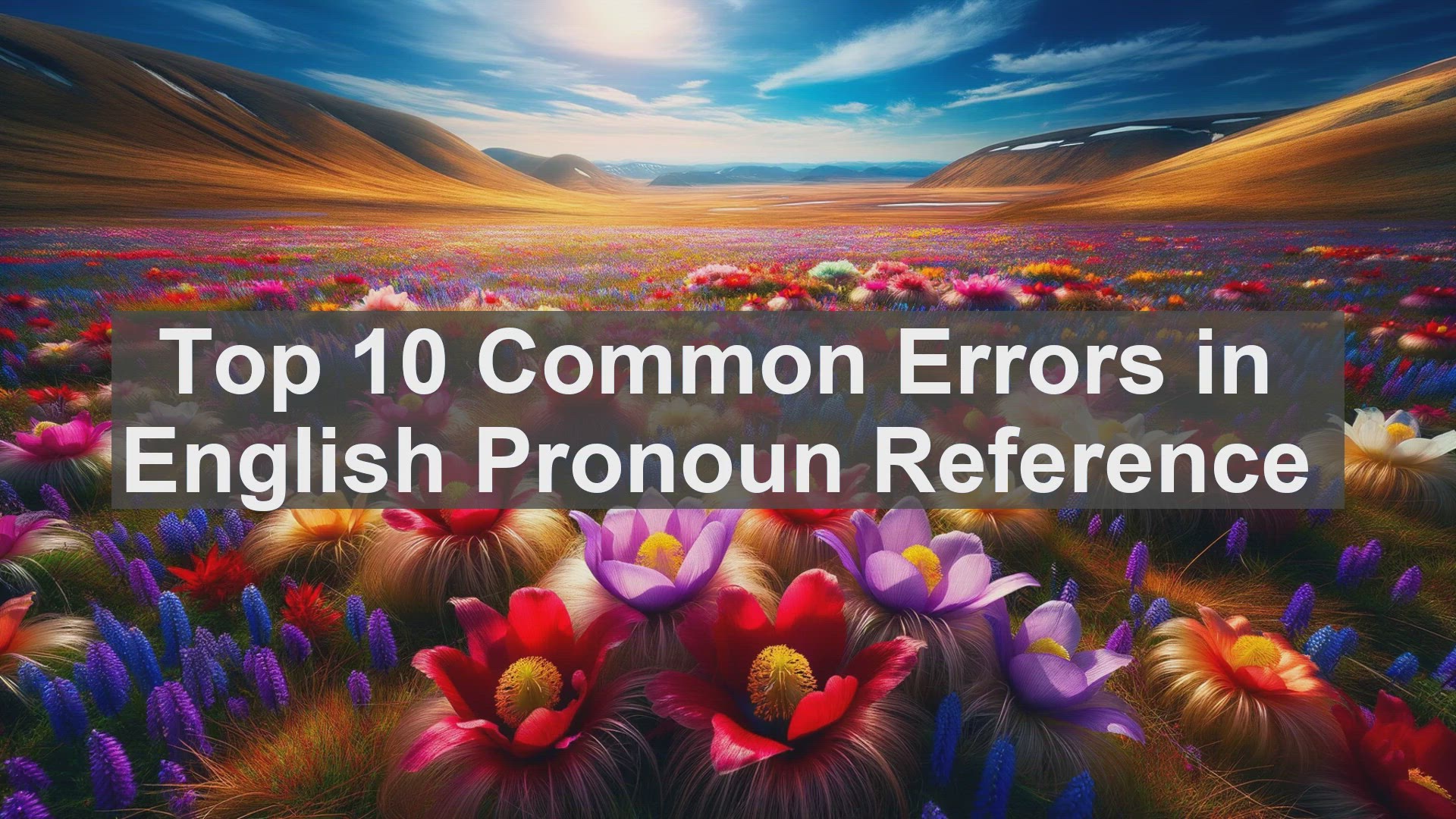
Top 10 Common Errors in English Pronoun Reference
2K views · Nov 14, 2023 englishteststore.net
Top 10 Common Errors in English Pronoun Reference Introduction: The Importance of Pronoun Reference Hello everyone! Welcome to today's video. Pronoun reference is a crucial aspect of English grammar. It ensures clarity and coherence in our sentences. However, many students often stumble upon certain errors. Today, we'll address the top 10 common errors and provide you with strategies to avoid them. 1. Ambiguous Pronoun Reference One common error is ambiguous pronoun reference. This occurs when it's unclear which noun the pronoun is referring to. For example, 'John told Mark that he should study.' Who should study? John or Mark? To avoid this, always ensure a clear antecedent for your pronouns. 2. Vague Pronoun Reference Similar to ambiguity, vague pronoun reference lacks specificity. For instance, 'She went to the store, and it was closed.' What was closed? The store or something else? To rectify this, be explicit in your pronoun references, mentioning the exact noun. 3. Pronoun Agreement Pronoun agreement refers to the matching of pronouns with their antecedents in terms of number and gender. A common mistake is using the wrong pronoun form. For example, 'Everyone must bring their own book.' Here, 'their' doesn't agree with the singular 'everyone.' Instead, use 'his or her' or rephrase the sentence to avoid gender-specific pronouns. 4. Pronoun Case Pronoun case refers to the form of the pronoun based on its function in the sentence. A common error is using the object form instead of the subject form. For instance, 'Me and John went to the park.' It should be 'John and I.' Remember, 'I' is the subject form, while 'me' is the object form. 5. Pronoun Shift Pronoun shift occurs when there's an inconsistent use of pronouns. For example, 'One should always do their best. I believe in it.' Here, 'one' and 'their' are used, but then 'I' and 'it' are introduced. To maintain consistency, stick to one pronoun throughout or rephrase the sentence. 6. Redundant Pronouns Redundant pronouns are unnecessary repetitions of pronouns. For instance, 'She, she went to the store.' To avoid this, use the pronoun once, and if needed, use the noun in subsequent references. 7. Pronoun Placement Pronoun placement is crucial for sentence clarity. Placing the pronoun too far from its antecedent can lead to confusion. For example, 'John, when he was young, loved playing sports.' Here, it's unclear if 'he' refers to John or someone else. To ensure clarity, position the pronoun close to its antecedent. 8. Pronoun Reference with Prepositional Phrases When a pronoun is used with a prepositional phrase, it's essential to ensure the pronoun's reference is clear. For example, 'The book is on the table, and it is heavy.' Here, 'it' could refer to the book or the table. To avoid confusion, consider rephrasing or using the noun instead of the pronoun. 9. Pronoun Reference with Indefinite Pronouns Indefinite pronouns, like 'everyone' or 'someone,' can be tricky when it comes to pronoun reference. For example, 'Everyone should do what they think is right.' Instead, use 'he or she' or rephrase the sentence to ensure clarity. 10. Pronoun Reference in Comparisons In comparative sentences, pronoun reference can be challenging. For instance, 'John is taller than him.' It should be 'John is taller than he.' Remember, the pronoun should be in the subject form when it's part of a comparison. Conclusion: Mastering Pronoun Reference And there you have it - the top 10 common errors in English pronoun reference. By being mindful of these errors and practicing regularly, you can enhance your grammar skills. Remember, clear and accurate pronoun reference is essential for effective communication. Thank you for watching, and we'll see you in the next video!
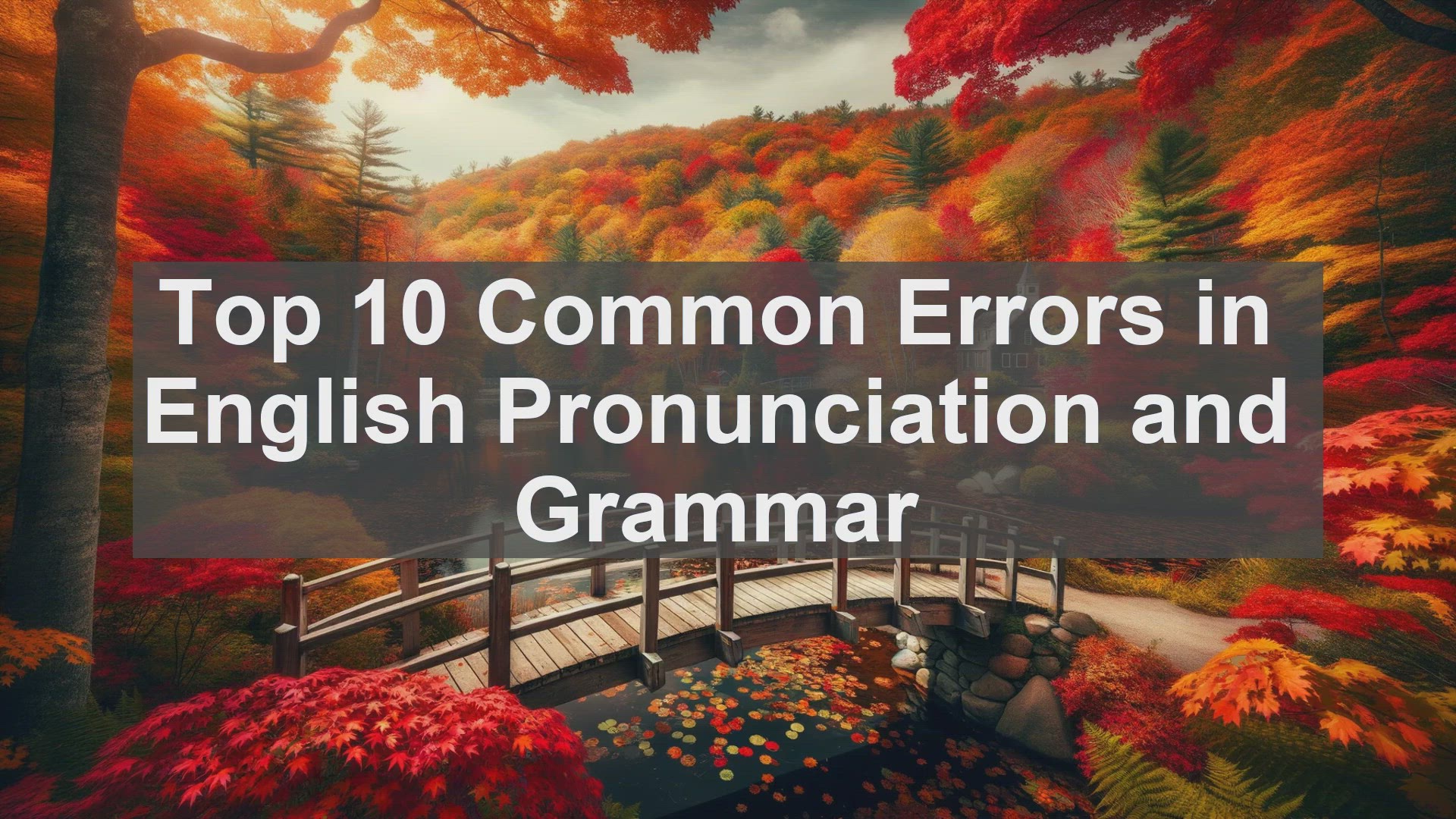
Top 10 Common Errors in English Pronunciation and Grammar
3K views · Nov 15, 2023 englishteststore.net
Top 10 Common Errors in English Pronunciation and Grammar Introduction Hello everyone! Welcome to today's lesson. As an English teacher, I've noticed some common errors that students often make in pronunciation and grammar. In this video, I'll be sharing the top 10 mistakes and providing tips on how to avoid them. Let's get started! 1. Misplacing Stress in Words One of the most common errors is misplacing stress in words. Stressing the wrong syllable can change the meaning of a word. For example, 'present' can be a noun or a verb, depending on where you place the stress. To improve, listen to native speakers, and pay attention to the stress patterns. 2. Using 'A' instead of 'An' and Vice Versa The rule is simple: use 'a' before words that start with a consonant sound, and 'an' before words that start with a vowel sound. However, many students make mistakes with this. Remember, it's about the sound, not the actual letter. So, it's 'an hour' because 'hour' starts with a vowel sound. 3. Subject-Verb Agreement Subject-verb agreement is crucial for sentence construction. The verb must agree with the subject in terms of number. For example, 'The dog barks' (singular subject) and 'The dogs bark' (plural subject). Pay attention to this, especially with irregular verbs. 4. Using 'I' instead of 'Me' and Vice Versa This is a common error in everyday speech. 'I' is used as the subject, while 'me' is used as the object. For example, 'She and I went to the park' (subject) and 'He gave the book to me' (object). 5. Confusing 'Their,' 'There,' and 'They're' These three words sound the same but have different meanings. 'Their' shows possession, 'there' refers to a place, and 'they're' is a contraction of 'they are.' To avoid confusion, understand the context and meaning of the sentence. 6. Incorrect Use of Prepositions Prepositions can be tricky, as their usage often depends on the context. For example, 'in' is used for months ('in January'), while 'on' is used for days ('on Monday'). To improve, read and listen to English content, and pay attention to prepositions. 7. Overusing 'Very' and 'Really' While 'very' and 'really' can add emphasis, they are often overused. Instead, try using more specific adjectives or adverbs. For example, instead of 'very good,' you can say 'excellent' or 'outstanding.' This will make your language more precise and varied. 8. Neglecting Articles ('A,' 'An,' 'The') Articles are small words, but they play a significant role in English. 'A' and 'an' are indefinite articles, used for non-specific nouns, while 'the' is the definite article, used for specific nouns. Pay attention to articles, as they can change the meaning of a sentence. 9. Confusing 'Its' and 'It's' This is a common error, even among advanced English learners. 'Its' is the possessive form, while 'it's' is a contraction of 'it is.' To differentiate, ask yourself if you can expand it to 'it is.' If not, use 'its.' 10. Lack of Parallelism Parallelism refers to using the same grammatical structure for similar ideas. This adds clarity and balance to your writing. For example, 'She likes swimming, hiking, and to read' should be 'She likes swimming, hiking, and reading.' Pay attention to parallelism, especially in lists and comparisons. Conclusion And there you have it, the top 10 common errors in English pronunciation and grammar. By being aware of these mistakes and actively working on them, you can improve your language skills and become a more confident communicator. Remember, practice makes perfect! If you found this video helpful, don't forget to like and subscribe. Thanks for watching, and see you in the next lesson!

Top 10 Common Errors in English Punctuation in Digital Conte...
2K views · Nov 15, 2023 englishteststore.net
Top 10 Common Errors in English Punctuation in Digital Content Introduction: The Importance of Proper Punctuation Hello everyone! Welcome to today's video. Punctuation may seem like a small detail, but it plays a crucial role in conveying meaning and ensuring clarity in our writing. In the digital age, where communication is primarily text-based, mastering punctuation is more important than ever. Let's explore the top 10 common errors and how to avoid them. 1. The Comma Splice A comma splice occurs when two independent clauses are joined by a comma without a coordinating conjunction. For example: 'I love to write, it helps me express my thoughts.' To fix this, you can either use a semicolon or separate the clauses into two sentences. 'I love to write; it helps me express my thoughts.' or 'I love to write. It helps me express my thoughts.' 2. Misusing the Apostrophe The apostrophe has two main uses: to indicate possession and to form contractions. One common error is using it to pluralize words, such as 'apple's' or 'banana's'. To pluralize, simply add an 's' without the apostrophe. Another mistake is omitting the apostrophe in contractions, like 'dont' instead of 'don't'. Remember, the apostrophe represents missing letters. 3. Overusing Exclamation Marks Exclamation marks are meant to convey strong emotions or emphasis. However, using them excessively can dilute their impact. Reserve exclamation marks for situations that truly warrant them, and opt for other punctuation marks like periods or question marks when appropriate. 4. The Run-On Sentence A run-on sentence occurs when two or more independent clauses are joined without proper punctuation or conjunctions. It can make the sentence confusing and hard to follow. To fix a run-on sentence, you can use a period, a semicolon, or a coordinating conjunction like 'and' or 'but' to join the clauses. 5. Forgetting the Oxford Comma The Oxford comma, also known as the serial comma, is the comma used before the conjunction in a list of three or more items. For example: 'I bought apples, bananas, and oranges.' Including the Oxford comma can prevent ambiguity and ensure clarity in your writing. 6. Mixing Up Hyphens and Dashes Hyphens (-) are used to join words or parts of words, while dashes (– or —) are used to indicate a pause or break in a sentence. Mixing them up can lead to confusion. For example, 'The long-term goal is to...' Here, a dash is used to indicate the pause. In contrast, 'The two-year project' uses a hyphen to join the words. 7. Using Ellipses Incorrectly Ellipses (...) are used to indicate a pause, an omission, or trailing off in a sentence. However, they should be used sparingly and not as a substitute for proper punctuation. Avoid using them excessively or inappropriately, as it can make your writing appear unprofessional. 8. Inconsistent Quotation Mark Usage In English, double quotation marks (") are commonly used for direct quotes, while single quotation marks (') are used for quotes within quotes or for emphasis. It's important to be consistent in your usage and to properly punctuate the quoted text. 9. Capitalization Errors in Titles When it comes to capitalizing titles, it's essential to follow the appropriate style guide. In general, major words should be capitalized, while articles, conjunctions, and prepositions are usually lowercase unless they are the first or last word in the title. 10. Neglecting the Importance of Proofreading Even with all the punctuation rules in mind, errors can still slip through. That's why proofreading is crucial. Take the time to review your writing, ideally after taking a break from it. You'll be amazed at the mistakes you can catch and correct. Conclusion: Mastering Punctuation for Effective Communication Thank you for joining us today. By avoiding these common punctuation errors and mastering the rules, you'll enhance your writing and ensure your message is clear. Punctuation is the backbone of effective communication, and with practice, you'll become a pro. Keep writing, keep learning, and see you in the next video!

Top 10 Common Errors in English Syntax in Corporate Communic...
391 views · Nov 15, 2023 englishteststore.net
Top 10 Common Errors in English Syntax in Corporate Communications Introduction Hello everyone! Welcome to today's video. In the world of corporate communications, effective language usage is crucial. However, even the most experienced professionals can make syntax errors that can impact the clarity of their message. Today, we'll be discussing the top 10 common errors in English syntax that you should be aware of. Let's get started! 1. Subject-Verb Agreement One of the most prevalent errors is mismatching the subject and verb in a sentence. For example, saying 'The team are' instead of 'The team is.' Remember, a singular subject requires a singular verb, and a plural subject requires a plural verb. 2. Misplaced Modifiers Modifiers, such as adjectives or adverbs, should be placed next to the word they're modifying. A common mistake is using a modifier in the wrong position, leading to confusion. For instance, saying 'She only eats chocolate' instead of 'She eats only chocolate.' The placement of 'only' changes the meaning. 3. Run-On Sentences A run-on sentence occurs when two or more independent clauses are joined without proper punctuation. It can make a sentence lengthy and difficult to follow. To fix this, you can either use a period to create separate sentences or use coordinating conjunctions like 'and' or 'but' to join the clauses. 4. Lack of Parallelism Parallelism refers to using the same grammatical structure for similar ideas within a sentence. When items in a list or a series are not parallel, it can create confusion. For example, saying 'She likes hiking, to swim, and reading' instead of 'She likes hiking, swimming, and reading.' 5. Pronoun-Antecedent Disagreement A pronoun must agree with its antecedent in number and gender. Using the wrong pronoun can lead to ambiguity. For instance, saying 'Everyone should bring their laptop' instead of 'Everyone should bring his or her laptop.' 6. Double Negatives In English, two negatives cancel each other out, creating a positive. However, some speakers unintentionally use double negatives, leading to confusion. For example, saying 'I don't know nothing' instead of 'I don't know anything.' 7. Lack of Subject in Imperative Sentences Imperative sentences, which give commands or instructions, often omit the subject. However, it's important to understand that the subject is implied. For instance, saying 'Turn off the lights' instead of 'You turn off the lights.' 8. Confusing Adjectives and Adverbs Adjectives describe nouns, while adverbs modify verbs, adjectives, or other adverbs. Using them interchangeably can alter the meaning of a sentence. For example, saying 'She sings beautiful' instead of 'She sings beautifully.' 9. Incorrect Use of Apostrophes Apostrophes are used for contractions and to indicate possession. A common mistake is using an apostrophe to form plurals. For instance, saying 'I have three apple's' instead of 'I have three apples.' 10. Lack of Consistency in Verb Tenses Maintaining consistency in verb tenses is essential for clear communication. Shifting tenses without a proper reason can confuse the reader or listener. It's important to choose a tense and stick to it throughout the text or conversation. Conclusion And that brings us to the end of our discussion on the top 10 common errors in English syntax in corporate communications. By being aware of these errors, you can enhance your language skills and avoid potential misunderstandings. Thank you for watching, and we'll see you in the next video!
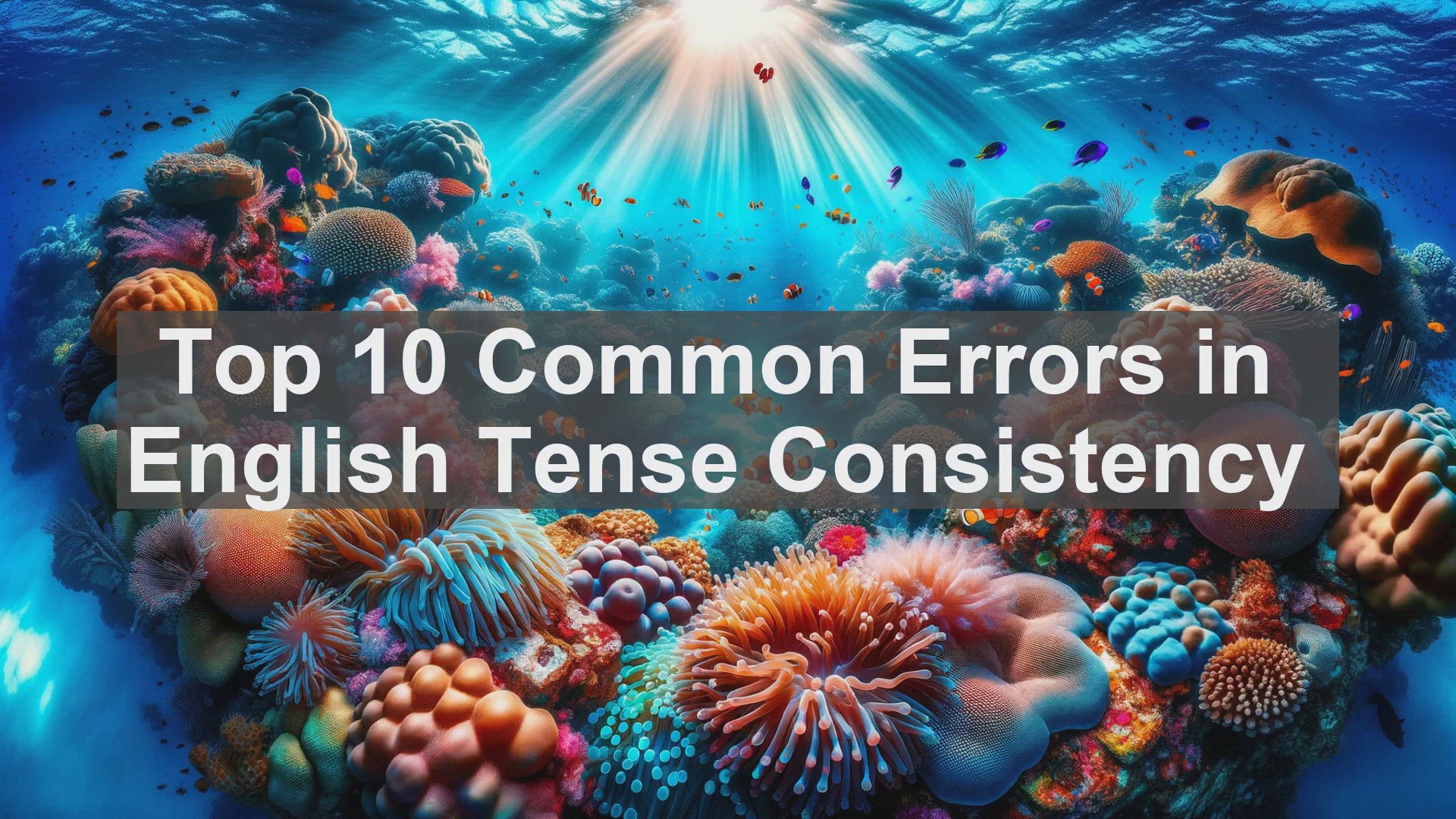
Top 10 Common Errors in English Tense Consistency
4K views · Nov 15, 2023 englishteststore.net
Top 10 Common Errors in English Tense Consistency Introduction Hello students! Today, we're going to dive into the world of English grammar and discuss a topic that often confuses many learners - tense consistency. It's crucial to maintain the correct tense throughout a sentence or paragraph to ensure clarity and coherence. In this video, we'll highlight the top 10 errors students commonly make in this area. So, let's get started! 1. Mixing Past and Present Tenses One of the most frequent errors is mixing past and present tenses within the same context. For example, saying 'Yesterday, she goes to the store' instead of 'Yesterday, she went to the store.' This inconsistency can confuse the listener or reader. Remember, when narrating a past event, stick to the past tense throughout. 2. Inconsistent Verb Forms Another common mistake is using inconsistent verb forms. For instance, saying 'I have seen that movie yesterday' instead of 'I saw that movie yesterday.' Here, the verb 'have seen' (present perfect) clashes with the past time reference 'yesterday.' To maintain consistency, use the simple past tense in such cases. 3. Shifting Between Present Simple and Present Continuous Students often shift between the present simple and present continuous tenses incorrectly. For example, saying 'I work on my project, and now I am watching TV.' Instead, it should be 'I work on my project, and now I am watching TV.' The present continuous tense is used for ongoing actions, while the present simple is for general statements or habits. 4. Inconsistent Time Expressions Using inconsistent time expressions can also lead to tense errors. For instance, saying 'Last week, I will go on vacation' instead of 'Last week, I went on vacation.' The time expression 'last week' indicates a past event, so it should be followed by the past tense verb 'went.' 5. Misusing the Future Tense The future tense can be tricky, and students often misuse it. For example, saying 'I will see you tomorrow if I see you at the party' instead of 'I will see you tomorrow if I see you at the party.' Here, the second part of the sentence should use the present simple tense ('if I see you') to maintain consistency. 6. Lack of Parallel Structure Parallel structure refers to using the same grammatical form for similar elements in a sentence. Students sometimes neglect this, leading to inconsistency. For instance, saying 'She likes swimming, to read, and hiking' instead of 'She likes swimming, reading, and hiking.' Here, the verbs 'swimming' and 'hiking' should be in the gerund form to match 'reading.' 7. Confusing Reported Speech Tenses When reporting someone's words, it's essential to use the correct tense. For example, saying 'He said he will come tomorrow' instead of 'He said he would come tomorrow.' The verb 'said' is in the past tense, so the verb 'will' should change to 'would' to maintain tense consistency. 8. Inconsistent Conditionals Conditionals can be complex, and students often struggle with maintaining consistency. For instance, saying 'If I will see her, I will tell her' instead of 'If I see her, I will tell her.' In the 'if' clause, use the present simple tense, and in the main clause, use 'will' + base verb. 9. Forgetting the Past Participle In the present perfect and past perfect tenses, it's crucial to include the past participle form of the verb. Students sometimes omit this, resulting in inconsistency. For example, saying 'I have already eat' instead of 'I have already eaten.' 10. Overusing the Present Perfect The present perfect tense is used for actions that happened in the past but have a connection to the present. However, students often overuse it. For instance, saying 'I have been to Paris last year' instead of 'I went to Paris last year.' If there's a specific past time reference, the simple past is more appropriate. Conclusion So, those are the top 10 common errors in English tense consistency. By being aware of these mistakes, you can improve your overall grammar skills and communicate more effectively. Remember, practice is key. Keep honing your language abilities, and you'll soon master this aspect of English. Thanks for watching, and see you in the next video!
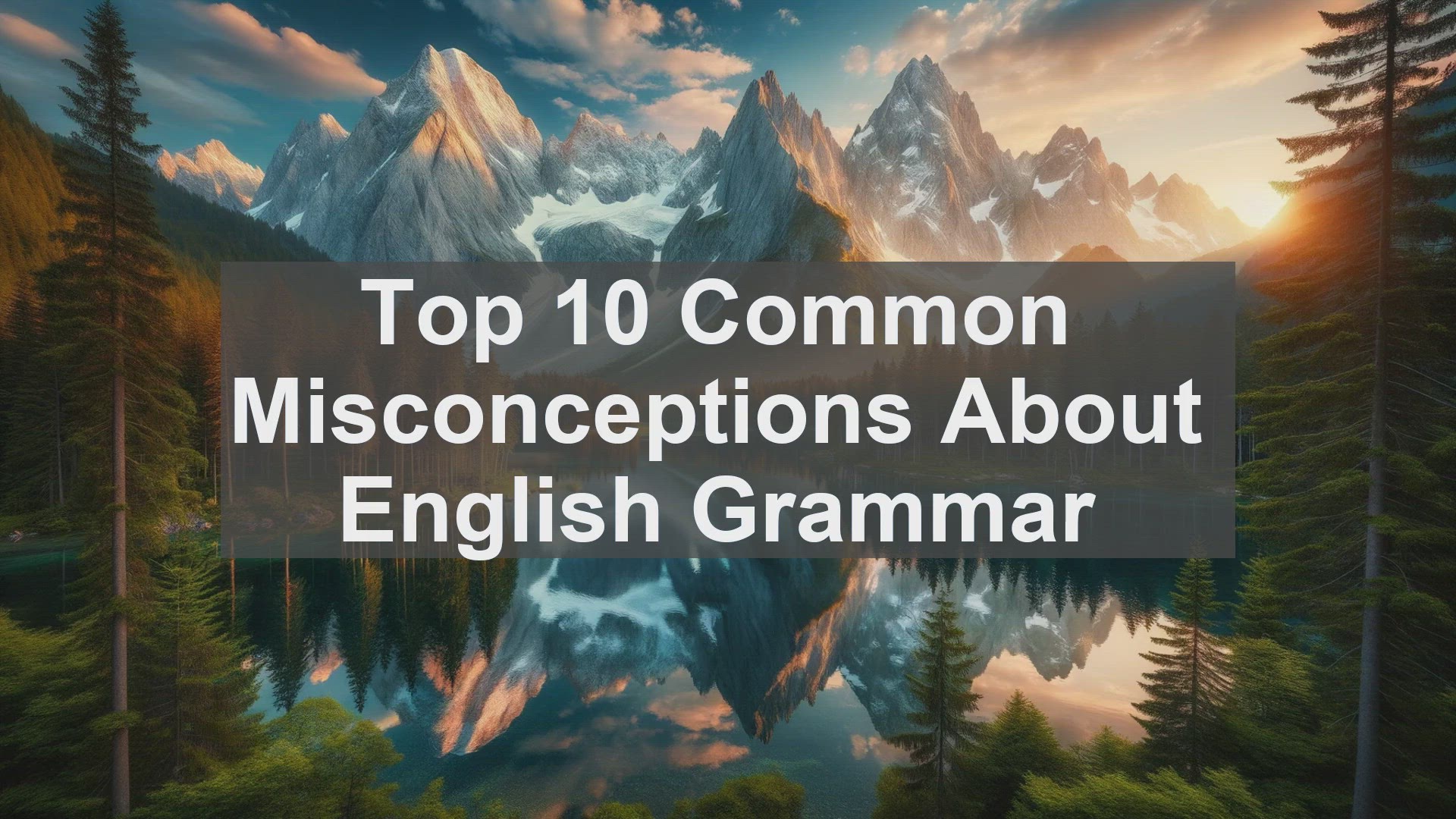
Top 10 Common Misconceptions About English Grammar
3K views · Nov 15, 2023 englishteststore.net
Top 10 Common Misconceptions About English Grammar Introduction Hello students! Today, we're going to address some common misconceptions about English grammar. Grammar can be tricky, and it's easy to fall for these misconceptions. But fear not, as we're here to set the record straight. Misconception 1: Ending a Sentence with a Preposition is Incorrect Many people believe that ending a sentence with a preposition is grammatically incorrect. However, this is a myth. While it's true that in formal writing, it's best to avoid it, in everyday speech and informal writing, it's perfectly acceptable. For example, 'What are you waiting for?' is a commonly used phrase. Misconception 2: Double Negatives are Always Wrong Double negatives, such as 'I don't know nothing,' are often seen as incorrect. However, in some dialects and informal speech, they are used for emphasis. For example, 'I can't get no satisfaction' is a line from a famous song. In standard English, though, it's best to use a single negative. Misconception 3: 'Affect' and 'Effect' are Interchangeable Many people struggle with when to use 'affect' and 'effect.' The key difference is that 'affect' is usually a verb, meaning to influence, while 'effect' is usually a noun, meaning the result. For example, 'The rain affected my mood' and 'The effect of the rain was evident.' Misconception 4: 'Their,' 'There,' and 'They're' are Interchangeable These three words may sound similar, but they have different meanings. 'Their' is possessive, indicating ownership. 'There' refers to a place or location. And 'they're' is a contraction of 'they are.' For example, 'Their house is beautiful,' 'The park is over there,' and 'They're going to the movies.' Misconception 5: 'Less' and 'Fewer' Mean the Same Thing While 'less' and 'fewer' are often used interchangeably, they have distinct uses. 'Less' is used for uncountable or abstract nouns, while 'fewer' is used for countable nouns. For example, 'There's less sugar in this recipe' and 'There are fewer students in the class.' Misconception 6: 'I' Before 'E' Except After 'C' This rule is commonly taught, but it has many exceptions. While words like 'receive' and 'believe' follow the rule, there are numerous exceptions like 'weird' and 'science.' So, it's best to memorize the spelling of individual words rather than relying solely on this rule. Misconception 7: Starting a Sentence with 'And' or 'But' is Incorrect In formal writing, it's generally advised to avoid starting a sentence with 'and' or 'but.' However, in informal writing and creative works, it can be used for stylistic effect. Just ensure it's not overused and the sentence structure is clear. Misconception 8: 'Me' is Always Incorrect as a Subject While it's true that 'me' is usually used as an object pronoun, there are instances where it can be used as a subject. For example, 'Me and my friends are going to the beach.' However, in more formal contexts, it's better to use 'I' as the subject. Misconception 9: 'Between' Should Only be Used for Two Items Although 'between' is commonly used for two items, it can also be used for more than two. When referring to multiple items individually, 'between' is appropriate. For example, 'The book is between the pen, the notebook, and the calculator.' Misconception 10: 'Irregardless' is a Proper Word Many people use 'irregardless' as a synonym for 'regardless.' However, 'irregardless' is considered nonstandard English. The correct term is simply 'regardless.' So, it's best to avoid using 'irregardless' in formal writing. Conclusion And there you have it, students! We've debunked some common misconceptions about English grammar. Remember, grammar rules can be complex, but with practice and understanding, you'll master them. If you have any more grammar queries, feel free to ask. Happy learning!

Top 10 Common Mistakes in English for Academic Presentations
7K views · Nov 15, 2023 englishteststore.net
Top 10 Common Mistakes in English for Academic Presentations Introduction: The Importance of English in Academic Presentations Hello everyone! Welcome to today's video. In the academic world, English is the lingua franca. It's essential for students to have a strong command of the language, especially during presentations. A well-delivered presentation not only showcases your knowledge but also engages the audience. However, there are several common mistakes that students often make. Let's dive in and explore them! 1. Overusing Complex Vocabulary While it's important to demonstrate your knowledge, using complex vocabulary excessively can make your presentation difficult to follow. Instead, focus on clarity and simplicity. Use technical terms when necessary, but ensure you explain them for the audience's understanding. 2. Lack of Structure A well-structured presentation is crucial. Start with an introduction, clearly state your objectives, present your main points, and conclude with a summary. This not only helps you stay organized but also aids the audience in following your ideas. 3. Reading from Slides Slides should complement your presentation, not be a substitute for it. Avoid reading directly from them. Instead, use them as visual aids, highlighting key points and providing additional information. 4. Speaking Too Fast or Too Slow Pacing is vital in a presentation. Speaking too fast can make it difficult for the audience to grasp your ideas, while speaking too slow can lead to disengagement. Practice your presentation multiple times to find the right balance. 5. Lack of Eye Contact Maintaining eye contact with the audience establishes a connection and shows confidence. Avoid constantly looking at your notes or the screen. Instead, glance at them occasionally while primarily focusing on the audience. 6. Neglecting Non-Verbal Communication Communication is not just about words. Non-verbal cues like gestures, facial expressions, and body language play a significant role. Be mindful of your posture, use appropriate gestures, and vary your facial expressions to convey your message effectively. 7. Inadequate Use of Visuals Visuals can enhance understanding and engagement. However, using too many or irrelevant visuals can be distracting. Choose visuals that are relevant, clear, and visually appealing. 8. Lack of Audience Interaction A presentation should be interactive. Encourage questions, ask for opinions, and engage the audience in discussions. This not only makes the session more dynamic but also shows your interest in their input. 9. Ignoring Time Constraints Time management is crucial. Going over the allocated time can disrupt the schedule and inconvenience the audience. Practice your presentation to ensure it fits within the given time frame. 10. Not Rehearsing Enough Rehearsal is key to a successful presentation. It not only helps you become familiar with the content but also allows you to fine-tune your delivery. Practice in front of a mirror or with a friend to get feedback. Conclusion: Enhancing Your Presentation Skills By being aware of these common mistakes and actively working to avoid them, you can significantly enhance your presentation skills. Remember, effective communication is not just about the content but also about how it's delivered. Thank you for watching, and best of luck with your future presentations!
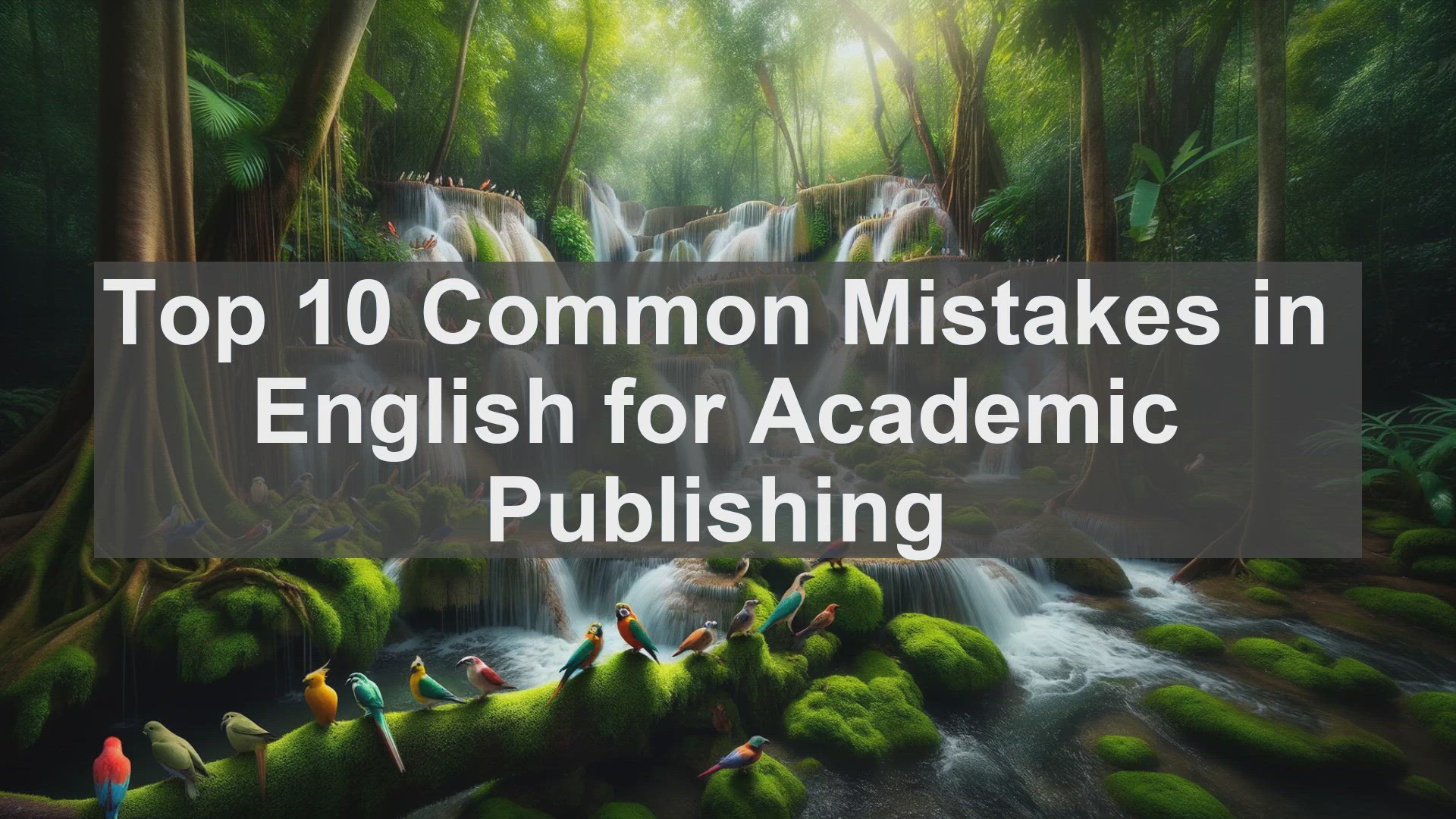
Top 10 Common Mistakes in English for Academic Publishing
2K views · Nov 15, 2023 englishteststore.net
Top 10 Common Mistakes in English for Academic Publishing Introduction Hello everyone! Welcome to our channel. Today, we have an important topic to discuss - the top 10 common mistakes in English for academic publishing. As students, it's crucial to be aware of these errors to ensure our research papers and articles are of the highest quality. So, let's dive right in! 1. Subject-Verb Agreement One of the most prevalent mistakes is the lack of agreement between the subject and verb. Remember, a singular subject requires a singular verb, and a plural subject needs a plural verb. This agreement is essential for maintaining clarity and coherence in your writing. 2. Misplaced Modifiers Misplaced modifiers can completely change the meaning of a sentence. These modifiers should be placed as close as possible to the word they are modifying. Otherwise, confusion may arise, leading to misinterpretation. 3. Inconsistent Tenses Tense consistency is crucial for maintaining a logical flow in your writing. Shifting between past, present, and future tenses without a clear reason can confuse the reader. Always ensure your tenses are consistent within a paragraph or section. 4. Lack of Parallelism Parallelism refers to using consistent grammatical structures within a sentence or a list. Lack of parallelism can make your writing sound awkward and unprofessional. Always double-check for parallelism in your sentences and lists. 5. Wordiness Academic writing should be concise and to the point. Avoid using excessive words or phrases that don't add value to your sentence. Instead, focus on conveying your message clearly and efficiently. 6. Incorrect Punctuation Punctuation plays a crucial role in conveying meaning and ensuring clarity. Misplaced commas, semicolons, or colons can change the entire meaning of a sentence. Brush up on the rules of punctuation to avoid these errors. 7. Lack of Citations Properly citing your sources is not just about avoiding plagiarism; it's also about giving credit to the original authors and providing evidence for your claims. Always follow the appropriate citation style, whether it's APA, MLA, or any other. 8. Inconsistent Capitalization Consistency in capitalization is essential for maintaining a professional appearance in your writing. Ensure you follow the appropriate rules for capitalizing headings, titles, and proper nouns. 9. Incorrect Use of Articles Articles, such as 'a', 'an', and 'the', can be tricky to use correctly. The choice of article depends on whether the noun is countable or uncountable, specific or general. Mastering the use of articles can significantly improve the clarity of your writing. 10. Lack of Proofreading Last but not least, always proofread your work before submitting it. Even the most skilled writers make mistakes, and a thorough proofreading can help catch those errors and ensure your paper is polished and error-free. Conclusion Improving your writing skills is an ongoing process, and avoiding these common mistakes is a great start. By being aware of these errors and continuously working on improving our writing, we can ensure our academic publications are of the highest quality. Thank you for watching, and we'll see you in the next video!
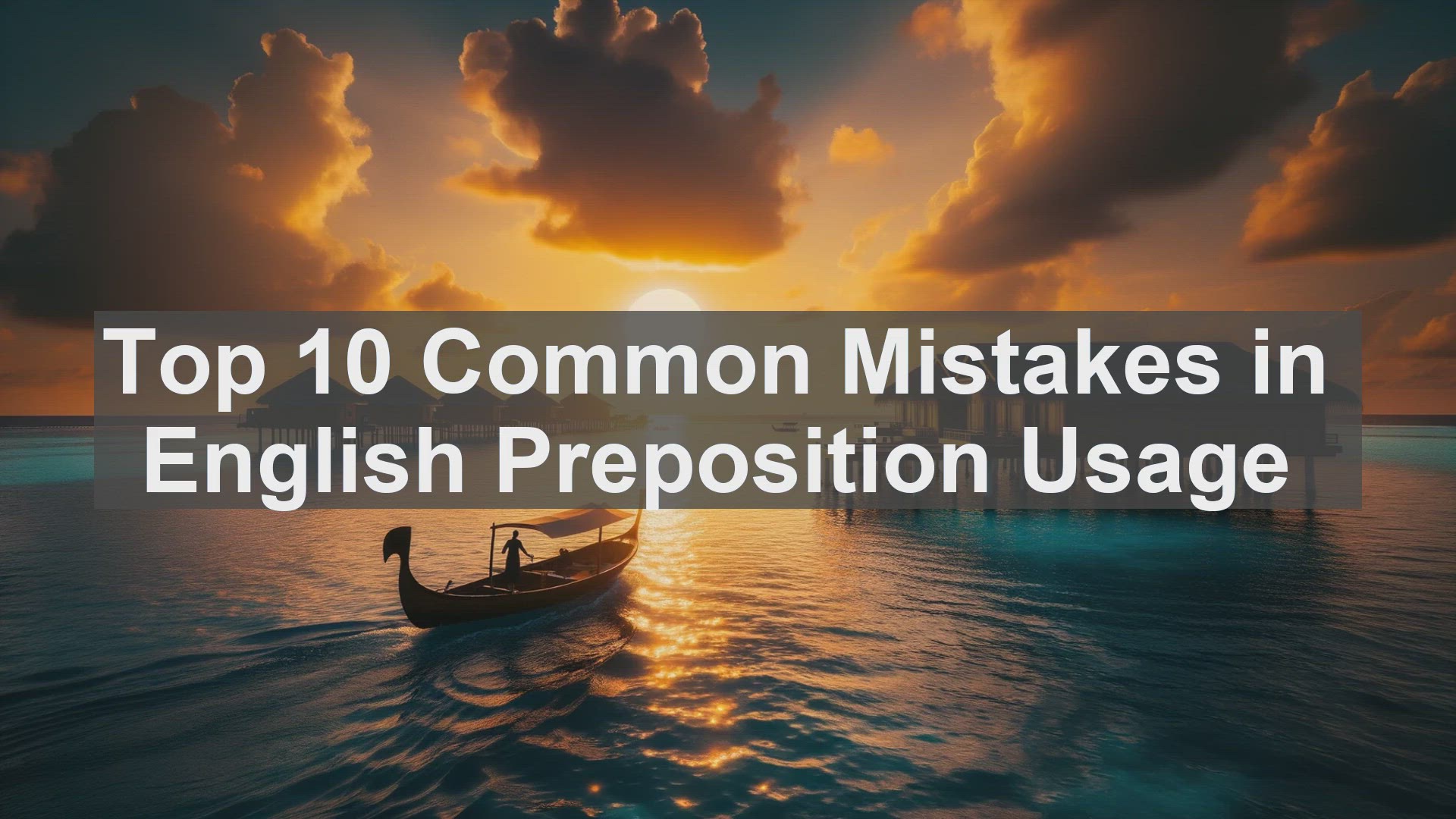
Top 10 Common Mistakes in English Preposition Usage
11K views · Nov 15, 2023 englishteststore.net
Top 10 Common Mistakes in English Preposition Usage Introduction Hello everyone! Welcome back to our English language series. Today, we'll be focusing on a topic that often confuses many learners - prepositions. While prepositions may seem simple, they can be tricky to use correctly. In this video, we'll highlight the top 10 mistakes students commonly make and provide tips to avoid them. So, let's get started! Mistake 1: Confusing 'In' and 'On' One of the most common mistakes is mixing up 'in' and 'on.' 'In' is used when something is inside or within an area, while 'on' is used when something is on a surface. For example, 'I'm in the car' and 'The book is on the table.' By understanding the context, you can choose the correct preposition. Mistake 2: Using 'At' instead of 'To' Another mistake is using 'at' instead of 'to' when indicating movement. 'At' is used to specify a location, while 'to' is used to show direction. For instance, 'I'm going to the store' instead of 'I'm going at the store.' Paying attention to the verb and its intended meaning can help you select the right preposition. Mistake 3: Omitting 'Of' after 'Couple' The word 'couple' is often followed by 'of.' For example, 'a couple of friends' or 'a couple of books.' Omitting 'of' in these phrases is incorrect. So, it's essential to include 'of' after 'couple' to maintain grammatical accuracy. Mistake 4: Confusing 'For' and 'Since' Many learners struggle with differentiating 'for' and 'since.' 'For' is used to indicate a duration, while 'since' is used to specify a starting point. For instance, 'I've been studying for two hours' and 'I've been studying since morning.' Understanding the time frame will help you choose the appropriate preposition. Mistake 5: Using 'In' instead of 'At' for Time When referring to specific times, 'at' is used instead of 'in.' For example, 'I have a meeting at 3 PM' and 'The party starts at 8 PM.' 'In' is used for more general time frames, such as 'in the morning' or 'in the evening.' Being mindful of the time context will prevent this mistake. Mistake 6: Using 'To' instead of 'For' Sometimes, learners use 'to' instead of 'for' when expressing purpose. 'To' indicates direction, while 'for' indicates purpose. For instance, 'I bought flowers for my mom' instead of 'I bought flowers to my mom.' Understanding the intention behind the action will guide your preposition choice. Mistake 7: Confusing 'In' and 'At' for Places While 'in' is used for larger areas or regions, 'at' is used for specific locations. For example, 'I live in New York' and 'I work at the bank.' Understanding the scale of the place will help you select the correct preposition. Mistake 8: Using 'On' instead of 'In' for Transportation When referring to modes of transportation, 'in' is used instead of 'on.' For instance, 'I travel in a car' and 'She's in the bus.' 'On' is used when referring to the surface of the vehicle. For example, 'The luggage is on the train.' Paying attention to the relationship between the person and the vehicle will prevent this error. Mistake 9: Using 'Of' instead of 'From' Learners sometimes use 'of' instead of 'from' when indicating origin. 'From' is used to show where something or someone starts, while 'of' indicates possession or association. For example, 'I'm from Canada' and 'The book is from the library.' Understanding the intended meaning will help you choose the correct preposition. Mistake 10: Omitting 'In' after 'Interested' When expressing interest in something, 'in' is used after 'interested.' For instance, 'I'm interested in learning Spanish' or 'She's interested in art.' Omitting 'in' in these sentences is incorrect. So, it's crucial to include 'in' after 'interested' for proper usage. Conclusion And there you have it - the top 10 common mistakes in English preposition usage. By being aware of these errors and practicing their correct usage, you can enhance your language skills. Remember, mastering prepositions takes time and practice, so don't get discouraged. Keep learning, and you'll see improvement. That's all for today's video. If you found it helpful, give it a thumbs up and share it with your friends. Subscribe to our channel for more language-related content. Thanks for watching, and see you in the next video!

Top 10 Common Mistakes in English Report Writing
7K views · Nov 15, 2023 englishteststore.net
Top 10 Common Mistakes in English Report Writing Introduction Hello everyone! Welcome to our English class. Today, we'll be diving into the world of report writing. While it may seem straightforward, there are several common mistakes that students often make. Let's explore them and learn how to avoid them. 1. Lack of Structure Reports need a clear structure, including an introduction, body paragraphs, and a conclusion. Many students overlook this, resulting in disorganized and confusing reports. Remember, a well-structured report is easier to read and understand. 2. Weak Thesis Statements The thesis statement is the backbone of your report. It should clearly state the main idea and purpose. Students often present vague or weak thesis statements, which can weaken the entire report. Take time to craft a strong and focused thesis. 3. Over-reliance on Quotes While quotes can add credibility, using too many can make your report seem like a collection of others' ideas. Your report should primarily showcase your analysis and understanding. Use quotes sparingly and always provide your own insights. 4. Lack of Evidence Claims made in your report need to be supported by evidence. This can be in the form of research, data, or examples. Without sufficient evidence, your report may appear unsubstantiated and weak. 5. Inconsistent Verb Tenses Verb tenses should be used consistently throughout your report. Shifting between past, present, and future tenses can confuse the reader. Choose a tense and stick to it, unless there's a clear reason to switch. 6. Wordiness Reports should be concise and to the point. Students often use unnecessary words and phrases, which can make the writing convoluted. Review your report and remove any redundant or repetitive language. 7. Lack of Transitions Transitions, such as 'however,' 'therefore,' and 'in addition,' help connect ideas and create a smooth flow in your report. Neglecting these can result in a disjointed and choppy piece of writing. 8. Poor Proofreading Spelling and grammar mistakes can undermine the credibility of your report. Always proofread your work, preferably after taking a break. You'll be surprised at the errors you can catch with a fresh pair of eyes. 9. Neglecting the Conclusion The conclusion is your final chance to leave a lasting impression. It should summarize the main points and provide a sense of closure. Many students rush through or even omit the conclusion, missing out on this crucial opportunity. 10. Lack of Peer Review Having someone else read and provide feedback on your report is invaluable. They can spot errors, suggest improvements, and offer a different perspective. Don't underestimate the power of peer review. Conclusion So there you have it, the top 10 common mistakes in English report writing. By being aware of these pitfalls and actively working to avoid them, you can elevate your writing skills and produce exceptional reports. Thank you for watching, and until next time, happy writing!
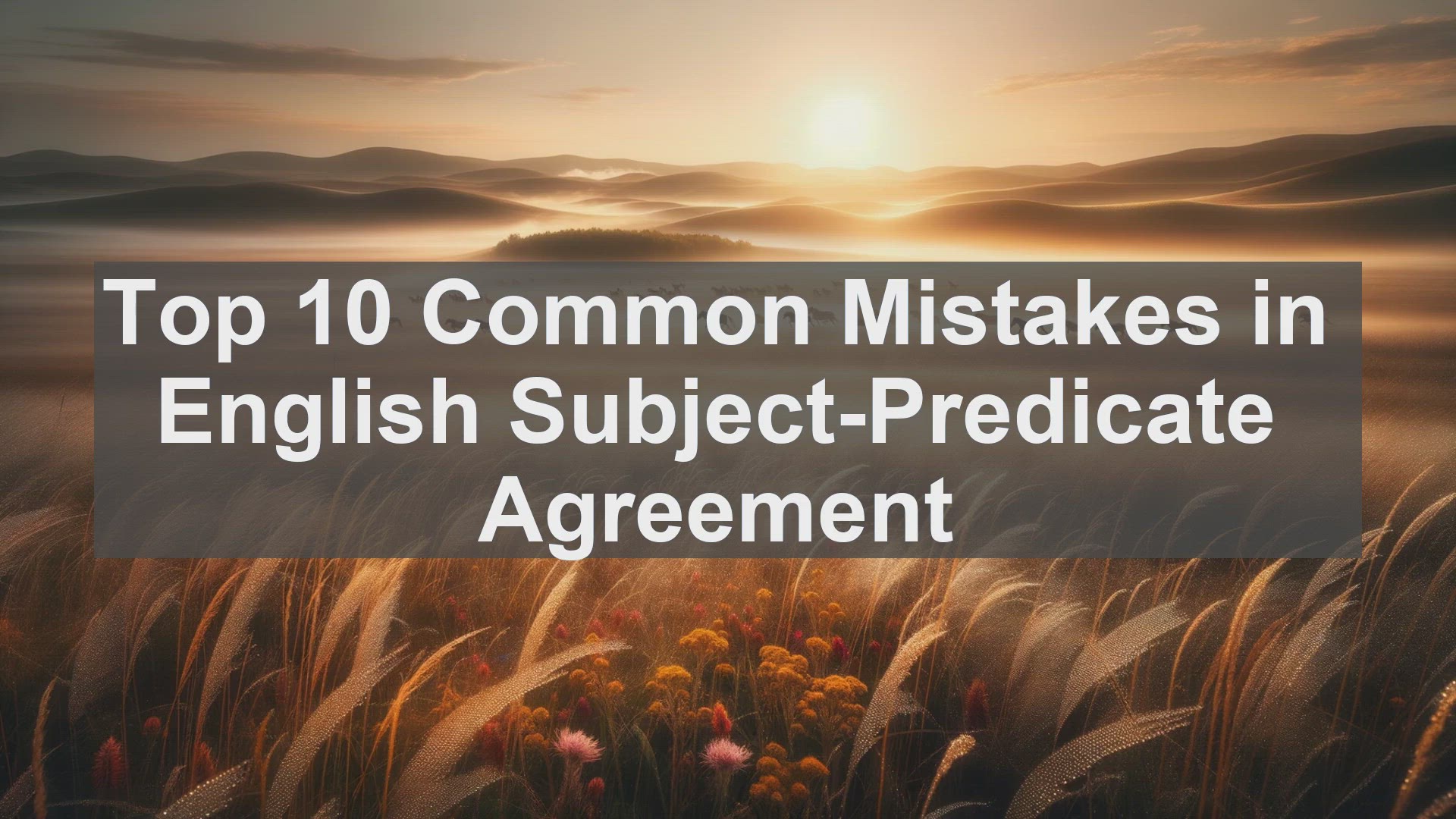
Top 10 Common Mistakes in English SubjectPredicate Agreement
6K views · Nov 15, 2023 englishteststore.net
Top 10 Common Mistakes in English Subject-Predicate Agreement Introduction: The Importance of Subject-Predicate Agreement Hello everyone! Welcome to our English grammar series. Today, we're diving into the subject-predicate agreement. It may sound complex, but it's a fundamental aspect of English grammar. Let's get started! Mistake 1: Ignoring Singular or Plural Subjects One of the most common mistakes is ignoring the number of the subject. Remember, a singular subject requires a singular predicate, and a plural subject needs a plural predicate. For example, 'The dog barks' (singular subject) and 'The dogs bark' (plural subject). Mistake 2: Confusing Indefinite Pronouns Indefinite pronouns like 'everyone,' 'someone,' or 'nobody' are singular. So, the predicate should also be singular. For instance, 'Everyone is here,' not 'Everyone are here.' Mistake 3: Misusing 'Each' and 'Every' Both 'each' and 'every' indicate singular subjects. Therefore, the predicate should be singular too. For example, 'Each student has a book,' not 'Each student have a book.' Mistake 4: Errors with 'Either...or' and 'Neither...nor' When using 'either...or' or 'neither...nor,' the verb agrees with the subject closest to it. For instance, 'Neither the cat nor the dogs are hungry.' Mistake 5: Plural Nouns as Singular Subjects Sometimes, plural nouns can act as singular subjects. In such cases, the predicate should be singular. For example, 'Politics is an interesting subject.' Mistake 6: Collective Nouns Collective nouns like 'team,' 'family,' or 'committee' can be singular or plural, depending on the context. If the group is acting as one unit, use a singular predicate. If the individuals within the group are emphasized, use a plural predicate. For instance, 'The team is playing well' (singular) and 'The team are arguing' (plural). Mistake 7: Titles, Names, and Expressions Titles, names, and expressions are usually treated as singular subjects, even if they refer to multiple people. For example, 'The Beatles is a famous band.' Mistake 8: Compound Subjects When two or more subjects are joined by 'and,' the predicate is usually plural. For instance, 'John and Sarah are studying.' However, if the subjects are referring to the same person or thing, use a singular predicate. For example, 'Bread and butter is my favorite breakfast.' Mistake 9: Intervening Phrases Intervening phrases, such as prepositional phrases, don't affect the subject-predicate agreement. The verb agrees with the subject, not the phrase. For instance, 'The book on the table belongs to me.' Mistake 10: Complex Sentences In complex sentences, the subject-predicate agreement is based on the subject of the main clause. The subordinate clauses don't impact it. For example, 'The dog that barks at night belongs to my neighbor.' Conclusion: Mastering Subject-Predicate Agreement Subject-predicate agreement is a crucial aspect of English grammar. By avoiding these common mistakes, you'll enhance your writing and speaking skills. Keep practicing, and soon, it'll become second nature. Thank you for watching, and see you in the next lesson!

Top 10 Common Mistakes in English Syntax for Bloggers
5K views · Nov 15, 2023 englishteststore.net
Top 10 Common Mistakes in English Syntax for Bloggers Introduction: The Importance of Proper Syntax in Blogging Hello everyone! Welcome to our English class. Today, we're going to talk about a crucial aspect of writing: syntax. Whether you're writing a blog post, an article, or even a social media caption, using the correct syntax is essential for conveying your message clearly and effectively. Incorrect syntax can lead to confusion, misinterpretation, and even a loss of credibility. So, let's explore the top 10 common mistakes in English syntax that bloggers should be aware of. 1. Subject-Verb Agreement One of the most common mistakes bloggers make is the mismatch between the subject and the verb. For example, saying 'The group of students is going' instead of 'The group of students are going.' In this case, 'group' is the subject, and 'are' should be used instead of 'is' because 'group' refers to multiple students. To avoid this mistake, always ensure that the verb agrees with the subject in terms of singular or plural form. 2. Misplaced Modifiers Modifiers, such as adjectives and adverbs, provide additional information about a noun or a verb. However, placing them incorrectly can change the meaning of a sentence. For instance, saying 'Only she ate the cake' instead of 'She only ate the cake.' In the first sentence, 'only' implies that she was the only one who ate the cake, while in the second sentence, it means she did nothing else with the cake. So, be careful with the placement of modifiers to convey your intended meaning accurately. 3. Run-on Sentences Run-on sentences occur when two or more independent clauses are joined without proper punctuation or conjunctions. They can make your writing confusing and difficult to read. To fix a run-on sentence, you can either separate the clauses into individual sentences or use appropriate punctuation, such as a comma and a coordinating conjunction. For example, 'I love to write, I find it therapeutic' can be corrected as 'I love to write. I find it therapeutic' or 'I love to write, and I find it therapeutic.' 4. Lack of Parallelism Parallelism is the use of consistent grammatical structures in a sentence. When items in a list or a series are not parallel, it can create confusion. For instance, saying 'She likes hiking, to swim, and reading' instead of 'She likes hiking, swimming, and reading.' In the correct version, all the items are in the same form, which makes the sentence flow better. So, when creating a list, ensure that the elements are parallel in structure. 5. Double Negatives Double negatives, which involve the use of two negative words in a sentence, can lead to ambiguity. For example, saying 'I don't know nothing' instead of 'I don't know anything.' The correct version uses a single negative word to convey the intended meaning. So, avoid using double negatives to ensure clarity in your writing. 6. Incorrect Pronoun Usage Using the wrong pronoun can cause confusion and disrupt the flow of your writing. For instance, saying 'Everyone should bring their own book' instead of 'Everyone should bring his or her own book.' In this case, 'everyone' is singular, so the pronoun 'his or her' should also be singular. To avoid this mistake, make sure the pronoun agrees with its antecedent in terms of number and gender. 7. Lack of Consistency in Verb Tenses Consistency in verb tenses is crucial for maintaining the clarity and coherence of your writing. Mixing past, present, and future tenses within a sentence or a paragraph can confuse the reader. So, choose a specific tense and stick to it unless there's a clear reason to switch. If you need to indicate a change in time, use appropriate transition words or phrases. 8. Confusing Comparative and Superlative Forms When making comparisons, it's important to use the correct comparative or superlative form of an adjective or an adverb. For example, saying 'She is the more talented of the two' instead of 'She is the most talented of the two.' In this case, 'most' should be used because the comparison is between more than two people. So, pay attention to the context and choose the appropriate form accordingly. 9. Lack of Agreement between Pronouns and Antecedents An antecedent is the noun or pronoun that a pronoun refers to. It's essential to ensure that there's agreement between the pronoun and its antecedent in terms of number and gender. For instance, saying 'A writer should always proofread their work' instead of 'A writer should always proofread his or her work.' In this case, 'writer' is singular, so the pronoun 'his or her' should also be singular. 10. Wordiness and Redundancy Using excessive words or repeating the same information in different ways can make your writing verbose and less engaging. It's important to be concise and eliminate any unnecessary repetition. For example, saying 'She is a very talented and gifted writer' can be simplified as 'She is a talented writer.' So, always review your writing and remove any redundant or wordy phrases. Conclusion: Mastering English Syntax for Better Blogging By being aware of these common mistakes in English syntax and actively working to avoid them, you can significantly improve the quality of your blog posts. Remember, writing is a continuous learning process, and even experienced bloggers can make these errors. The key is to be vigilant, proofread your work, and seek feedback from others. With time and practice, you'll become more proficient in English syntax, and your writing will become more polished and effective. Thank you for watching, and happy blogging!

Top 10 Common Mistakes in English Verb Form Usage
17K views · Nov 15, 2023 englishteststore.net
Top 10 Common Mistakes in English Verb Form Usage Introduction Hello everyone! Welcome to our English language series. Today, we'll be diving into the realm of verb forms. While English verb forms may seem straightforward, there are several common mistakes that even advanced learners make. Let's explore them! 1. Subject-Verb Agreement One of the most prevalent errors is subject-verb agreement. It's crucial to ensure that the verb matches the subject in number. For example, 'He go' should be 'He goes' since 'he' is singular. 2. Incorrect Tense Usage Using the wrong tense can alter the meaning of a sentence. For instance, 'I have seen him yesterday' should be 'I saw him yesterday' since 'yesterday' refers to a specific past moment. 3. Irregular Verb Forms English has numerous irregular verbs, and their past and past participle forms don't follow a set pattern. For example, 'go' becomes 'went' in the past tense, not 'goed'. 4. Missing Auxiliary Verbs Auxiliary verbs are essential for constructing grammatically correct sentences. 'She going to the store' should be 'She is going to the store' since 'is' is the auxiliary verb here. 5. Incorrect Use of Gerunds and Infinitives Using gerunds ('-ing' form) or infinitives ('to' + base form) incorrectly can lead to confusion. For example, 'I enjoy to swim' should be 'I enjoy swimming'. 6. Misuse of Modal Verbs Modal verbs, like 'can', 'should', or 'must', have specific meanings and usage. 'I can to swim' should be 'I can swim' since 'can' already implies the ability. 7. Confusing Active and Passive Voice Active voice emphasizes the subject performing the action, while passive voice emphasizes the action itself. 'She was bit by the dog' should be 'The dog bit her' to switch to active voice. 8. Wrong Word Order in Questions In English, the word order changes in questions. 'You are coming?' should be 'Are you coming?' with the subject and auxiliary verb inverted. 9. Overusing the Present Continuous The present continuous ('-ing' form) is used for ongoing actions. 'I am having a car' should be 'I have a car' since owning a car is a state, not an action. 10. Lack of Consistency in Verb Forms Maintaining consistency in verb forms is crucial. 'I like swimming, but she to dance' should be 'I like swimming, but she likes to dance'. Conclusion And there you have it! The top 10 common mistakes in English verb form usage. By being aware of these errors and practicing, you'll gradually improve your language skills. Remember, learning a language is a journey, and every step counts. Keep up the great work, and see you in the next video!

Top 10 Common Mistakes in English Verb Usage
3K views · Nov 15, 2023 englishteststore.net
Top 10 Common Mistakes in English Verb Usage Introduction: The Importance of Verbs Hello everyone! Welcome to today's video, where we'll be diving into the world of English verbs. Verbs are the backbone of any sentence, and using them correctly is crucial for effective communication. Unfortunately, there are several common mistakes that even advanced learners tend to make. So, let's get started and unravel these verb-related challenges! 1. Subject-Verb Agreement One of the most fundamental aspects of verb usage is ensuring that the verb agrees with its subject in terms of number. For example, 'He runs' is correct, while 'He run' is not. This mistake often occurs when the subject is a collective noun or when there are intervening phrases between the subject and the verb. To avoid this, always double-check that the verb matches the subject's number. 2. Verb Tense Consistency Maintaining consistent verb tenses is essential for clarity and coherence in your writing. A common error is shifting between past and present tense within the same paragraph or sentence. To avoid this, decide on the appropriate tense for your narrative or description and stick to it throughout. 3. Using 'Do' as an Auxiliary Verb In English, 'do' is often used as an auxiliary verb to form questions and negatives. However, it should not be used as a regular verb in affirmative statements. For instance, instead of saying 'I do my homework,' it should be 'I complete my homework.' This mistake is particularly common among non-native speakers. 4. Distinguishing 'Lay' and 'Lie' The verbs 'lay' and 'lie' are often confused. 'Lay' requires an object and means to put or place something down, while 'lie' means to recline or be in a resting position. So, you would say 'I lay the book on the table' but 'I lie down on the bed.' Mixing up these verbs can lead to incorrect usage. 5. Misusing 'Bring' and 'Take' Similar to 'lay' and 'lie,' 'bring' and 'take' are frequently interchanged. 'Bring' implies movement towards the speaker, while 'take' suggests movement away. For example, 'Please bring the documents to my office' and 'I'll take the package to the post office.' Swapping these verbs can result in confusion. 6. Overusing 'Get' While 'get' is a versatile verb, it is often overused, leading to imprecise or vague language. Instead of relying on 'get,' consider more specific alternatives like 'obtain,' 'acquire,' 'receive,' or 'become.' This will enhance the clarity and richness of your writing. 7. Confusing 'Affect' and 'Effect' The difference between 'affect' and 'effect' can be tricky. 'Affect' is usually a verb, indicating influence or change, while 'effect' is commonly a noun, referring to the result or consequence. For instance, 'The weather affected our plans' and 'The storm had a significant effect on the town.' Mixing up these words can lead to grammatical errors. 8. Using 'Good' instead of 'Well' Although 'good' is an adjective, it is often mistakenly used to modify verbs. The correct adverb form is 'well.' For example, 'She sings well' instead of 'She sings good.' Paying attention to this distinction will improve the accuracy of your spoken and written English. 9. Neglecting the 'S' in Third Person Singular In the present simple tense, verbs used with third person singular subjects (he, she, it) require an 's' at the end. For instance, 'She walks to work' or 'He eats breakfast every morning.' Omitting this 's' is a common error, particularly for non-native speakers. 10. Forgetting the 'ED' in Past Tense Regular verbs in the past tense are formed by adding 'ed' to the base form. For example, 'talk' becomes 'talked,' and 'walk' becomes 'walked.' Neglecting this 'ed' ending is a common oversight, resulting in incorrect verb usage. Conclusion: Mastering Verbs in English And there you have it – the top 10 common mistakes in English verb usage. By being aware of these errors and practicing their correct usage, you'll significantly enhance your English language skills. Remember, verbs are not just words; they're the key to effective communication. So, keep learning, keep practicing, and soon, you'll be a master of English verbs. Thanks for watching, and see you in the next video!

Top 10 Common Mistakes in Using English for Public Relations
1K views · Nov 15, 2023 englishteststore.net
Top 10 Common Mistakes in Using English for Public Relations Introduction Hello everyone! Welcome to today's video. Today, we'll be discussing the top 10 common mistakes students often make while using English for public relations. Effective communication is vital in the professional world, and avoiding these errors will help you make a lasting impression. So, let's dive right in! 1. Overusing Jargon While jargon can be useful in certain contexts, overusing it can alienate your audience. Remember, not everyone may be familiar with industry-specific terms. Strive for a balance between professional language and simplicity. 2. Neglecting Proofreading A simple spelling or grammar mistake can undermine your credibility. Always proofread your work, or better yet, have someone else do it. Fresh eyes can often catch errors you might have missed. 3. Ignoring Cultural Sensitivities In a globalized world, it's crucial to be aware of cultural sensitivities. What may be acceptable in one culture could be offensive in another. Take the time to understand your audience's cultural background. 4. Lack of Clarity Ambiguity can lead to misunderstandings. Be clear and concise in your communication. Avoid long, convoluted sentences and get straight to the point. 5. Inconsistent Tone Maintaining a consistent tone throughout your communication is essential. Whether it's a formal email or a social media post, your tone should reflect your brand's values and personality. 6. Poor Email Etiquette Emails are a common mode of communication in PR. Ensure your emails are professional, well-structured, and free from any typos. Use proper salutations and sign-offs. 7. Lack of Research Before reaching out to the media or stakeholders, thorough research is a must. Know who you're contacting, their interests, and how your message aligns with their needs. 8. Overlooking Follow-ups A single email or message may not always be enough. Following up shows your commitment and can help ensure your message doesn't get lost in a busy inbox. 9. Neglecting Social Media Presence Social media is a powerful tool in PR. Regularly updating your profiles, engaging with your audience, and sharing relevant content can significantly enhance your brand's visibility. 10. Lack of Active Listening Communication is a two-way street. Actively listening to your audience's feedback, concerns, or questions is crucial. It shows that you value their input and are committed to addressing their needs. Conclusion And there you have it! The top 10 common mistakes in using English for public relations. By being mindful of these errors and working towards improving them, you can enhance your communication skills and make a lasting impression in the professional world. Thank you for watching, and see you in the next video!

Top 10 Common Mistakes in Using English Tenses
13K views · Nov 15, 2023 englishteststore.net
Top 10 Common Mistakes in Using English Tenses Introduction Hello everyone! Welcome back to our English language series. Today, we have an important topic to discuss - the common mistakes students often make while using English tenses. Tenses play a crucial role in conveying the right meaning and time frame in a sentence. Let's dive in and explore the top 10 mistakes you should avoid. 1. Mixing Present Simple and Present Continuous One of the most common errors is mixing the present simple and present continuous tenses. The present simple is used for general facts or routines, while the present continuous is for ongoing actions. For example, 'I play tennis every Sunday' (present simple) and 'I am playing tennis right now' (present continuous). Mixing them can lead to confusion in the intended message. 2. Incorrect Use of Past Simple and Present Perfect The past simple is used for completed actions in the past, while the present perfect is for actions that have a connection to the present. For instance, 'I visited Paris last year' (past simple) and 'I have visited Paris several times' (present perfect). Using the wrong tense can distort the timeline and meaning of the sentence. 3. Overusing the Future Simple The future simple, often formed with 'will,' is used for predictions or decisions made at the moment of speaking. However, many students tend to overuse it. Instead, consider using other future forms like 'going to' or 'present continuous' when appropriate. For example, 'I will call you later' (future simple) and 'I am meeting her tomorrow' (present continuous). 4. Neglecting the Present Perfect Continuous While the present perfect continuous might seem complex, it is essential for expressing actions that started in the past, continue in the present, and might continue in the future. For instance, 'I have been studying for three hours.' Neglecting this tense can result in incomplete or incorrect information. 5. Misusing 'Used to' and 'Would' Both 'used to' and 'would' are used to talk about past habits or states. However, 'used to' is used for more permanent situations, while 'would' is for specific actions or events. For example, 'I used to live in London' (habitual) and 'Every summer, we would go to the beach' (specific action). Misusing them can lead to confusion or incorrect meaning. 6. Confusing 'Will' and 'Going to' While both 'will' and 'going to' can be used for future actions, there are subtle differences. 'Will' is for instant decisions or predictions, while 'going to' is for pre-planned or expected actions. For instance, 'I will help you' (instant decision) and 'I am going to visit my grandparents next week' (pre-planned). Understanding these nuances is crucial for accurate communication. 7. Incorrect Use of 'Since' and 'For' 'Since' and 'for' are commonly used with the present perfect tense. 'Since' indicates the starting point of an action, while 'for' indicates the duration. For example, 'I have been studying since morning' (starting point) and 'I have been studying for three hours' (duration). Using them interchangeably can lead to incorrect information. 8. Neglecting the Past Perfect The past perfect is used to express an action that happened before another action in the past. For instance, 'I had already eaten when she arrived.' Neglecting this tense can result in a lack of clarity about the sequence of events. 9. Using 'Will' for Future Predictions While 'will' can be used for future predictions, it is more appropriate to use 'going to' or the present continuous for things that are planned or have evidence. For example, 'It's cloudy. It's going to rain' or 'The train leaves at 9. We are leaving early.' This ensures more accuracy in conveying the intended meaning. 10. Ignoring the Conditional Tenses Conditional tenses, like the first conditional ('If + present simple, will + base verb'), are used to express possibilities or hypothetical situations. Ignoring them can limit your ability to communicate potential outcomes. For instance, 'If it rains, we will stay indoors.' Conclusion So, there you have it - the top 10 common mistakes in using English tenses. By being aware of these errors and practicing the correct usage, you can significantly improve your English language skills. Remember, tenses are not just about grammar; they are essential for effective communication. Thank you for watching, and see you in the next lesson!

Top 10 Confusing English Word Pairs and How to Distinguish T...
1K views · Nov 15, 2023 englishteststore.net
Top 10 Confusing English Word Pairs and How to Distinguish Them Introduction: The Complexity of English English, with its rich vocabulary and nuanced grammar, can be a challenging language to master. One of the reasons for this is the presence of numerous word pairs that, at first glance, seem interchangeable. However, each pair has its own distinct meaning and usage. In this video, we'll explore 10 such word pairs, providing you with clear differentiators and practical examples. 1. Affect vs. Effect Affect is usually a verb, meaning to influence or produce a change. Effect, on the other hand, is commonly a noun, denoting the result or consequence of an action. For example, 'The rain affected my mood' and 'The effect of the rain was evident in the flooded streets.' 2. Complement vs. Compliment Complement, with an 'e,' refers to something that completes or enhances another thing. Compliment, with an 'i,' is an expression of praise or admiration. So, you might say, 'The red curtains complement the furniture' or 'She received many compliments on her performance.' 3. Accept vs. Except Accept means to receive or agree to something, while except indicates exclusion or exclusion. For instance, 'I accept your invitation' and 'Everyone is going, except for John.' 4. Allusion vs. Illusion An allusion is an indirect reference, often to a literary work or historical event. On the other hand, an illusion is something that deceives the senses or perception. Consider the sentences, 'The author made an allusion to Shakespeare's play' and 'The magician created an illusion of levitation.' 5. Principal vs. Principle Principal, when used as a noun, refers to the head of a school or an important person. As an adjective, it means primary or most significant. Principle, with an 'e,' is a fundamental truth or belief. For example, 'The principal addressed the students' and 'She adheres to a strict set of principles.' 6. Stationary vs. Stationery Stationary, with an 'a,' means not moving or fixed in one place. Stationery, with an 'e,' refers to writing materials. So, you might say, 'The car remained stationary for hours' and 'I bought some new stationery for my office.' 7. Capital vs. Capitol Capital, with an 'a,' can refer to a city that serves as the seat of government or financial resources. Capitol, with an 'o,' specifically denotes a building where a legislative body meets. For instance, 'Washington, D.C. is the capital of the United States' and 'The protestors gathered outside the capitol building.' 8. Advice vs. Advise Advice, with a 'c,' is a noun, meaning a suggestion or recommendation. Advise, with an 's,' is the corresponding verb, indicating the act of giving advice. Consider the sentences, 'She gave me some valuable advice' and 'I advise you to reconsider your decision.' 9. Desert vs. Dessert Desert, with one 's,' can refer to a barren, arid land. Dessert, with two 's,' is the sweet course typically served after a meal. So, you might say, 'The Sahara is the largest desert in the world' and 'I'm looking forward to having some chocolate dessert.' 10. Farther vs. Further Farther refers to physical distance. For example, 'The supermarket is farther than I thought.' Further, on the other hand, can denote additional extent or advancement in a non-physical sense. So, you might say, 'We need to further investigate the matter.' Conclusion: Building Your Word Power By understanding the distinctions between these word pairs, you're not only enriching your vocabulary but also enhancing your overall communication skills. Remember, practice and exposure to diverse contexts are key to mastering any language. So, keep exploring, keep learning, and soon, you'll find yourself navigating the complexities of English with confidence. Thank you for watching!

Top 10 Common Mistakes in English Article Usage A An The
1K views · Nov 15, 2023 englishteststore.net
Top 10 Common Mistakes in English Article Usage (A, An, The) Introduction: The Importance of Articles Hello everyone! Welcome to today's lesson on English article usage. Articles are small words, but they play a significant role in sentence construction. They help us specify whether we are talking about something in general or referring to a specific item. Let's dive into the top 10 mistakes students often make with articles. 1. Using 'A' Instead of 'An' (and Vice Versa) The rule is simple: use 'a' before words that start with a consonant sound and 'an' before words that start with a vowel sound. For example, it's 'a cat' and 'an apple.' However, many students mistakenly use 'a' before words starting with a vowel sound, like 'a orange.' Remember, it's 'an orange.' 2. Omitting 'The' with Unique or Definite Nouns When we talk about something unique or definite, we use 'the.' For instance, 'the sun,' 'the moon,' or 'the President.' However, students often omit 'the' in such cases, saying 'sun' or 'moon.' Remember, 'the' is essential when referring to something specific. 3. Using 'The' with Non-Specific Nouns On the other hand, 'the' is not used with non-specific nouns. For example, 'I saw a dog' (not 'the dog') implies any dog, not a specific one. Students sometimes mistakenly use 'the' in such cases, leading to confusion. 4. Using 'The' with Plural Nouns in General Statements When making general statements about plural nouns, we don't use 'the.' For example, 'Dogs are loyal' (not 'The dogs are loyal'). Students often add 'the' in such cases, which is incorrect. 5. Using 'The' with Names of Countries, Cities, and Languages In most cases, we don't use 'the' before the names of countries, cities, or languages. For example, it's 'I visited France' (not 'I visited the France'). However, there are exceptions, like 'the United States' or 'the Netherlands.' Students sometimes struggle with this rule. 6. Using 'The' with Meals, Days, and Times We use 'the' when referring to specific meals, days, or times. For example, 'I had breakfast' (not 'I had the breakfast'). However, when talking about these in a general sense, 'the' is not used. For instance, 'I like to have breakfast in the morning.' Students often confuse these two usages. 7. Using 'The' with Means of Transportation In general, we don't use 'the' before means of transportation, like 'car,' 'bus,' or 'train.' For example, 'I take the bus to work' (not 'I take the the bus to work'). However, there are exceptions, like 'the subway' or 'the tram.' Students should be aware of these exceptions. 8. Omitting 'A' or 'An' with Singular Countable Nouns Every singular countable noun requires an article before it. For example, 'I saw a cat' (not 'I saw cat'). Students sometimes omit the article, leading to incorrect sentences. 9. Using 'A' or 'An' with Uncountable Nouns Uncountable nouns, like 'water' or 'information,' don't require 'a' or 'an' before them. For example, 'I need water' (not 'I need a water'). Students often make this mistake, especially when using uncountable nouns as countable ones. 10. Using 'A' or 'An' with Plural Nouns Plural nouns don't require 'a' or 'an' before them. For example, 'I have cats' (not 'I have a cats'). This mistake is common among students who confuse the usage of articles with singular and plural nouns. Conclusion: Mastering Article Usage Articles are an integral part of English grammar, and mastering their usage is crucial for effective communication. By avoiding these common mistakes, you can enhance your language skills and convey your thoughts accurately. Keep practicing, and soon, using articles correctly will become second nature to you. Thank you for joining today's lesson!

Top 10 Effective Vocabulary Teaching Strategies for Educator...
16K views · Nov 15, 2023 englishteststore.net
Top 10 Effective Vocabulary Teaching Strategies for Educators Introduction: The Power of Words Hello everyone! Welcome to today's video, where we'll be discussing the top 10 effective vocabulary teaching strategies. Words are the building blocks of communication, and having a rich vocabulary is essential for expressing ourselves. As educators, it's our responsibility to equip students with the tools they need to succeed in this aspect. So, let's dive in! 1. Contextual Learning One of the most effective ways to learn new words is through context. Instead of rote memorization, encourage students to understand words in the context of sentences or passages. This not only aids in comprehension but also helps with retention. 2. Word Associations Our brains are wired to make connections. By associating new words with familiar ones, students can easily recall them when needed. For example, linking 'meticulous' with 'detail-oriented' or 'pensive' with 'thoughtful'. 3. Visual Aids A picture is worth a thousand words, and it holds true in vocabulary learning as well. Incorporate visual aids like images, charts, or even videos to provide a visual representation of the word's meaning. This makes the learning process more engaging and memorable. 4. Vocabulary Games Learning doesn't have to be monotonous. Introduce vocabulary games like 'Word Bingo' or 'Vocabulary Puzzles' to make it fun. These interactive activities not only promote active learning but also foster healthy competition among students. 5. Word Journals Encourage students to maintain a word journal, where they can jot down new words they come across. This not only helps in revision but also serves as a personal vocabulary bank that they can refer to in the future. 6. Real-World Connections Learning doesn't just happen within the four walls of a classroom. Encourage students to explore the real world and make connections with the vocabulary they've learned. For example, identifying new words in a newspaper article or during a museum visit. 7. Regular Review Consistency is key when it comes to vocabulary learning. Set aside dedicated time for regular review sessions, where students can revise previously learned words. This helps in reinforcing the knowledge and prevents it from fading away over time. 8. Multisensory Approach Everyone has different learning styles. By incorporating a multisensory approach, you cater to the needs of all students. For example, while teaching a word, you can say it aloud, write it on the board, and have students repeat it. 9. Word of the Day Introduce a 'Word of the Day' concept in your classroom. Each day, focus on a new word, discussing its meaning, usage, and even its etymology. This not only expands the students' vocabulary but also instills a love for language. 10. Encourage Reading Reading is a treasure trove of vocabulary. Encourage students to read extensively, be it books, articles, or even blogs. Exposure to different genres and writing styles exposes them to a wide range of words, enriching their language skills. Conclusion: Empowering Students with Words And that brings us to the end of our list. These 10 strategies, when implemented effectively, can transform the way students approach vocabulary learning. Remember, words have the power to inspire, persuade, and connect. As educators, we have the privilege of nurturing this linguistic potential. Thank you for watching, and until next time, keep learning and keep expanding your vocabulary!
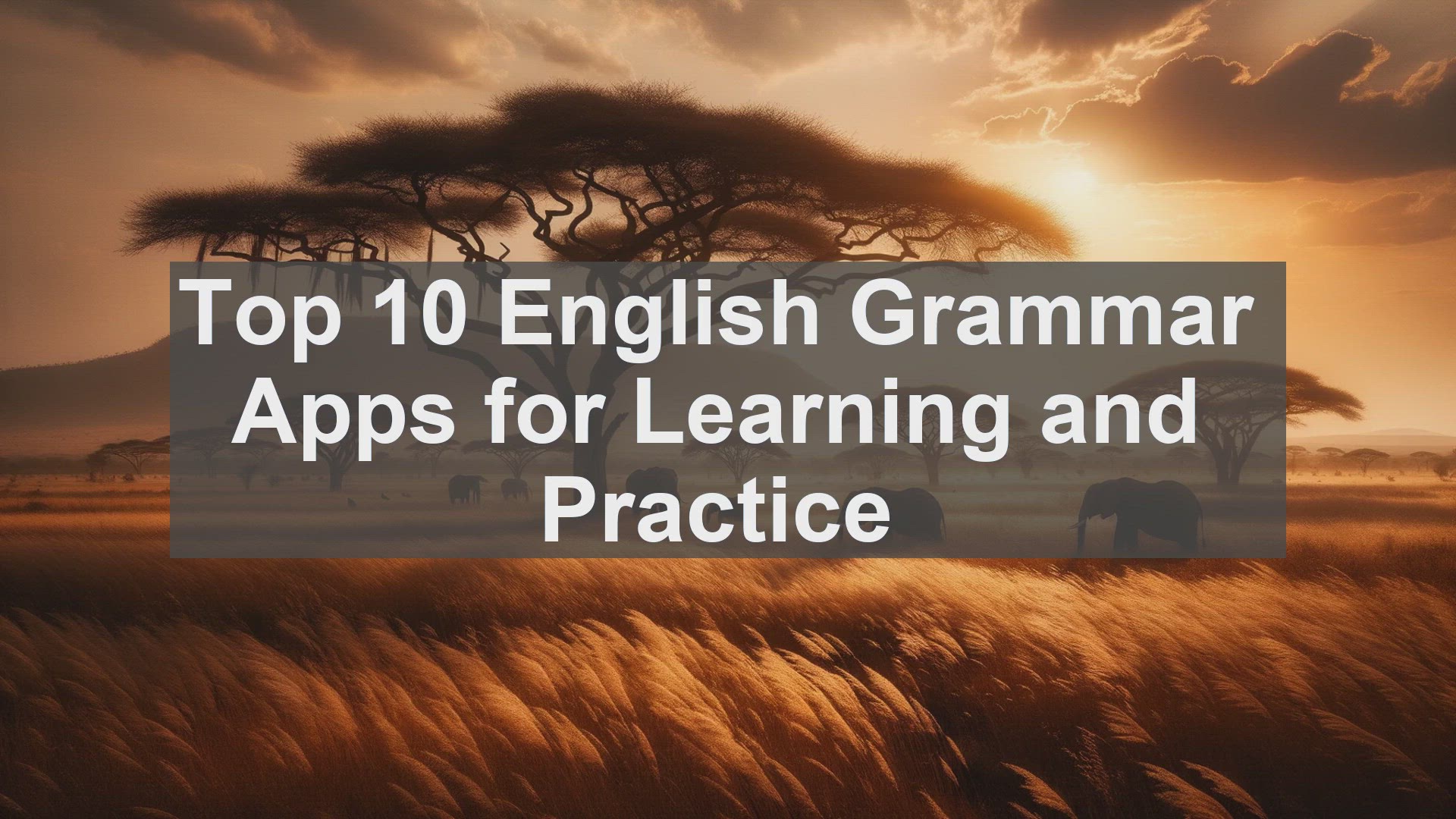
Top 10 English Grammar Apps for Learning and Practice
2K views · Nov 15, 2023 englishteststore.net
Top 10 English Grammar Apps for Learning and Practice Introduction: The Importance of English Grammar Hello everyone! Welcome to today's video, where we'll be exploring the world of English grammar apps. As you know, grammar forms the foundation of any language, and English is no exception. Whether you're a beginner or an advanced learner, having a strong grasp of grammar is crucial for effective communication. And what better way to enhance your grammar skills than through the convenience of a mobile app? Today, we'll be counting down the top 10 English grammar apps that have received rave reviews from students worldwide. So, without further ado, let's dive in! 1. Duolingo: The All-Rounder Starting off our list is Duolingo, a name that's synonymous with language learning. While it's known for its comprehensive approach to learning a new language, Duolingo also offers an excellent grammar course. With its gamified interface and bite-sized lessons, Duolingo makes grammar learning fun and engaging. Plus, it's completely free, making it an ideal choice for budget-conscious students. 2. Grammarly: Your Writing Companion Next up, we have Grammarly, a must-have app for anyone looking to improve their writing skills. Grammarly not only corrects your grammar but also provides detailed explanations for each correction. Its user-friendly interface and compatibility with various platforms make it a favorite among students. Whether you're writing an essay or an email, Grammarly ensures your content is error-free and polished. 3. Babbel: Grammar in Context Babbel, known for its interactive language courses, also offers a dedicated grammar course. What sets Babbel apart is its focus on real-life conversations. The grammar lessons are designed in a way that you learn grammar while also understanding its usage in everyday situations. So, if you're someone who wants to learn grammar in context, Babbel is the app for you. 4. Oxford Grammar and Punctuation For those who prefer a more traditional approach to grammar learning, the Oxford Grammar and Punctuation app is a treasure trove of knowledge. Developed by experts, this app provides detailed explanations, examples, and quizzes for each grammar rule. It's like having a grammar book in your pocket, but with the added advantage of interactive exercises. 5. HelloTalk: Learn Grammar through Conversations If you believe in the power of conversations for language learning, HelloTalk is the app for you. While it's primarily a language exchange platform, HelloTalk also offers grammar correction features. You can chat with native speakers, and they'll help you improve your grammar by providing instant corrections. It's like having a language partner and a grammar tutor in one app! 6. Memrise: Grammar Made Memorable Memrise is known for its innovative approach to language learning, and its grammar courses are no exception. With its mnemonic techniques and spaced repetition system, Memrise ensures that grammar rules stay in your long-term memory. The app also offers a variety of grammar-focused videos and interactive exercises to reinforce your learning. 7. Rosetta Stone: Immersive Grammar Learning Rosetta Stone is renowned for its immersive language learning programs, and its grammar course is no different. Through a combination of audio, visuals, and interactive exercises, Rosetta Stone provides a comprehensive grammar learning experience. The app's speech recognition feature also allows you to practice your grammar skills through speaking exercises. 8. Anki: Personalized Grammar Flashcards For those who swear by the effectiveness of flashcards, Anki is a must-have app. With Anki, you can create personalized grammar flashcards and review them at your own pace. The app's spaced repetition algorithm ensures that you focus more on the areas you find challenging, making your grammar learning more targeted and efficient. 9. Tandem: Learn Grammar through Language Exchange Similar to HelloTalk, Tandem is a language exchange app that offers grammar correction features. The app's unique feature is its community of language learners and native speakers. You can not only get your grammar corrected but also engage in language exchange activities, further enhancing your overall language skills. 10. English Grammar in Use: The Classic Last but not least, we have the English Grammar in Use app, based on the popular grammar book by Raymond Murphy. This app is a favorite among English learners for its comprehensive grammar explanations and exercises. Whether you're a self-study enthusiast or a classroom learner, English Grammar in Use is a trusted companion. Conclusion: Your Grammar Learning Journey Awaits! And that brings us to the end of our list. Whether you're a beginner or an advanced learner, there's an app on this list that's perfect for you. So, why wait? Start exploring these apps and take your grammar skills to new heights. Remember, consistent practice and the right resources are the keys to mastering English grammar. Thank you for watching, and happy learning!

Top 10 English Grammar Challenges for Multilingual Speakers
3K views · Nov 15, 2023 englishteststore.net
Top 10 English Grammar Challenges for Multilingual Speakers Introduction: The Importance of Grammar Hello everyone! Welcome to our English grammar series. Grammar forms the foundation of any language, and English is no exception. It helps us convey our thoughts accurately and ensures effective communication. However, for multilingual speakers, English grammar can be quite tricky. Today, we'll explore the top 10 challenges they face and provide some tips to overcome them. 1. Verb Tenses: Mastering the Time English has a wide range of verb tenses, each indicating a specific time. For multilingual speakers, understanding when to use the past, present, or future tense can be confusing. The key is to practice. Engage in conversations, write regularly, and read extensively. Over time, you'll develop an instinct for the correct tense usage. 2. Articles: The Infamous 'A,' 'An,' and 'The' Articles can be a nightmare for multilingual speakers. The indefinite articles 'a' and 'an' are used before singular, countable nouns, while the definite article 'the' is used before specific or previously mentioned nouns. However, there are exceptions, and the rules can be nuanced. To improve, pay attention to articles in your reading material and analyze their usage. 3. Prepositions: The Little Words with Big Meanings Prepositions are those tiny words that indicate relationships between other words. Their usage can vary across languages, making them a common stumbling block. The best way to learn prepositions is through exposure. Listen to English conversations, watch movies, and read. Observe how prepositions are used in different contexts, and gradually, you'll become more comfortable with them. 4. Subject-Verb Agreement: Ensuring Harmony In English, the subject and verb in a sentence must agree in number. For multilingual speakers, this can be challenging, especially when dealing with compound subjects or indefinite pronouns. To tackle this, break down complex sentences, identify the subject, and ensure the verb matches it in number. Regular practice will enhance your accuracy. 5. Word Order: The Art of Structuring English follows a specific word order: subject-verb-object. While this is the basic structure, there are exceptions and variations. Multilingual speakers often struggle with this, as their native languages may have different patterns. To improve, read English sentences aloud, focusing on the order. With time, you'll internalize the correct structure. 6. Modal Verbs: Conveying Possibilities and Certainties Modal verbs, like 'can,' 'could,' 'may,' and 'must,' are used to express various degrees of possibility, ability, or obligation. For multilingual speakers, understanding the nuances can be challenging. The key is to study the different meanings of each modal verb and practice using them in context. Conversations and writing exercises are helpful here. 7. Gerunds vs. Infinitives: Choosing the Right Form Verbs can be followed by gerunds (verb + -ing) or infinitives (to + verb). The choice depends on the context and the verb itself. Multilingual speakers often struggle with this, as their native languages may not have such distinctions. To improve, study verb patterns, and note down which verbs are followed by gerunds or infinitives. 8. Conditionals: Expressing Hypothetical Situations Conditionals are used to talk about hypothetical situations and their possible outcomes. English has different conditional forms, each with its own structure and meaning. For multilingual speakers, mastering these can be a challenge. The key is to understand the basic structure of each conditional and practice using them in sentences. 9. Passive Voice: Shifting the Focus In the active voice, the subject performs the action, while in the passive voice, the subject receives the action. Multilingual speakers often struggle with when and how to use the passive voice. The best way to learn is through exposure. Read English texts, paying attention to passive constructions, and try using them in your own writing. 10. Phrasal Verbs: The Combination Conundrum Phrasal verbs are combinations of verbs and particles (prepositions or adverbs) that have unique meanings. They are a common feature of informal English and can be challenging for multilingual speakers. The key is to learn phrasal verbs in context, understand their meanings, and practice using them in sentences. Conclusion: Embracing the Journey Learning a language is a journey, and mastering its grammar is an essential part of that. While the challenges may seem daunting, with consistent effort and practice, you can overcome them. Surround yourself with English, be it through books, movies, or conversations. And most importantly, don't be afraid to make mistakes. They are stepping stones to improvement. Happy learning!

Top 10 English Grammar Exercises for Daily Practice
5K views · Nov 15, 2023 englishteststore.net
Top 10 English Grammar Exercises for Daily Practice Introduction: The Importance of Regular Grammar Practice Hello everyone! As an English teacher, I can't stress enough the significance of regular grammar practice. It's not just about memorizing rules; it's about internalizing them and using them effortlessly in your speech and writing. In this video, I'll be sharing the top 10 grammar exercises that you can incorporate into your daily routine. Let's get started! 1. Fill in the Blanks: Tenses Tenses are the backbone of English grammar. They indicate the time of an action or event. Start with simple exercises where you fill in the blanks with the correct tense form. As you progress, move on to more complex sentences with multiple tenses. This exercise helps you grasp the nuances of each tense and their usage. 2. Sentence Rearrangement: Syntax Syntax refers to the arrangement of words in a sentence. It affects the meaning and clarity of your message. Sentence rearrangement exercises require you to rearrange jumbled words to form a coherent sentence. This exercise enhances your understanding of sentence structure and improves your writing skills. 3. Error Spotting: Common Mistakes English is notorious for its tricky grammar rules and exceptions. Error spotting exercises present you with sentences that contain common mistakes. Your task is to identify and correct them. By regularly practicing this exercise, you'll become more adept at spotting and rectifying grammatical errors in your own writing. 4. Word Usage: Vocabulary and Context Grammar isn't just about rules; it's also about using the right words in the right context. Word usage exercises provide you with sentences where you have to choose the most appropriate word. This exercise not only expands your vocabulary but also hones your understanding of how words function within a sentence. 5. Dialogue Completion: Conversational English Conversational English has its own set of grammar rules. Dialogue completion exercises simulate real-life conversations, where you have to fill in the blanks with suitable words or phrases. This exercise not only improves your grammar but also enhances your ability to engage in natural, flowing conversations. 6. Multiple Choice: Comprehensive Testing Multiple-choice exercises cover a wide range of grammar topics. They test your knowledge of various rules and concepts. The options provided often include common mistakes, challenging you to choose the correct one. Regularly attempting multiple-choice exercises ensures you have a well-rounded understanding of English grammar. 7. Transformation: Sentence Variety Using different sentence structures adds depth and variety to your writing. Transformation exercises require you to change a sentence from one form to another, such as from active to passive voice. This exercise not only improves your grammar skills but also enhances your overall writing style. 8. Reading Comprehension: Contextual Understanding Reading comprehension exercises involve reading a passage and answering questions based on it. While it may seem more focused on comprehension, it's also an excellent way to reinforce grammar concepts. By analyzing the sentences in the passage, you'll gain a deeper understanding of how grammar is used in context. 9. Writing Prompts: Application of Grammar Writing is where all your grammar knowledge comes together. Regularly practicing writing prompts not only helps you apply grammar rules but also enhances your creativity and critical thinking. Set aside dedicated time for writing exercises, and you'll see a significant improvement in your overall language proficiency. 10. Online Resources: Endless Practice The internet is a treasure trove of grammar resources. From interactive quizzes to grammar forums, there's no shortage of practice material. Explore reputable websites and apps that offer grammar exercises. Many of them provide instant feedback, allowing you to learn from your mistakes and track your progress. Conclusion: Make Grammar Practice a Habit Consistency is key when it comes to grammar practice. Set aside a specific time each day for these exercises. Make it a habit, just like brushing your teeth. Over time, you'll notice a significant improvement in your grammar skills. Remember, it's not about perfection; it's about progress. Happy practicing!

Top 10 English Grammar Games for Learning Fun
53K views · Nov 15, 2023 englishteststore.net
Top 10 English Grammar Games for Learning Fun Introduction: The Power of Games in Learning Hello everyone! Welcome to our channel. Today, we're going to explore the world of English grammar games. Games have long been recognized as powerful tools for learning. They engage our minds, promote active participation, and create a positive learning environment. When it comes to grammar, games can be especially helpful. They provide a hands-on approach to understanding complex rules and structures. Plus, they make learning enjoyable, which is crucial for long-term retention. So, if you're ready for some grammar fun, let's get started! 1. Grammar Ninja: Mastering Parts of Speech Our first game on the list is 'Grammar Ninja.' This game is all about mastering the different parts of speech. As a player, you'll be presented with sentences, and your task is to identify the nouns, verbs, adjectives, and other elements. The game's interface is visually appealing, and the challenges are designed to test your knowledge in a fun way. With 'Grammar Ninja,' you'll not only improve your grammar but also enhance your reading and writing skills. 2. Sentence Scramble: Building Sentence Structure Next up, we have 'Sentence Scramble.' This game focuses on sentence structure. You'll be given a jumbled sentence, and your goal is to rearrange the words to form a grammatically correct sentence. This game is excellent for understanding word order, punctuation, and the overall flow of a sentence. Plus, it's a great way to expand your vocabulary as you encounter different words in each challenge. 3. Grammar Olympics: Testing Multiple Concepts If you're looking for a game that covers various grammar concepts, 'Grammar Olympics' is the perfect choice. This game is like a comprehensive grammar test, where you'll face questions on topics like tenses, articles, prepositions, and more. The challenges are timed, adding an element of excitement. 'Grammar Olympics' is not only a great learning tool but also a fantastic way to track your progress as you aim for higher scores. 4. Verb Tenses Tic-Tac-Toe: A Classic with a Twist We all know the classic game of tic-tac-toe. But have you ever played it with a grammar twist? 'Verb Tenses Tic-Tac-Toe' is a game that combines the fun of tic-tac-toe with the challenge of verb tenses. Each square on the board contains a sentence with a missing verb. Your task is to choose the correct verb form based on the given context. Get three in a row, and you win! This game is not only entertaining but also a fantastic way to reinforce your understanding of verb tenses. 5. Grammar Jigsaw: Putting Sentences Together If you enjoy puzzles, you'll love 'Grammar Jigsaw.' This game presents you with a set of sentence fragments, and your objective is to arrange them in the correct order to form a coherent sentence. It's like solving a linguistic puzzle! 'Grammar Jigsaw' is excellent for understanding sentence structure, transitions, and the logical flow of ideas. Plus, it's a game that encourages creativity as you explore different ways to piece the sentences together. 6. Word Association: Enhancing Vocabulary and Connections Vocabulary and grammar go hand in hand, and 'Word Association' is a game that strengthens both. In this game, you'll be given a word, and your task is to quickly come up with other words that are related to it. This game not only expands your vocabulary but also helps you make connections between words, which is essential for sentence formation and coherence. 'Word Association' is a game that you can play anytime, anywhere, as it doesn't require any special materials. 7. Grammar Charades: Acting Out Grammar Concepts Who doesn't love a game of charades? 'Grammar Charades' is a game that combines the excitement of charades with the challenge of grammar. In this game, you'll be given a grammar concept or rule, and your task is to act it out without using any words. Your teammates have to guess the concept based on your actions. 'Grammar Charades' is not only a fun game to play with friends but also a fantastic way to reinforce your understanding of grammar through active engagement. 8. Grammar Puzzles: Solving Riddles for Language Clues Riddles are not just for entertainment; they can also be powerful learning tools. 'Grammar Puzzles' is a game that presents you with riddles, and your goal is to solve them by applying your grammar knowledge. Each riddle contains linguistic clues that can help you arrive at the correct answer. This game is excellent for critical thinking, as you have to analyze the given information and apply the appropriate grammar rules to solve the puzzle. 9. Grammar Bingo: A Classic Game with a Grammar Twist We all know and love the game of bingo. But have you ever played it with a grammar twist? 'Grammar Bingo' is a game that replaces the traditional numbers with grammar concepts. The caller will give a definition or a sentence, and your task is to mark the corresponding concept on your bingo card. Get a line or a full house, and you win! 'Grammar Bingo' is not only a game of chance but also a fantastic way to review and reinforce grammar concepts. 10. Grammar Trivia: Testing and Expanding Grammar Knowledge Our final game on the list is 'Grammar Trivia.' This game is like a quiz show, where you'll be presented with multiple-choice questions on various grammar topics. From basic concepts to advanced rules, 'Grammar Trivia' covers it all. The game keeps track of your score, allowing you to see your progress over time. 'Grammar Trivia' is not only a game for testing your knowledge but also a game for continuous learning, as you'll encounter new information with each question. Conclusion: Learning Grammar Can Be Fun! And that wraps up our list of the top 10 English grammar games. Whether you're a student looking to improve your grammar skills or a teacher searching for engaging activities, these games are sure to be a hit. Remember, learning doesn't have to be boring. With the right games, you can turn it into an enjoyable and effective experience. So, why not give these games a try? You'll not only enhance your grammar but also have a great time in the process. Thanks for watching, and happy gaming!

Top 10 English Grammar Hacks for Quick Learning
10K views · Nov 15, 2023 englishteststore.net
Top 10 English Grammar Hacks for Quick Learning Introduction: The Importance of Grammar Hello everyone! Welcome to today's video, where we'll be diving into the world of English grammar. Now, you might be wondering, why is grammar so important? Well, it's the backbone of any language. It helps us convey our thoughts accurately and ensures effective communication. So, let's get started with our top 10 grammar hacks! 1. Mastering Verb Tenses: The Key to Fluency When it comes to English grammar, verb tenses can be a bit tricky. But here's a hack: instead of memorizing each tense individually, focus on the time frame it represents. For example, the present simple tense is used for general truths or habits, while the present continuous tense is for actions happening right now. By understanding the context, you'll be able to use the right tense effortlessly. 2. The Power of Reading: A Grammar Goldmine Reading not only improves your vocabulary but also exposes you to different sentence structures. When you come across a well-constructed sentence, take a moment to analyze its components. What's the subject? How is the verb used? This active reading will enhance your grammar skills organically. 3. Embrace Technology: Grammar Apps and Tools In this digital age, there are numerous apps and tools specifically designed to help you with grammar. From interactive exercises to grammar checkers, these resources are a great way to practice and get instant feedback. Some popular ones include Grammarly, Duolingo, and Quizlet. 4. Mnemonics: Making Grammar Memorable Mnemonics are memory aids that can make learning grammar rules fun and memorable. For example, to remember the order of adjectives (opinion, size, age, shape, color, origin, material, purpose), you can use the acronym 'OSASCOMP.' These little tricks can go a long way in retaining information. 5. Practice, Practice, Practice: The Key to Mastery Grammar is not something you can learn overnight. It requires consistent practice. Set aside dedicated time each day for grammar exercises or writing prompts. The more you engage with the language, the more confident you'll become. 6. Peer Learning: A Collaborative Approach Studying grammar with a group of peers can be highly beneficial. You can discuss concepts, clarify doubts, and even quiz each other. This interactive learning not only solidifies your understanding but also makes the process enjoyable. 7. Break It Down: Deconstructing Complex Sentences Sometimes, long, complex sentences can be overwhelming. But here's a hack: break them down into smaller, manageable parts. Identify the main clause, subordinate clauses, and any phrases. Once you understand the structure, it becomes much easier to comprehend. 8. Grammar in Context: Real-Life Examples While grammar exercises are important, it's equally crucial to see grammar in real-life contexts. Watch movies, listen to podcasts, or have conversations with native speakers. This exposure to authentic English will not only improve your grammar but also your overall language skills. 9. Keep a Grammar Journal: Your Personal Guide A grammar journal is a handy tool where you can jot down grammar rules, examples, and any doubts you have. It serves as a personalized guide that you can refer to whenever you need clarification. Plus, the act of writing itself enhances retention. 10. Be Curious: Never Stop Learning Finally, the most important hack of all: be curious. Language is constantly evolving, and there's always something new to learn. Stay updated with grammar blogs, attend webinars, and explore different resources. The more you immerse yourself, the more your grammar skills will flourish. Conclusion: Your Grammar Journey And that brings us to the end of our top 10 grammar hacks. Remember, learning grammar is a journey, and it's okay to make mistakes along the way. The key is to stay consistent, be open to learning, and most importantly, enjoy the process. Happy learning, everyone!

Top 10 English Grammar Mistakes in Advertising
549 views · Nov 15, 2023 englishteststore.net
Top 10 English Grammar Mistakes in Advertising Introduction: The Importance of Grammar in Advertising Hello everyone! Welcome to our channel. Today, we're going to dive into the world of advertising and explore the role of grammar in this field. You might think that in the fast-paced world of marketing, grammar takes a backseat. But that couldn't be further from the truth. In fact, grammar plays a crucial role in conveying the right message and establishing credibility. So, let's get started! 1. Subject-Verb Agreement: A Common Pitfall One of the most common grammar mistakes in advertising is the lack of subject-verb agreement. For example, you might come across a slogan like 'Our products is the best.' Now, this might seem like a minor error, but it can significantly impact the perception of your brand. Remember, the subject and verb should always agree in number. So, it should be 'Our products are the best.' 2. Misplaced Modifiers: Changing the Meaning Modifiers are words or phrases that provide additional information about a subject. But if they're not placed correctly, they can completely change the meaning of a sentence. Let's take an example. 'Only we offer this discount' might seem fine at first glance. But it actually means that no one else is offering the discount. To convey that it's a unique offer, it should be 'We offer only this discount.' Paying attention to the placement of modifiers is crucial in advertising. 3. Pronoun Usage: Clarity is Key Pronouns are handy tools in writing, but they can also be a source of confusion if not used correctly. In advertising, where brevity is often key, pronouns are commonly used. However, it's essential to ensure that the pronoun's antecedent is clear. For instance, 'Buy our product. It's the best.' Here, 'it' could refer to the product or something else. To avoid ambiguity, it's better to rephrase it as 'Buy our product. Our product is the best.' 4. Run-on Sentences: Breaking the Flow In the world of advertising, attention spans are short. That's why it's crucial to keep your sentences concise and to the point. Run-on sentences, which are long and lack proper punctuation, can make your message confusing and hard to follow. So, always break down your thoughts into shorter, more digestible sentences. Your audience will thank you for it. 5. Lack of Parallelism: Aesthetic and Clarity Parallelism refers to using a consistent grammatical structure in a sentence. In advertising, where aesthetics matter, parallelism not only enhances the visual appeal but also improves clarity. For example, 'Our product is affordable, quality, and it's durable.' Here, the lack of parallelism makes the sentence awkward. It should be 'Our product is affordable, high-quality, and durable.' 6. Apostrophe Misuse: A Common Culprit Apostrophes are often misused in advertising. One common mistake is using them to indicate a plural, such as 'Get the best deal's.' Apostrophes should only be used for contractions or to indicate possession. So, it should be 'Get the best deals.' Paying attention to these small details can greatly enhance the professionalism of your writing. 7. Redundancy: Less is More In the world of advertising, every word counts. That's why it's essential to avoid redundancy. For example, 'The new innovation is revolutionary and groundbreaking.' Here, both 'revolutionary' and 'groundbreaking' convey the same meaning. It's better to choose one word and make the sentence more concise. Remember, in advertising, less is often more. 8. Lack of Consistency: Maintaining a Brand Voice Consistency is key in advertising. This applies not only to visuals but also to writing. Using a consistent brand voice helps establish familiarity and builds trust. So, whether it's a social media post or a print ad, make sure the tone and style are in line with your brand's identity. This attention to detail can make a significant difference in how your message is perceived. 9. Dangling Modifiers: A Source of Confusion Dangling modifiers are a common grammar mistake, and they can make your message confusing. Let's take an example. 'Walking down the street, the billboard caught my attention.' Here, it seems like the billboard was taking a stroll. To correct this, you can say 'While walking down the street, I noticed the billboard.' By ensuring that the subject and modifier are clearly connected, you avoid any potential confusion. 10. Lack of Proofreading: A Costly Oversight Last but not least, always proofread your work. In the fast-paced world of advertising, it's easy to overlook small errors. But these errors can have a significant impact on your brand's image. Take the time to review your writing, check for grammar and spelling mistakes, and ensure that your message is clear and concise. It's a small investment that can yield big returns. Conclusion: Mastering Grammar in Advertising Grammar might not be the first thing that comes to mind when you think of advertising, but it's undoubtedly a crucial element. By understanding and avoiding these common grammar mistakes, you can elevate your writing and make a lasting impression. So, the next time you're crafting an ad or a slogan, remember the power of grammar. Thank you for watching, and until next time, happy writing!

Top 10 English Grammar Mistakes in Ecommerce Copywriting
1K views · Nov 15, 2023 englishteststore.net
Top 10 English Grammar Mistakes in E-commerce Copywriting Introduction: The Importance of Grammar in E-commerce Copywriting Hello everyone! Welcome to today's video, where we'll be discussing the top 10 English grammar mistakes often encountered in e-commerce copywriting. Now, you might wonder, why is grammar so crucial in this field? Well, in the world of online shopping, the product descriptions, blog posts, and social media captions you see are all part of the copywriting process. And when it comes to copywriting, your words are your salespeople. A grammatically incorrect sentence can not only confuse potential customers but also make your brand appear unprofessional. So, let's dive into these common mistakes and learn how to avoid them! 1. Subject-Verb Agreement One of the most prevalent grammar errors is the lack of subject-verb agreement. In simple terms, the subject and the verb in a sentence should match in terms of number. For example, 'The products is' is incorrect, while 'The products are' is the correct form. This mistake can easily be rectified by carefully reviewing your sentences and ensuring that the subject and verb are in harmony. 2. Incorrect Pronoun Usage Pronouns, such as 'he,' 'she,' or 'it,' are commonly used in e-commerce copywriting. However, using the wrong pronoun can lead to confusion. A classic example is the confusion between 'its' and 'it's.' 'Its' is the possessive form, while 'it's' is the contraction of 'it is.' So, if you're referring to the product's features, it should be 'its,' not 'it's.' By understanding the correct usage of pronouns, you can ensure clarity in your writing. 3. Misplaced Modifiers Modifiers, such as adjectives and adverbs, add depth and detail to your sentences. However, if they're not placed correctly, they can change the entire meaning of a sentence. For instance, consider the sentence, 'I only read the product reviews.' Here, 'only' should ideally be placed before 'the product reviews' to convey that reading reviews is the only action performed. Placing 'only' after 'read' would imply that you're not doing anything else with the reviews. By paying attention to the placement of modifiers, you can avoid any potential confusion. 4. Lack of Parallelism Parallelism refers to the balanced and consistent structure of phrases or clauses in a sentence. In e-commerce copywriting, this is often seen in bullet points or lists. Let's take an example: 'Our store offers fast shipping, quality products, and to provide excellent customer service.' Here, the last item, 'to provide excellent customer service,' doesn't match the structure of the previous two. To maintain parallelism, it should be 'and excellent customer service.' By ensuring parallel structure, you create a more polished and professional piece of writing. 5. Run-on Sentences Long, never-ending sentences can confuse readers and dilute your message. It's essential to break down complex ideas into smaller, more digestible sentences. Additionally, using appropriate punctuation, such as commas and periods, helps in structuring your writing effectively. Remember, a well-structured sentence not only conveys your message clearly but also enhances the overall readability of your content. 6. Inconsistent Tenses Tense consistency is crucial in any form of writing, including e-commerce copywriting. Shifting between past, present, and future tenses without a clear reason can confuse readers. For example, if you're describing a product's features, it's best to use the present tense. On the other hand, if you're discussing a past event, the past tense is appropriate. By maintaining a consistent tense throughout your writing, you ensure coherence and clarity. 7. Lack of Comma Usage Commas play a vital role in sentence structure. They indicate pauses, separate items in a list, and clarify the meaning of a sentence. However, their absence or misuse can lead to ambiguity. Let's consider the sentence, 'We offer fast reliable shipping and quality products.' Without a comma after 'fast,' it might seem like 'fast reliable shipping' is a single entity. By including a comma, you clearly indicate that 'fast' and 'reliable shipping' are separate qualities. So, don't underestimate the power of a well-placed comma! 8. Overusing Passive Voice While passive voice has its place in writing, overusing it can make your content sound dull and impersonal. Active voice, on the other hand, is more direct and engaging. Let's compare two sentences: 'The product was bought by many customers' (passive) and 'Many customers bought the product' (active). The active voice not only sounds more dynamic but also puts the emphasis on the subject (customers). By opting for active voice whenever possible, you create a more compelling piece of writing. 9. Lack of Consistency in Capitalization In e-commerce copywriting, it's essential to be consistent with capitalization. For instance, if you're writing a product title, it's common to capitalize each significant word. However, in the product description, sentence case might be preferred. Inconsistency in capitalization can make your writing appear unprofessional. So, before finalizing your content, double-check the capitalization style you've used and ensure it's consistent throughout. 10. Spelling and Typos Last but not least, spelling and typos can significantly impact the credibility of your writing. While spell-check tools are helpful, they might not catch all errors. That's why it's crucial to proofread your content manually. Take the time to read each sentence carefully, checking for any misspelled words or typos. Additionally, consider seeking a second pair of eyes, as they might spot mistakes that you've overlooked. Remember, a well-written, error-free piece of content reflects positively on your brand. Conclusion: Enhancing Your Copywriting Skills And there you have it, the top 10 English grammar mistakes in e-commerce copywriting. By being aware of these errors and actively working to avoid them, you can elevate your copywriting skills. Remember, writing is a continuous learning process, and with each piece of content you create, you have the opportunity to improve. So, keep practicing, keep refining, and soon, you'll be crafting compelling, error-free copy that captivates your audience. Thank you for watching, and until next time, happy writing!
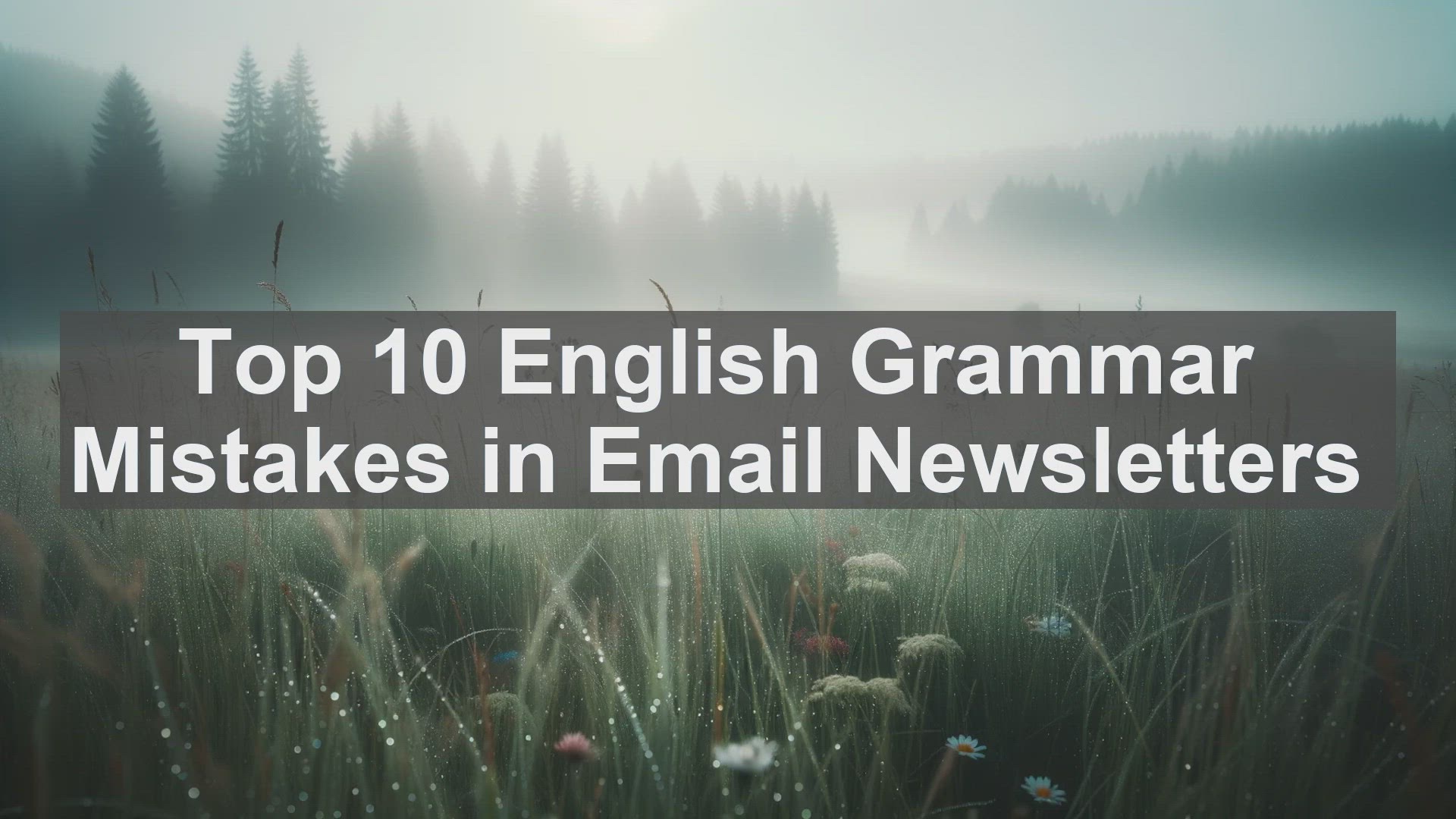
Top 10 English Grammar Mistakes in Email Newsletters
1K views · Nov 15, 2023 englishteststore.net
Top 10 English Grammar Mistakes in Email Newsletters Introduction Hello everyone! Welcome to our channel. Today, we're going to discuss a topic that's crucial for effective communication: English grammar in email newsletters. Let's dive in! 1. Subject-Verb Agreement One common mistake is when the subject and verb don't agree in number. For example, 'The team are' instead of 'The team is.' Remember, a singular subject needs a singular verb, and vice versa. 2. Misplaced Modifiers Modifiers should be placed near the word they describe. For instance, 'Having finished the project, the report was submitted' can be confusing. Instead, write 'Having finished the project, they submitted the report.' 3. Pronoun Usage Pronouns like 'it,' 'he,' or 'she' should have clear antecedents. Avoid using pronouns without introducing the noun they refer to. This prevents ambiguity in your writing. 4. Comma Splices A comma splice occurs when two independent clauses are joined by a comma alone. For example, 'I love writing, it's my passion.' Use a coordinating conjunction or a semicolon instead. 5. Apostrophe Misuse Apostrophes are used for contractions or to show possession. 'Its' is possessive, while 'it's' is a contraction of 'it is.' Be careful not to confuse the two. 6. Run-On Sentences A run-on sentence is when two or more independent clauses are joined without proper punctuation. Break them into separate sentences or use conjunctions to connect them. 7. Lack of Parallel Structure Parallel structure ensures that similar ideas are presented in a consistent manner. For example, 'She likes hiking, swimming, and to read' should be 'She likes hiking, swimming, and reading.' 8. Wordiness In email newsletters, it's important to be concise. Avoid using unnecessary words or phrases that don't add meaning to your message. Keep it clear and to the point. 9. Confusing Homophones Homophones are words that sound the same but have different meanings. Examples include 'their,' 'they're,' and 'there.' Pay attention to their usage to avoid confusion. 10. Lack of Proofreading Always proofread your email newsletters before sending them. Spelling and grammar errors can undermine your credibility. Take the time to review and edit your content. Conclusion That wraps up our discussion on the top 10 English grammar mistakes in email newsletters. By avoiding these errors, you'll enhance your writing and make a better impression. Thanks for watching, and we'll see you in the next video!

Top 10 English Grammar Mistakes in Film Scriptwriting
3K views · Nov 15, 2023 englishteststore.net
Top 10 English Grammar Mistakes in Film Scriptwriting Introduction: The Importance of Grammar in Film Scriptwriting Hello everyone! Welcome to our video on the top 10 English grammar mistakes in film scriptwriting. While creativity and storytelling are crucial, grammar plays an equally vital role. It ensures clarity, coherence, and effective communication. Let's dive into the specifics now. 1. Subject-Verb Agreement One of the most common mistakes is mismatching the subject and verb in a sentence. For example, 'The characters was' instead of 'The characters were.' This error disrupts the flow and can confuse the reader. Always ensure that the subject and verb agree in number. 2. Incorrect Tense Usage Tense consistency is essential for a seamless narrative. Shifting between past, present, and future without a clear reason can confuse the audience. Choose a tense and stick to it, unless there's a deliberate shift in time. 3. Misusing Apostrophes Apostrophes have two primary uses: to indicate possession and to form contractions. However, they're often misused, leading to errors like 'it's' instead of 'its.' Remember, 'it's' is a contraction for 'it is,' while 'its' indicates possession. 4. Confusing Homophones Homophones are words that sound the same but have different meanings. Examples include 'their,' 'they're,' and 'there.' Using the wrong homophone can change the entire context of a sentence. Always double-check the meaning before using them. 5. Lack of Parallel Structure Parallel structure refers to maintaining consistency in sentence construction. When listing items or actions, they should be in the same grammatical form. Mixing structures can create confusion. For instance, 'She likes swimming, to run, and hiking' should be 'She likes swimming, running, and hiking.' 6. Run-on Sentences Long, convoluted sentences can be challenging to follow. Break them down into shorter, more digestible ones. Additionally, ensure that each sentence conveys a complete thought. Run-on sentences can make the script appear unpolished. 7. Lack of Punctuation Punctuation marks like commas, periods, and question marks provide structure and clarity. Neglecting them can result in confusion. Take the time to punctuate your script correctly, ensuring that each sentence is properly demarcated. 8. Inconsistent Capitalization Capitalization rules can be tricky, but consistency is key. For example, if you're capitalizing character names, ensure you do so consistently throughout the script. Inconsistencies can make the script appear unprofessional. 9. Overusing Passive Voice While passive voice has its place, excessive use can make the script feel dull and detached. Active voice, on the other hand, is more engaging and dynamic. Strive for a balance, using passive voice sparingly and purposefully. 10. Neglecting Proofreading Finally, always proofread your script before submitting it. Typos, spelling errors, and other small mistakes can detract from the overall quality. A well-polished script demonstrates your professionalism and attention to detail. Conclusion: Mastering Grammar for Exceptional Scripts Grammar may seem like a technical aspect, but it's a vital tool for any screenwriter. By mastering grammar, you enhance your storytelling abilities, ensuring that your vision is effectively conveyed. So, as you embark on your scriptwriting journey, remember the significance of grammar. Happy writing!

Top 10 English Grammar Mistakes in News Articles
19K views · Nov 15, 2023 englishteststore.net
Top 10 English Grammar Mistakes in News Articles Introduction Hello everyone! Welcome back to our English grammar series. Today, we have an interesting topic to discuss - the top 10 grammar mistakes often seen in news articles. News articles are a vital source of information, but even professional journalists can make errors. By learning about these mistakes, you'll be better equipped to spot them and write more accurately. So, let's get started! 1. Subject-Verb Agreement One of the most common grammar mistakes in news articles is subject-verb agreement. This occurs when the subject and verb in a sentence don't match in terms of number. For example, 'The government have' instead of 'The government has.' Remember, a singular subject requires a singular verb, while a plural subject needs a plural verb. This mistake can affect the clarity and credibility of the article. 2. Misplaced Modifiers Misplaced modifiers can lead to confusion in news articles. These are words or phrases that describe or provide additional information about a subject but are not placed correctly in the sentence. For instance, 'Running down the street, the car hit a lamppost.' Here, it seems like the car was running, not the person. To avoid such errors, ensure that the modifier is placed close to the word it describes. 3. Lack of Parallelism Parallelism refers to using the same grammatical structure for similar ideas within a sentence or paragraph. In news articles, lack of parallelism can make the writing appear disjointed. For example, 'The company aims to increase sales, customer satisfaction, and to improve the work environment.' Instead, it should be 'The company aims to increase sales, improve customer satisfaction, and enhance the work environment.' Consistency is key! 4. Run-on Sentences News articles often contain long, run-on sentences that can confuse readers. A run-on sentence is when two or more independent clauses are joined without proper punctuation. To fix this, you can either use a period to create separate sentences or a coordinating conjunction like 'and' or 'but' with a comma. Breaking down complex sentences into shorter ones can enhance readability. 5. Incorrect Pronoun Usage Pronouns can be tricky, especially when it comes to their antecedents. An antecedent is the noun that a pronoun refers to. In news articles, using the wrong pronoun or not being clear about the antecedent can lead to confusion. For example, 'The politician said they would implement the policy.' Here, 'they' is unclear. It's better to rephrase the sentence or use the person's name. 6. Lack of Consistency in Verb Tenses Maintaining consistency in verb tenses is crucial in news articles. Switching between past, present, and future tenses without a clear reason can make the writing confusing. It's essential to choose the appropriate tense based on the context and stick to it throughout the article. If there's a need to change the tense, ensure it's done logically and consistently. 7. Overuse of Passive Voice While passive voice has its place in news articles, overusing it can make the writing dull and less engaging. Passive voice often lacks clarity and can hide the doer of the action. Active voice, on the other hand, is more direct and engaging. Strive for a balance, but whenever possible, opt for active voice to make your writing more dynamic. 8. Lack of Consistency in Capitalization Capitalization rules can be complex, but consistency is key. In news articles, it's essential to follow the appropriate capitalization rules for titles, names, and specific terms. For example, 'The President said' should have 'President' capitalized. Inconsistency in capitalization can make the article appear unprofessional. Double-checking the rules can help avoid this mistake. 9. Confusing Homophones Homophones are words that sound the same but have different meanings. Confusing homophones can lead to embarrassing errors in news articles. For instance, 'They're investigating the crime scene' instead of 'Their investigating the crime scene.' Proofreading and using tools like spell check can help catch such mistakes. When in doubt, consult a dictionary. 10. Lack of Proofreading Last but not least, the absence of thorough proofreading can result in various grammar mistakes in news articles. Even the most skilled writers can overlook errors in their initial drafts. Taking the time to review and edit the article can significantly improve its quality. It's also helpful to have someone else read it for a fresh perspective. Conclusion That brings us to the end of our discussion on the top 10 grammar mistakes in news articles. By being aware of these errors and actively working to avoid them, you can enhance the clarity, professionalism, and impact of your writing. Remember, good grammar is not just about following rules; it's about effectively conveying your message. Thank you for watching, and see you in the next video!

Top 10 English Grammar Mistakes in Sports Journalism
1K views · Nov 15, 2023 englishteststore.net
Top 10 English Grammar Mistakes in Sports Journalism Introduction: The Importance of Grammar in Sports Journalism Hello everyone, and welcome to our video on the top 10 English grammar mistakes in sports journalism. While the focus of this field is undoubtedly on the game, the way it is written about is equally crucial. A well-written sports article not only informs but also engages the reader. And to achieve that, a solid grasp of grammar is essential. So, let's get started! 1. Subject-Verb Agreement: A Common Pitfall One of the most prevalent grammar mistakes in sports journalism is subject-verb agreement. For example, using 'team' as a plural noun, when it should be treated as a singular entity. This error can disrupt the flow of the article and confuse the reader. Remember, a singular subject requires a singular verb, and vice versa. 2. Misplaced Modifiers: The Importance of Clarity Misplaced modifiers can lead to ambiguity in sports articles. Consider this example: 'After scoring the winning goal, the coach praised the player.' While it's clear to us that the player scored the goal, the sentence structure suggests that the coach did. To avoid such confusion, it's crucial to place modifiers right next to the words they describe. 3. Pronoun Antecedent Agreement: Maintaining Consistency Pronouns are a valuable tool in writing, but their misuse can create confusion. In sports journalism, it's common to refer to a team as 'it' rather than 'they.' However, consistency is key. If you start with 'the team,' stick to 'it' throughout the article. Mixing pronouns can make the writing disjointed and hard to follow. 4. Run-On Sentences: Breaking the Flow Sports articles are often fast-paced, mirroring the action on the field. However, this shouldn't translate to long, convoluted sentences. Run-on sentences can confuse the reader and make the writing feel disjointed. It's important to break down complex thoughts into smaller, more digestible sentences. 5. Lack of Parallel Structure: Aesthetic and Logical Appeal Parallel structure refers to the consistent use of grammatical patterns in a sentence. In sports journalism, this is often seen in lists or comparisons. For example, 'The team needs to focus on scoring, defending, and to communicate effectively.' Here, the use of 'to' before 'communicate' breaks the parallel structure. Revising it to 'to communicate effectively' ensures both aesthetic and logical appeal. 6. Apostrophe Misuse: A Common Oversight Apostrophes are often misused in sports journalism. One common mistake is using them to form plurals, such as 'the player's performed well.' The correct form would be 'the players performed well.' Apostrophes should be reserved for possessives or contractions, not for indicating plurals. 7. Comma Splices: A Punctuation Blunder Comma splices occur when two independent clauses are joined by a comma alone. For example, 'The match was intense, it went into overtime.' Here, a comma isn't enough to connect the two clauses. Using a coordinating conjunction like 'and' or 'but' or separating them into two sentences would be the correct approach. 8. Dangling Participles: A Structural Error Dangling participles can make a sentence sound awkward and confusing. Consider this example: 'Running across the field, the ball was kicked.' Here, it seems like the ball was doing the running. To rectify this, the sentence can be rewritten as 'While running across the field, the player kicked the ball.' 9. Redundancy: Saying More with Less In sports journalism, where brevity is often valued, redundancy can be a hindrance. Phrases like 'final outcome,' 'past history,' or 'future plans' can be condensed to 'outcome,' 'history,' and 'plans' respectively. Removing redundant words not only improves the flow but also makes the writing more concise. 10. Inconsistent Verb Tenses: Maintaining the Timeline Sports articles often involve recounting events, and maintaining a consistent timeline is crucial. Shifting between past, present, and future tenses without a clear reason can confuse the reader. It's important to choose a tense and stick to it, ensuring a smooth and coherent narrative. Conclusion: The Power of Polished Writing In the world of sports journalism, where every second counts, a well-written article can make all the difference. By avoiding these common grammar mistakes, you not only enhance your credibility as a writer but also ensure that your message reaches the reader clearly and effectively. So, keep these tips in mind, and happy writing!

Top 10 English Grammar Mistakes in Technical Manuals
5K views · Nov 15, 2023 englishteststore.net
Top 10 English Grammar Mistakes in Technical Manuals Introduction: The Importance of Grammar in Technical Manuals Hello everyone! Welcome to today's video on the top 10 English grammar mistakes in technical manuals. While the content of a manual is essential, its clarity and coherence rely heavily on proper grammar. Let's explore the most common errors and how to avoid them. 1. Subject-Verb Agreement One of the most prevalent mistakes is incorrect subject-verb agreement. For example, using a singular verb with a plural subject or vice versa. To avoid this, always ensure that the verb matches the number of the subject. 2. Misplaced Modifiers Misplaced modifiers can lead to confusion in technical manuals. These are words or phrases that are not positioned correctly in relation to the word they are modifying. Always place modifiers close to the words they describe to avoid ambiguity. 3. Run-on Sentences Run-on sentences, without proper punctuation or conjunctions, can make a manual difficult to read. To fix this, break long sentences into shorter ones or use appropriate punctuation to separate ideas. 4. Lack of Parallelism Parallelism refers to using the same grammatical structure for similar ideas. In technical manuals, this is crucial for clarity and consistency. Always ensure that items in a list or series follow a parallel structure. 5. Inconsistent Tenses Switching between tenses without a clear reason can confuse readers. When writing a technical manual, stick to one tense unless there's a specific need to change. Consistency is key. 6. Incorrect Pronoun Usage Pronouns should agree in number and gender with the nouns they replace. Using the wrong pronoun can lead to ambiguity or even miscommunication. Always double-check pronoun usage in your manual. 7. Lack of Clear Antecedents An antecedent is the noun that a pronoun refers to. If the antecedent is not clear, it can create confusion. Make sure the noun that the pronoun replaces is explicitly mentioned in the manual. 8. Overuse of Technical Jargon While technical jargon is necessary in manuals, overusing it can alienate readers. Strike a balance by using simple language wherever possible and providing explanations for complex terms. 9. Incorrect Capitalization Improper capitalization can make a manual look unprofessional. Always capitalize proper nouns, the first word of a sentence, and titles. Be cautious with acronyms as well. 10. Lack of Consistent Formatting Consistent formatting is crucial for a professional-looking manual. Ensure that headings, subheadings, bullet points, and other formatting elements are used consistently throughout the document. Conclusion: Mastering Grammar for Effective Manuals By avoiding these common grammar mistakes, you can enhance the clarity and impact of your technical manuals. Remember, clear and concise communication is key in any field. Thank you for watching, and we'll see you in the next video!

Top 10 English Grammar Mistakes in Television Scriptwriting
750 views · Nov 15, 2023 englishteststore.net
Top 10 English Grammar Mistakes in Television Scriptwriting Introduction Hello everyone! Welcome to our channel. Today, we have an interesting topic for all the aspiring scriptwriters out there. We'll be discussing the top 10 English grammar mistakes that often make their way into television scripts. So, let's dive right in! 1. Subject-Verb Agreement One of the most common mistakes is the lack of agreement between the subject and the verb. For example, using a singular verb with a plural subject or vice versa. This can disrupt the flow of the script and confuse the audience. It's important to ensure that the verb matches the subject in number and person. 2. Misplaced Modifiers Modifiers, such as adjectives and adverbs, need to be placed correctly in a sentence to convey the intended meaning. Placing them in the wrong position can lead to ambiguity or alter the intended message. It's crucial to double-check the placement of modifiers to avoid any confusion. 3. Pronoun Usage Pronouns are meant to replace nouns, but their usage can be tricky. One common mistake is using the wrong pronoun case, such as 'I' instead of 'me' or 'she' instead of 'her'. Another issue is unclear antecedents, where it's not clear which noun the pronoun is referring to. Clarity is key when it comes to pronoun usage. 4. Run-on Sentences Long, uninterrupted sentences without proper punctuation can make the script difficult to follow. It's important to break down lengthy sentences into shorter ones, using appropriate punctuation marks like commas and periods. This helps in maintaining a smooth flow and preventing any confusion. 5. Comma Splices Commas are often misused, especially when it comes to joining two independent clauses. This results in what's known as a comma splice. Instead of a comma, a coordinating conjunction or a semicolon should be used to connect two complete thoughts. 6. Lack of Parallelism Parallelism refers to using similar grammatical structures for similar ideas within a sentence. When there's a lack of parallelism, the sentence can sound awkward or unclear. It's important to ensure consistency in structure when listing items or expressing ideas. 7. Incorrect Tense Usage The choice of tense is crucial in scriptwriting, as it determines the timeline of events. Mixing up tenses or using an incorrect tense can confuse the audience. It's essential to be consistent with the chosen tense throughout the script, unless there's a deliberate shift in time. 8. Double Negatives A double negative, where two negative words are used in a sentence, can create confusion. Instead of intensifying the negation, it can result in a positive or unclear meaning. It's important to use a single negative to convey the intended message clearly. 9. Wordiness Scripts should be concise and to the point. Using excessive words or phrases can make the dialogue sound bloated. It's important to trim down the script, removing any unnecessary words while still conveying the intended meaning effectively. 10. Inconsistent Capitalization Consistency in capitalization is essential for a professional-looking script. Randomly capitalizing words or not capitalizing proper nouns can make the script appear unpolished. It's important to follow the standard rules of capitalization throughout the script. Conclusion And that brings us to the end of our discussion on the top 10 English grammar mistakes in television scriptwriting. By being aware of these common errors, you can ensure that your scripts are well-crafted and grammatically sound. Thank you for watching, and we'll see you in the next video!

Top 10 English Grammar Rules for Academic Journalists
412 views · Nov 18, 2023 englishteststore.net
Top 10 English Grammar Rules for Academic Journalists Introduction: The Importance of Grammar in Academic Writing Hello everyone! Welcome to today's video, where we'll be diving into the world of English grammar. As academic journalists, our writing serves as a medium to convey information, and grammar plays a crucial role in ensuring clarity and precision. A well-structured sentence, with proper punctuation and verb usage, can make all the difference in how our work is perceived. So, let's get started with the top 10 grammar rules that will elevate your writing to the next level! 1. Subject-Verb Agreement: The Foundation of a Sentence Every sentence consists of a subject and a verb. It's essential that these two elements agree in number. For example, if the subject is singular, the verb should be singular as well. This rule might seem straightforward, but it's a common pitfall. A simple way to ensure agreement is to identify the subject and ask yourself, 'Is it singular or plural?' Then, choose the corresponding verb form. This consistency enhances the flow of your writing and prevents confusion. 2. The Oxford Comma: A Small Mark with Big Implications The Oxford comma, also known as the serial comma, is the comma used before the conjunction in a list of three or more items. Its usage is a matter of debate, but in academic writing, it's generally preferred. Why? Because it adds clarity. Consider this example: 'The study included professors, researchers, and students.' Without the Oxford comma, it could be interpreted as 'professors who are researchers' and 'students who are researchers.' The comma eliminates this ambiguity, ensuring that each item is distinct. 3. Active Voice: Conveying Directness and Clarity Active voice is when the subject of a sentence performs the action. It's the preferred choice in academic writing as it adds directness and clarity. Passive voice, on the other hand, can make a sentence sound vague or impersonal. For example, 'The researchers conducted the study' (active) is more concise and engaging than 'The study was conducted by the researchers' (passive). By using active voice, you not only communicate your point effectively but also make your writing more dynamic. 4. Proper Use of Articles: A, An, and The Articles are small words, but their correct usage is crucial. 'A' and 'an' are indefinite articles, used when referring to something in a non-specific manner. 'The' is the definite article, used when referring to something specific. The choice between 'a' and 'an' depends on the sound that follows. For example, 'a university' and 'an hour.' Using articles correctly not only enhances the grammatical accuracy of your writing but also adds precision to your descriptions. 5. Consistent Tense: Maintaining a Time Frame When writing, it's important to maintain a consistent tense unless there's a deliberate shift. Mixing tenses can confuse the reader and disrupt the flow. For example, 'The study found' (past tense) and 'The researchers argue' (present tense) in the same paragraph can be jarring. By choosing a specific tense and sticking to it, you create a coherent narrative and make it easier for the reader to follow your ideas. 6. Sentence Structure: Balancing Complexity and Clarity Academic writing often involves complex ideas, but that doesn't mean the sentences should be convoluted. A well-structured sentence strikes a balance between complexity and clarity. One way to achieve this is by using subordination and coordination effectively. Subordination involves using dependent clauses to provide additional information, while coordination connects equal ideas. By mastering these techniques, you can create sentences that are both sophisticated and easy to understand. 7. Consistent Pronoun Usage: Avoiding Confusion Pronouns are handy tools for avoiding repetition, but their usage should be consistent. If you start with a specific noun, subsequent references should use the corresponding pronoun. For example, 'The author conducted the study. He presented the findings.' Here, 'he' refers back to 'author.' Inconsistent pronoun usage can confuse the reader and make the writing disjointed. By ensuring consistency, you maintain a smooth flow and facilitate comprehension. 8. Parallel Structure: Creating Balance in Lists When listing items or actions, it's important to maintain parallel structure. This means using the same grammatical form for each element. For example, 'The study aims to inform, educate, and inspire' (parallel) is more effective than 'The study aims to inform, educating, and inspiration' (non-parallel). Parallel structure not only adds symmetry to your writing but also makes it easier to process and remember the information. 9. Appropriate Use of Punctuation: Enhancing Clarity Punctuation marks, such as commas, semicolons, and dashes, serve as signposts in your writing, guiding the reader and indicating the relationships between different elements. Using them correctly is essential for clarity. For example, a comma can indicate a pause or separate items in a list, while a semicolon can connect two related but independent clauses. By mastering the rules of punctuation, you ensure that your writing is not only grammatically correct but also easy to follow. 10. Proofreading: The Final Step for Polished Writing No matter how well-versed you are in grammar, errors can still slip through. That's why proofreading is crucial. After completing your draft, take the time to review it carefully. Look for spelling mistakes, punctuation errors, and any inconsistencies in grammar or style. Reading the text aloud can also help you identify awkward phrasing or unclear sentences. By dedicating time to proofreading, you demonstrate your commitment to producing high-quality work. Conclusion: Mastering Grammar for Effective Communication And that brings us to the end of our top 10 grammar rules for academic journalists. By understanding and applying these rules, you'll not only enhance the quality of your writing but also establish yourself as a credible and effective communicator. Remember, grammar is not just about correctness; it's about clarity, precision, and impact. So, keep practicing, keep refining, and watch your writing skills soar. Thank you for joining us today, and we'll see you in the next video!
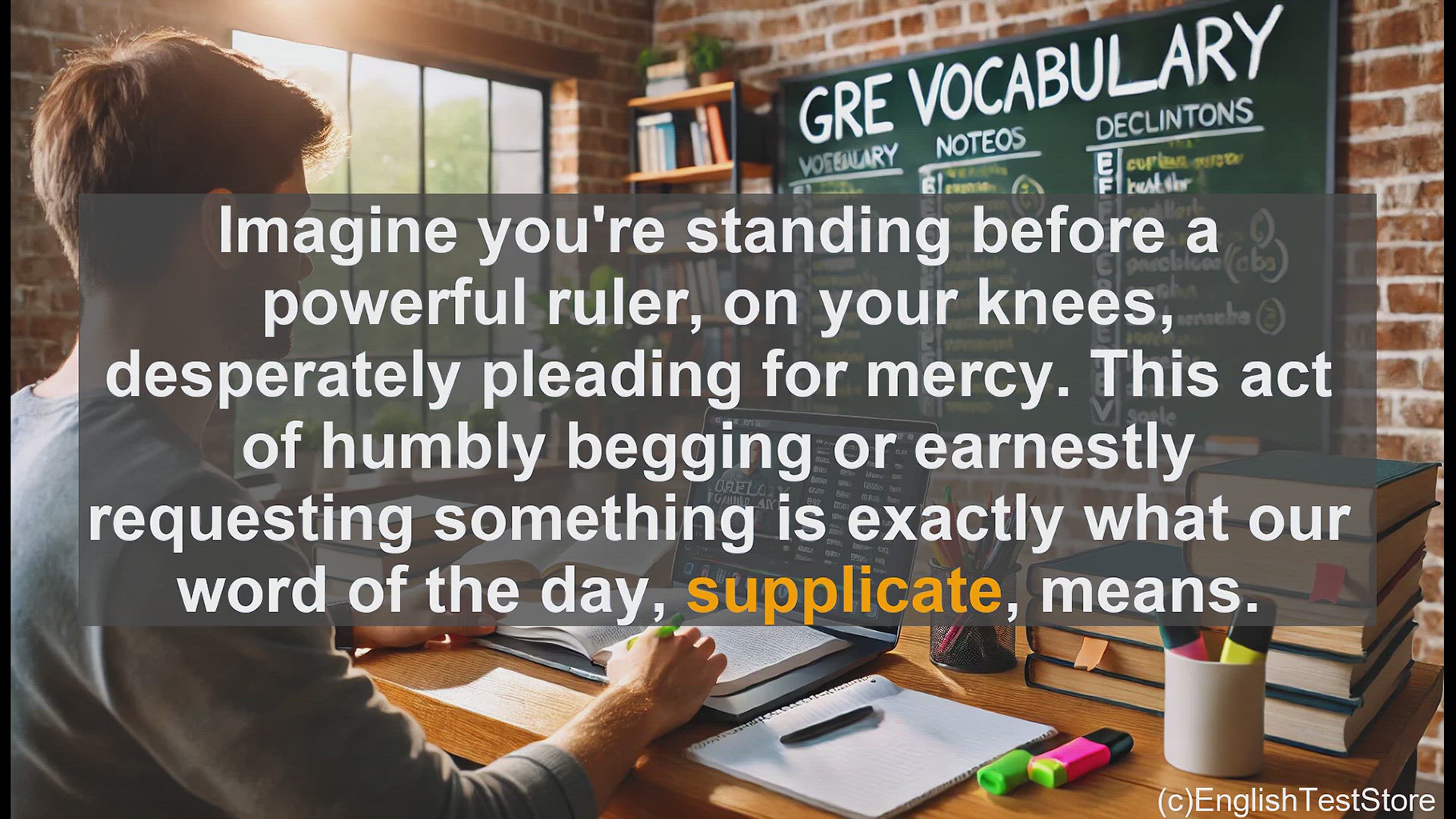
GRE Vocabulary Lesson: Supplicate - The Art of Humble Pleadi...
112 views · Oct 17, 2024 englishteststore.net
Explore the meaning and usage of 'supplicate', a powerful verb that describes earnest, humble requests. Learn its etymology, synonyms, antonyms, and common usage errors to enhance your vocabulary for the GRE and beyond.